The Ultimate Guide
to Backcountry Skiing
The Ultimate Guide to Backcountry Skiing and Riding
After each one of our courses at Baker Mountain Guides, we do our best to provide useful resources to our students so they can continue their education and not completely forget all the things they learned from us. There’s a lot of great information out there, but we haven’t found an all-inclusive guide that we can just give to you all. So we made it ourselves, and here it is… The Ultimate Guide to Backcountry Skiing and Riding. Of course, there’s nothing more valuable than hands-on experience. That said, we hope this guide will serve as:
1) A roadmap for those of you just starting your journey into the realm of backcountry touring.
2) A resource for more experienced folks who want to brush up on the latest and greatest.
3) The place where every backcountry skier and snowboarder, regardless of experience level, can go to review the important stuff before and during each winter season.
This is a living document that will continually update as things progress in the industry. Just as we recommend that you re-read Staying Alive in Avalanche Terrain before each season, we hope this becomes a part of your ritual.
How to use this resource
This post is broken down into six sections:
1. Types of Backcountry Skiing (What is possible?)
2. Backcountry Skiing Gear (What do I need?)
3. Backcountry Skiing Skills/Techniques (How do I do it?)
4. Backcountry Skiing Planning Resources (When and Where do I go?)
5. Mountain Ethics (How do I recreate responsibly?)
6. Continuing Education (How do I get better?)
In each of the sections, you’ll find a summary that contains the most important “need to know” components of whatever is being discussed. We’ve also been told that we’re funny, so hopefully, you find the information not just useful, but engaging. If you really want to take a tumble down the rabbit hole of needing to know everything on any topic, we’ve provided links to blogs, videos, and pages that you can spend whole days learning from if you so desire.
As a guide service run by past outdoor educators, we’re big believers in choosing your own adventure, so how you navigate this resource is up to you and your learning preferences. You want the broad summary because you’re new to this game and just want a better understanding of what the big picture looks like? You’ll probably just stay on this main post and not click many links. You’ve been playing this game for years but want to stay up with best practices? You’re probably not even reading this anymore and you’re already on to whatever specific thing you came here to look up. Love it.
Oh, and one last thing. If you don’t see something in this resource that you want to know more about, let us know. We’ll be psyched to answer your questions. Happy learning and shred safe our friends!
XOXO,
The Staff of Baker Mountain Guides
Types of Backcountry Skiing and Riding (What is possible?)
“You’re off to Great Places! Today is your day! Your mountain is waiting, So… get on your way!”
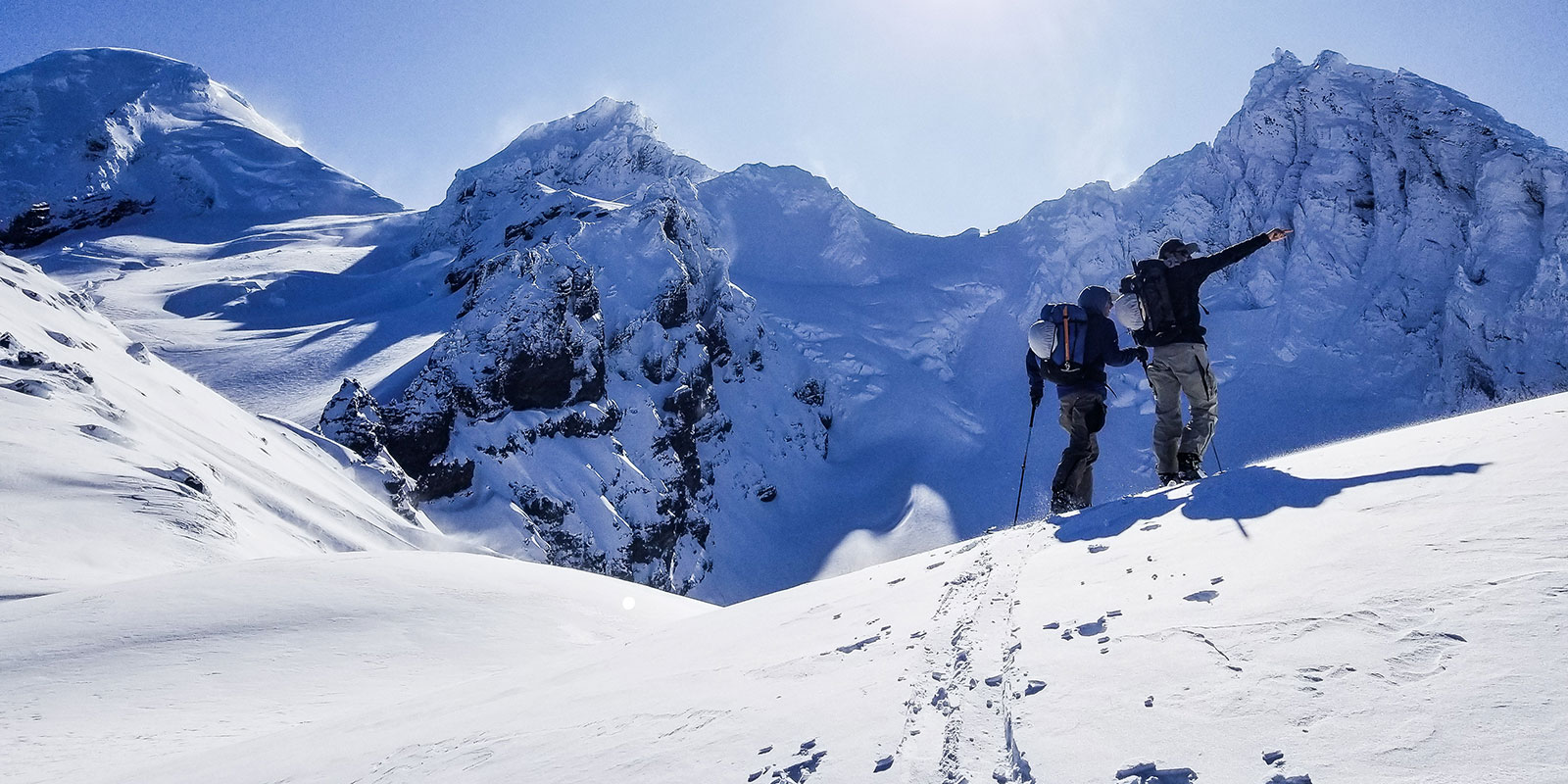
The Places You’ll Go
Generally, there are four different ways to enjoy the backcountry on your skis or snowboard. The fastest-growing sector is backcountry ski/split touring, but there is also ski/split mountaineering in glaciated and unglaciated terrain, ski/split traverses, and mechanized skiing/riding with snowmobiles, snowcats, or helicopters. In this section, we’ll explain what each of these types of backcountry skiing and riding entails, so you can decide what gear and training are most important for you to invest in to fit your goals.
Backcountry Ski Touring | Ski/Split Mountaineering | Ski/Split Traverses | Mechanized Skiing/Riding
Backcountry Ski Touring
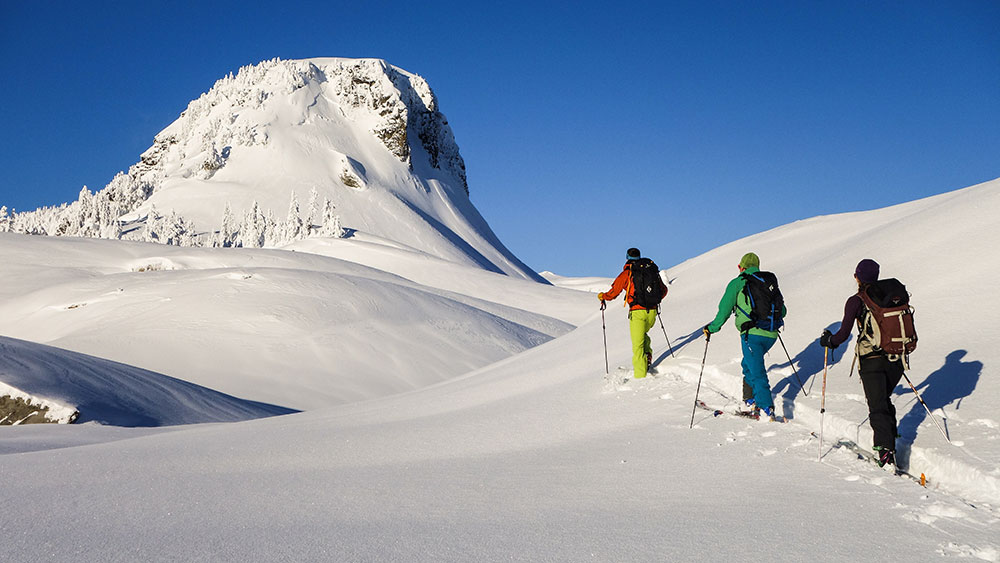
Backcountry ski or splitboard touring is 100% powered by you and your leg muscles (or lack thereof). Touring is typically done off-piste and outside of ski resorts in uncontrolled terrain, but many ski resorts are starting to allow “uphill access” or touring to occur in bounds at certain times and on marked uphill routes.
You can think of touring like the lovechild of Nordic and alpine skiing — it combines elements of both and embraces such sub-disciplines as telemark and randonnée. A defining characteristic is that your heels are free (i.e. not bound to the boards) in order to allow for the boards to slide while traversing and climbing terrain. Then, for downhill, you can lock your heels down as a skier, or put your board back together as a snowboarder.
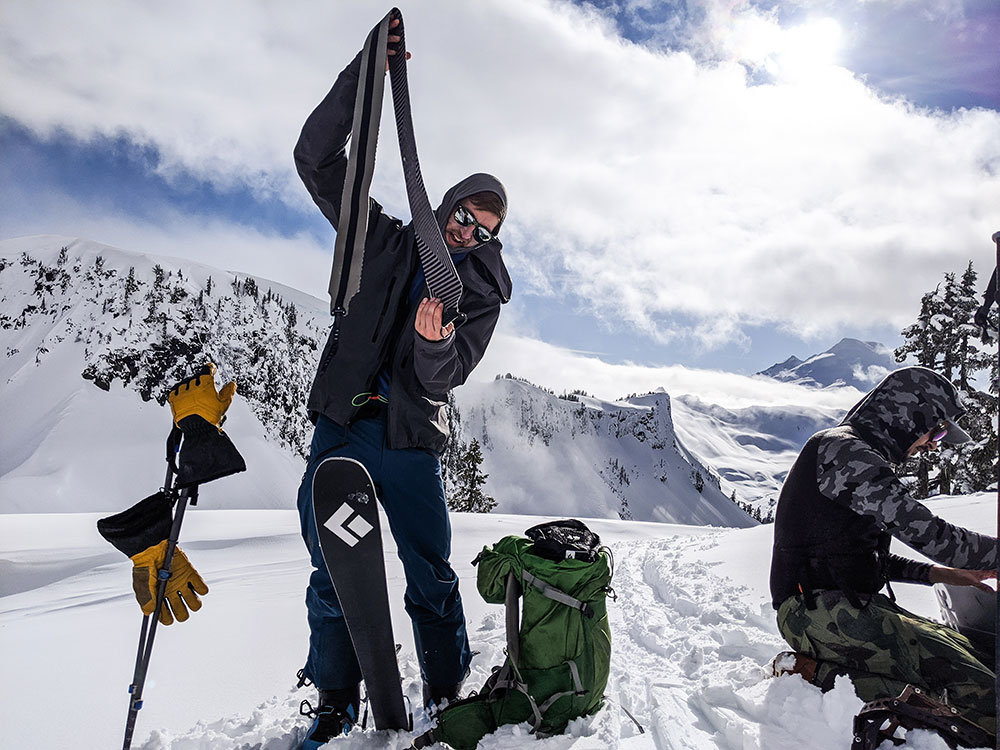
The popularity of backcountry ski and splitboard touring has exploded the last decade. Riders seeking new snow and fewer crowds, alpinists tired of approaching in snowshoes, and folks wishing to avoid paying for lifts at resorts all add to the popularity. There are barriers to entry into the sport, however. As you’ve probably noted, the initial price tag for entry is pretty spendy. Even if you’re buying most things used, you’ll probably spend between $1,000 and $2,500 for all the essential gear. Touring, similar to hiking and backpacking, also requires independent navigation skills and usually involves route-finding through potential avalanche terrain.
Ski Mountaineering
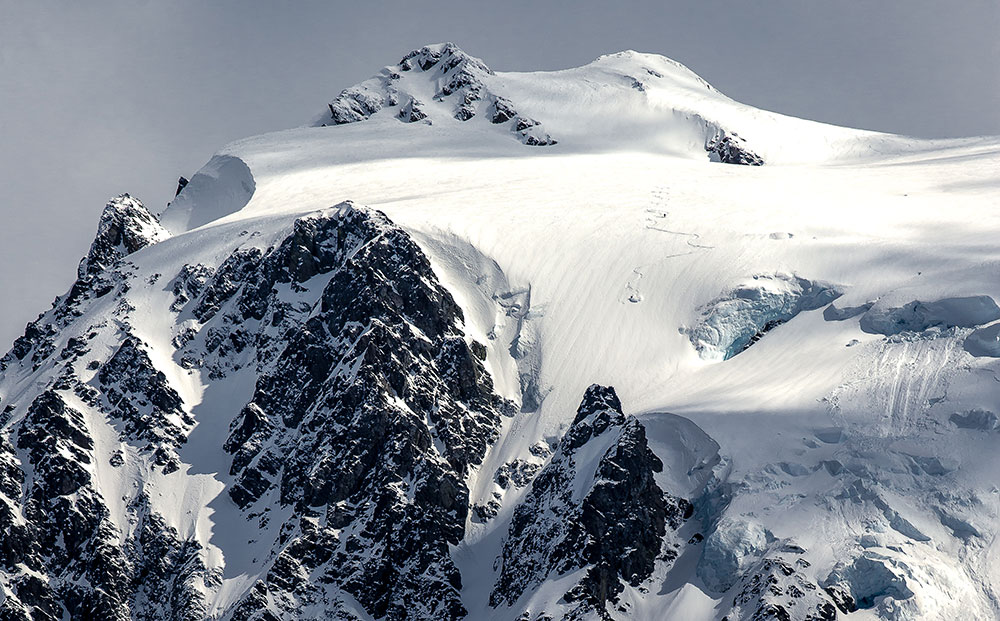
If backcountry touring is the lovechild of nordic and alpine skiing, then ski and splitboard mountaineering is the lovechild of backcountry touring and climbing. By adding mountaineering to the equation, the skill set required for success expands to include more technical expertise — especially if you plan to ski in glaciated terrain where knowledge of crevasse rescue is critical. However, ski and splitboard mountaineering may not necessarily involve the use of ropes. There’s no definitive point at which you cross over from backcountry touring to ski and splitboard mountaineering, but typically ski and splitboard mountaineering is objective-based (i.e. The gnar-gnar line on Mt. Sicky Sick), AND the objective requires a broader skill set as well as a deeper level of mountain sense.
If you’re a backcountry skier or splitboarder wanting to break into the world of ski mountaineering, then you should probably start with the mountaineering side of things. You’re going to need to be as comfortable off of your skis or board as you are on them – in any kind of terrain. There are a few pieces of mountaineering equipment that you’re going to need, such as a rope, harness, ice-ax, crampons, and climbing helmet. But even more important is acquiring a climbing skill set. Learn how to tie knots. Go to the climbing gym to develop balance and movement skills. Get super fit. Practice crevasse rescue. Take a navigation course. Most importantly, find a mentor. At Baker Mountain Guides, we like to say that ski mountaineering is just good ol’ fashioned mountaineering with the added benefit of skis. You have to learn to love the up.
Ski Traverses
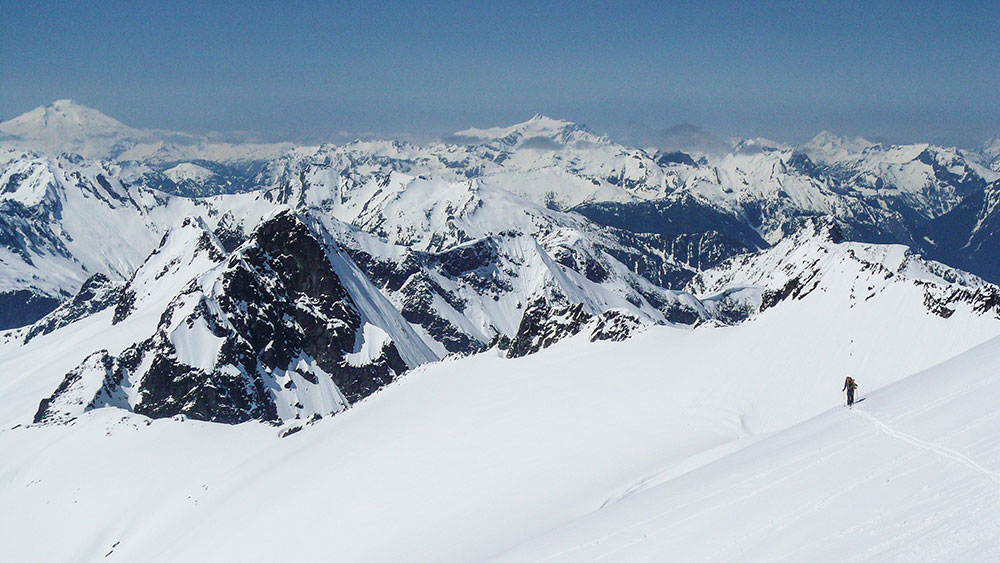
Traverses usually involve ski mountaineering if the traverse occurs in mountainous terrain. However, ski traverse are unique enough that they have earned the right to be their own category of backcountry skiing. Where for backcountry touring you usually start and end at the same place, traverses take you longer distances across ranges and take multiple days to complete. Traverses like the Haute Route or Spearhead Traverse are incredibly popular for not just their beauty, but the ease of access with well-maintained hut systems. In the Cascades, without the luxury of maintained huts, traverses are much more rugged as you must establish and breakdown your camp scene each day. The North Cascades are a never-ending backcountry rider’s paradise and have quite a few classic ski traverses to choose from.
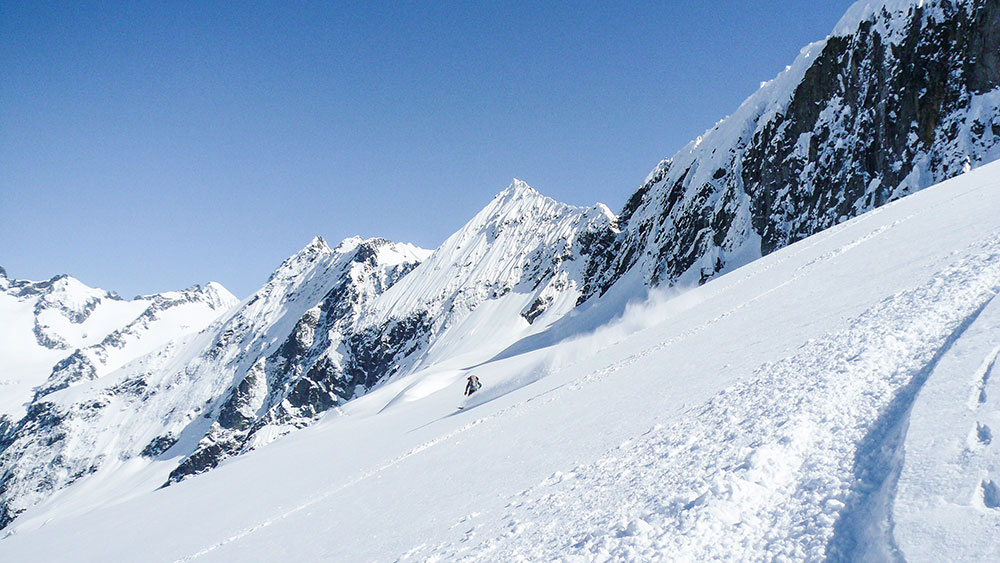
Ski traverses could be a big, one-day endeavor, or a multi-month undertaking. Ski traverses are an excellent way to access terrain that would otherwise be too remote to ski or ride. They are also just a great way to see the world. One of the most ambitious ski traverses ever completed (for the sake of ski traversing) is the complete Coast Range Traverse from Squamish, BC to Skagway, AK. The Coast Range Traverse is 1429 miles and takes about 6 months. First done under the radar by a core group of friends back in the early 2000’s, The Coast Range Traverse was recently repeated by a mother-daughter team in 2017.
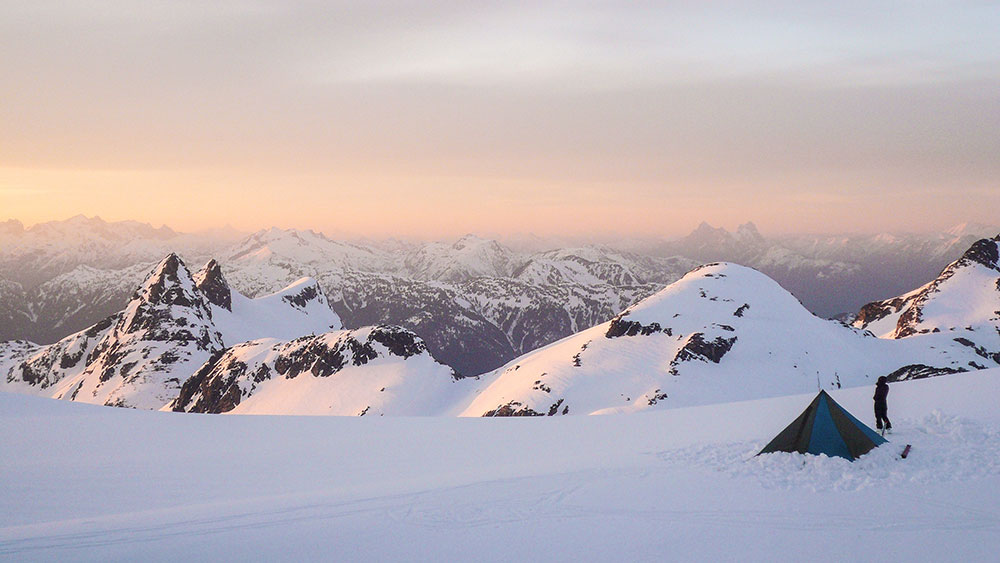
As you can see, it’s hard to pigeon-hole something like the Coast Range Traverse into the category of “backcountry skiing” or even “ski mountaineering.” “Re-wilding of Homo Sapiens” might be a better definition. Long ski traverses have less to do with skiing and riding and more about reconnecting with mother nature’s colder parts of the world. The knowledge, intuition, experience, and tenacity to complete such an undertaking require a lifetime to develop.
Mechanized Skiing and Riding
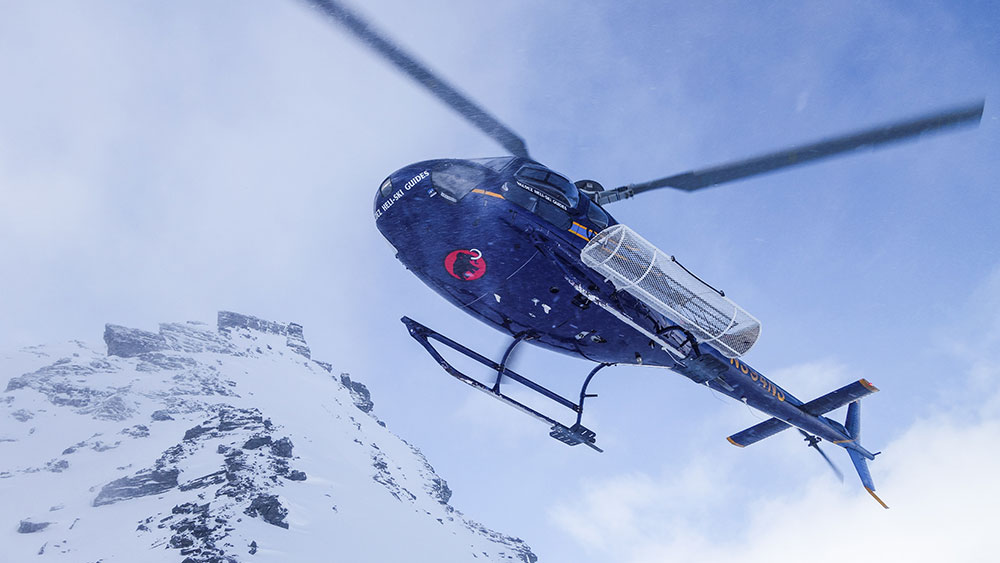
Mechanized backcountry skiing and riding refers to any skiing/riding aided by machines on the uphill. Essentially the opposite of touring, but still considered to be backcountry because it occurs in uncontrolled avalanche terrain. One of the easiest to enjoy for the price is riding lifts/trams in order to access “sidecountry” like the Shuksan Arm at the Mt. Baker Ski Area. When sidecountry skiing, keep in mind that you are still in the backcountry and subject to backcountry hazards, regardless of how close you are to the ski area boundary. Even closed runs within the ski area should be considered backcountry terrain from an avalanche perspective. Many folks have got themselves killed right outside the rope line. As avalanche educators, we actually hate the word “sidecountry” because it implies that it’s “backcountry lite.” It’s not. We just haven’t come up with a better term.
Beyond riding lifts, mechanized skiing/riding includes utilizing snowmobiles, snowcats, and helicopters to get you into terrain. Mechanized skiing and riding are most often provided by a guide service, considering the cost of purchasing and operating helicopters and snowcats. As such, you’re not going to have to do a lot of the thinking. However, more and more people are using snowmobiles to access the backcountry. Maintaining and riding snowmobiles (or “sleds”) are skillsets in and of themselves. The first time that you use a sled to go backcountry skiing or riding, it’s likely that you’ll spend more time futzing with the sled then you will actually skiing or riding. But like anything else, you’ll eventually get it, and then you can decide how you want to operate. Is the sled a tool for access, or do you actually want to run laps with it? Whatever you decide, just make sure you are recreating in accordance with public land regulations. Motorized equipment isn’t allowed everywhere.
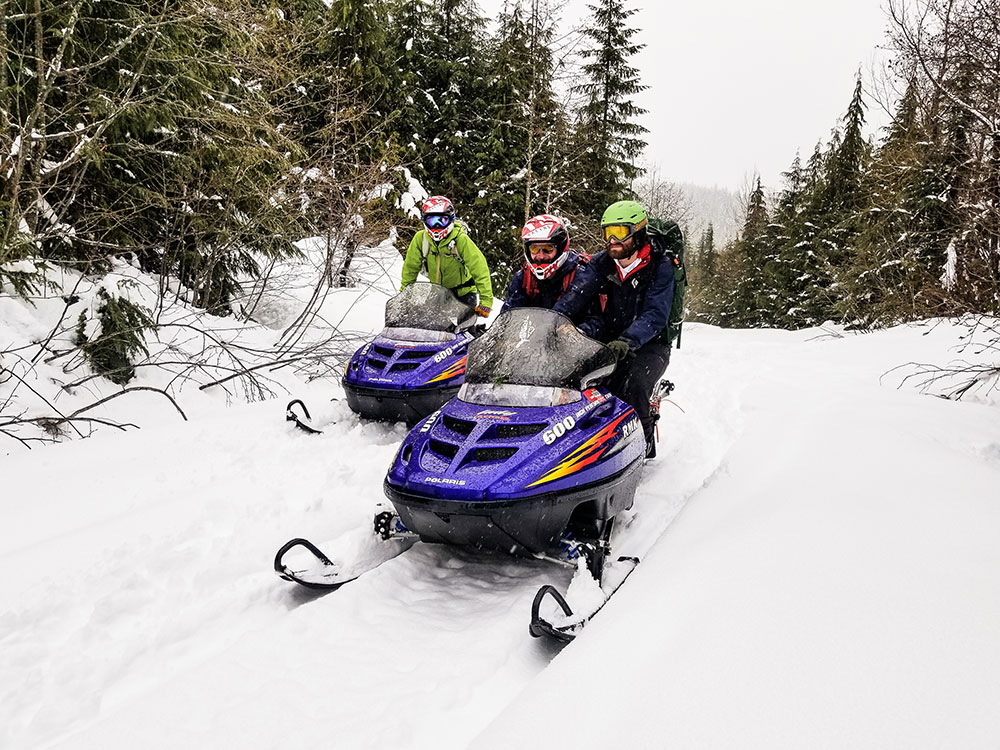
At Baker Mountain Guides, we are big believers in earning your turns. Plus, none of us can afford to ride in helicopters all the time. As such, we have a snowmobile assisted backcountry skiing program where we only use snowmobiles on forest service roads to get to trailheads that would otherwise be inaccessible (or at least a really long walk). Once at trailheads, we ditch the sleds and switch into tour mode.
Backcountry Skiing Gear (What do I need?)
“Anyone who uses the “it’s a poor workman that blames their tools” BS has obviously never tried to walk on ice with flip flops.”
The Essentials
Getting the right gear often elicits a mix of emotions. As humans, we love new shiny things to play with, but we also dread the price tag that sometimes accompanies them. In this section, we’ll delve into the nitty-gritty of some essential and non-essential gear specific to backcountry skiing and riding, what it does, and why it is important to have. Below you’ll find a list of items that includes some commonly overlooked essential items, like a first aid kit and repair kit. If you rip a binding out, will you be able to get out of the backcountry on your own? If you have a good repair kit and know how to use it, we sure think so.
Beacon | Shovel | Probe | AT Skis | AT Ski Bindings | Splitboards | Skins | Ski Crampons | AT Ski Boots | Riding Specific Backpack | Airbag Backpack | Repair Kit | First Aid Kit
Avalanche Beacons
Avalanche beacons, or transceivers, are worn on the body and transmit a radio signal that that other avalanche beacons can hear. Avalanche beacons have two modes: “transmit” and “search,” also known as “send” and “receive.” For the sake of sanity, just pick one set of terms and stick with it. When touring, your avalanche beacon should be set to transmit. If someone in your group is caught and buried in an avalanche, your avalanche beacon can be switched to “search” and will guide you to the victim via distance readings and directional arrows.
For the most part, we’re all for purchasing used gear. As much as you can reduce waste by reusing stuff that still works, the better. Your avalanche beacon, however, is not something to skimp on. The life span of an avalanche beacon is 10 years, but technology is evolving at a rapid rate. Avalanche beacons 5 years old are no match for the power of avalanche beacons today. Furthermore, you don’t know the history of a used avalanche beacon. All too often, folks show up on our avalanche courses with older avalanche beacons they bought used off craigslist from some sketchy character behind a Wal-Mart. Don’t do this. If you’re going to buy anything new, this should be it.
Avalanche beacon manufacturers love to talk about all the fancy bells and whistles their product has. All avalanche beacons pretty much work the same in transmit mode, but huge differences arise in search mode. Some avalanche beacons can tell you how many people are buried and if they’re buried close together. You can even “flag” or ignore certain signals. Some beacons allow you to check the transmit frequency of other beacons. It’s all so much to consider. If you want to make sure you get good avalanche beacon, just buy a new, 3-antenna beacon. Everything else is negotiable.
If you want to know how to test beacons to make sure they are working correctly/perform a function check, look at our blog on how to perform Avalanche Beacon Function Check to learn all the things.
Snow Shovel
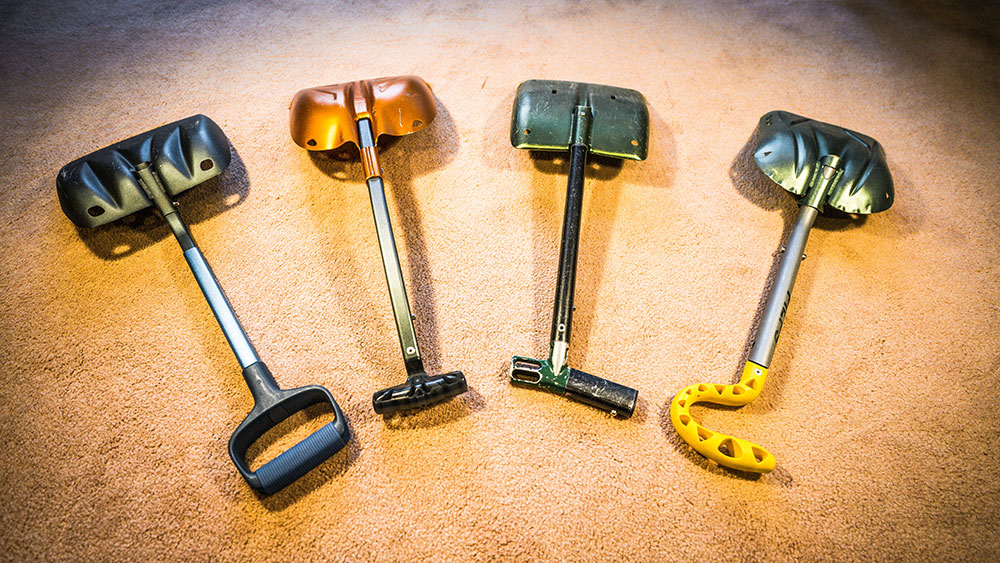
This is one of the most important pieces of gear to have. If you actually need to perform a rescue of a buried victim and you left your snow shovel in the parking lot, good luck moving over a ton of snow set up like concrete with your hands. During a rescue, you’ll spend the majority of your time digging, so get a good one.
Size and Shape
Snow Shovel blades vary greatly in shape and size. Smaller blades are easier to handle but less efficient at chopping and moving large amounts of snow, while larger blades can move more snow but take more strength to operate/may tire you more quickly. If you’re a smaller person, you’ll probably want a smaller snow shovel blade. That is unless you do cross-fit and have big, sexy arms. You can keep shoveling pretty quick with a small snow shovel and that is often more efficient than consistently underfilling a large shovel when you’re tired. Usually, for the everyday human, it’s best to get a medium-sized shovel blade — Think Goldilocks.
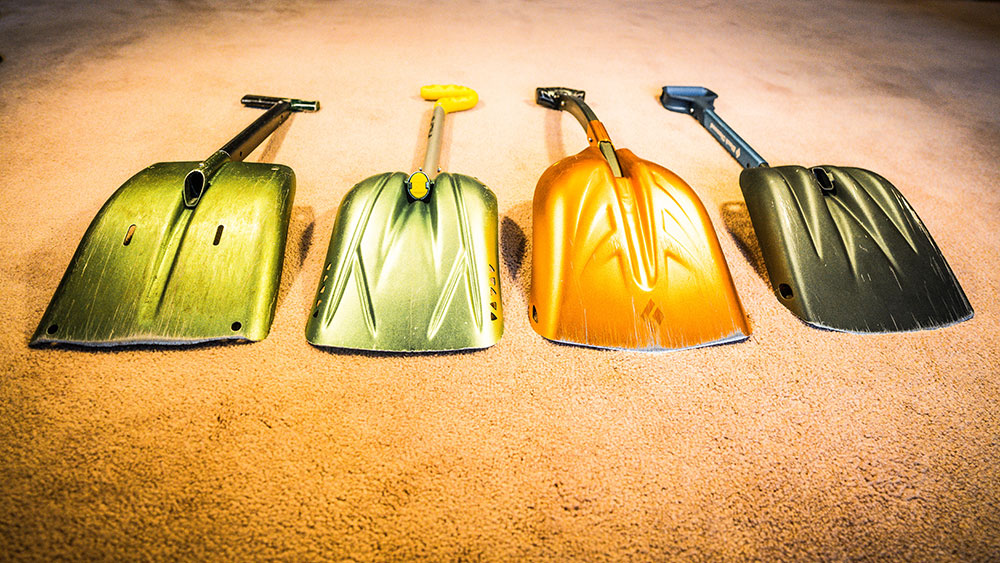
Some snow shovel blades are flat for helping you carve that perfectly smooth pit wall. Unless you’re digging pits all the time for educational purposes, or love to have perfectly sculpted kickers for that footy, we recommend against the flat blade. Instead, get a curved blade. It’s made to move lots of snow more efficiently and some models even have serrated blades that help cut through snow and ice.
Material
Unless you’re into ski mountaineering in your lycra onesie or setting the speed record on Denali, and want a super light plastic shovel because that FKT is way more important than your life, get a metal snow shovel that won’t break as you cut your way through avalanche debris. More specifically, get an aluminum one. Alumunium has the strongest strength to weight ratio.
Shaft and Grip Types
Most snow shovels nowadays have telescoping shafts that give you several different options for length. Longer shafts give you more leverage for digging. If you’re a tall human, longer shafts are a must. Without the added height, hello back pain. Short shafts are more maneuverable in tight spaces (Think person upfront in a rescue scenario). Shafts that are oblong or triangular in cross-section can offer increased rigidity and strength. Check out our blog on Avalanche Rescue: Strategic Shoveling to learn more about how to use your shovel most efficiently.
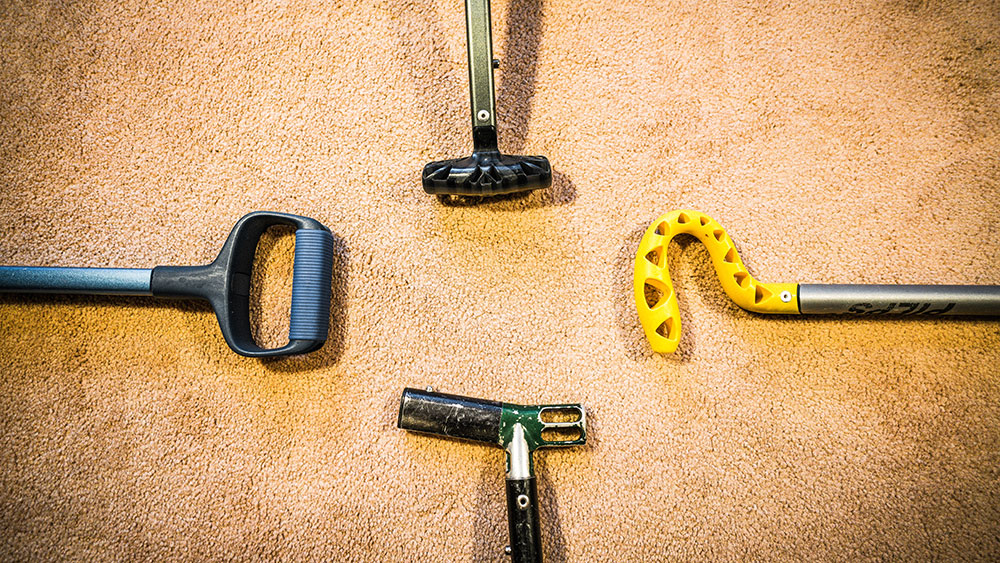
The three most common grip types are T- and L-shaped grips (that are often lighter and more compact) and larger D-shaped grips (that are more comfortable to hold and can be used with mittens. I would say go to a gear shop and touch all the handles until you find the one that fits your hands the best…but COVID. Some snow shovels offer the ability to configure the shovel as a hoe, or, as I like to say: “engage hoe mode”. It’s funny. Hoe mode is great for moving lots of lower density snow quickly and efficiently.
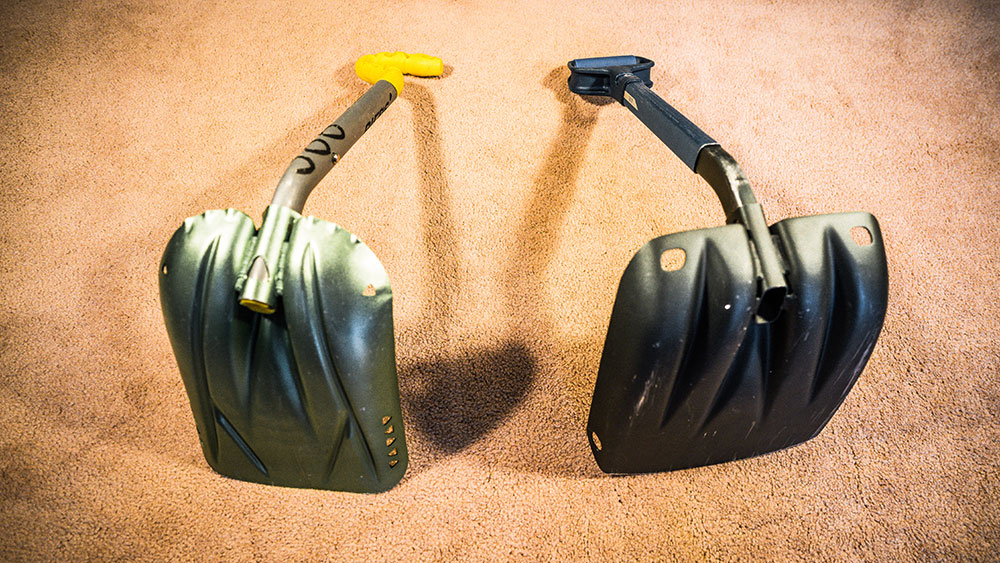
Storage
Store your snow shovel inside your backpack. Blade, shaft, and handle. I (Zack) personally have a collection of three shovel shafts/handles I’ve picked up in the backcountry that have fallen out of people’s backpacks while strapped to the outside. *Side note, if you lost your shovel handle and you want it back, please let me know… they’re just taking up space in my gear room * If you’re losing parts of your shovel just walking around, think about what an avalanche will do to you. Goodbye shovel. Just like how you should wear your beacon underneath a layer in the harness or in a pocket to keep it from separating from you, protect your other essential gear from getting separated from you as well. Snow Shovel won’t fit inside your backpack? Get a riding specific backpack and leave your small pack for summer hiking.
Probe
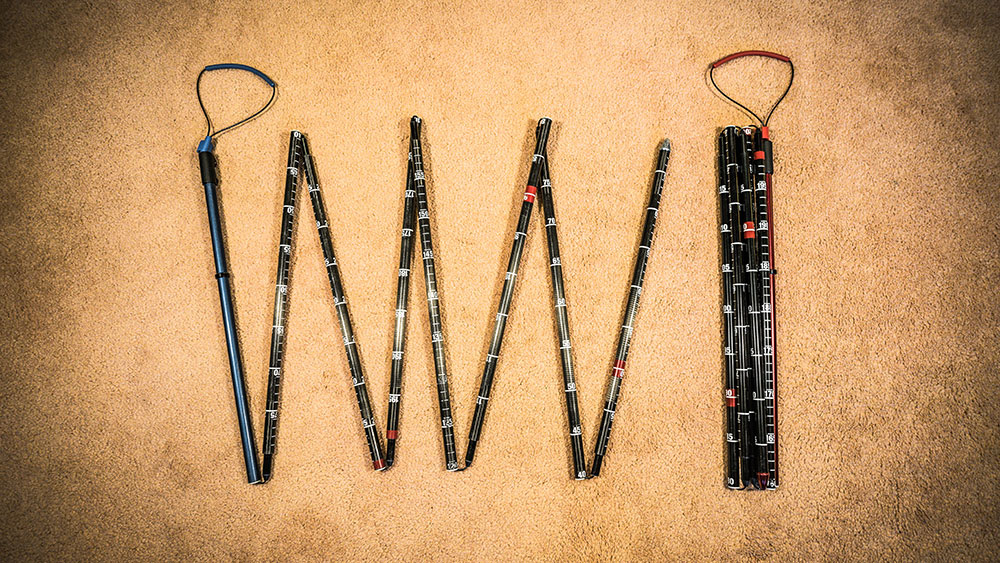
Avalanche probes are your analog complement to your fancy avalanche beacon. They help you pinpoint the exact location of an avalanche victim and measure the burial depth. When time is of the essence in a rescue, knowing exactly where to dig and how much snow you’ll be moving is essential.
Size
No matter what you’ve heard, size matters. If you’ve taken an avalanche awareness course or other avalanche education, you’ll remember that an average avalanche burial is around 1.5 meters. As such, two meters should be a minimum length. Probes on the short end of the spectrum are lighter and pack more easily, so if you’re doing a ski-mo race in your spandex… for sure, get a small probe. If you’re actually wanting it for the purpose it was designed for, get one somewhere between 240 and 320cms. Longer probes are also easier on your back, (especially if you ever have to work a probe line) and tend to be made of heavier gauge and more durable material.
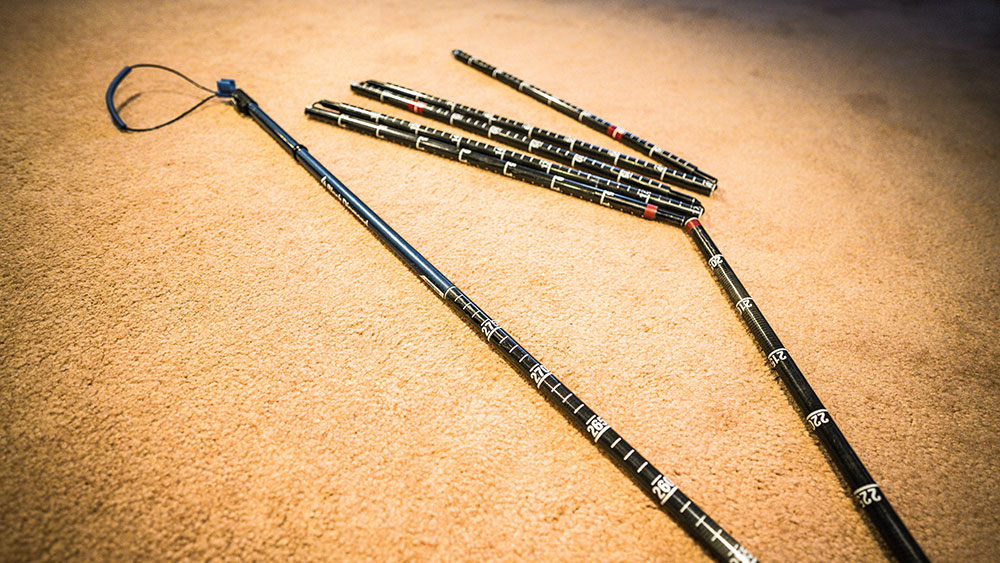
Material
Probes are made with either aluminum or carbon. Both aluminum and carbon are quality, but each has strengths and weaknesses that should be understood. Carbon is a little lighter in weight but also tends to be more expensive and break more easily. Carbon probes will snap; aluminum will bend. Aluminum probes are just slightly heavier and tend to penetrate tough and dense snow more effectively, which is highly desirable in a rescue.
Generally, the ski-mo crowd crushing vert and big distances favor carbon probes, while avalanche professionals, mountain guides, and patrollers tend to choose longer, heavier aluminum probes. Some folks have more than one probe for different conditions and objectives. Just make sure that you choose the appropriate size and material of probe for the activity you would need it for. I snapped a carbon probe day one of use in a shoveling drill on an avalanche rescue course. Wrong application of carbon. Should have had the beefy aluminum one. Oops.
Storage
Just like your shovel, your probe should be inside your backpack — NOT strapped to the outside where it can be removed from your backpack in an avalanche or just walking around. Preferably, it should be in your riding specific backpack where you can put it in its designated pocket and sleeve. That way you can leave the storage bag the probe came with at home where it won’t be lost in the backcountry to become trash.
AT Skis
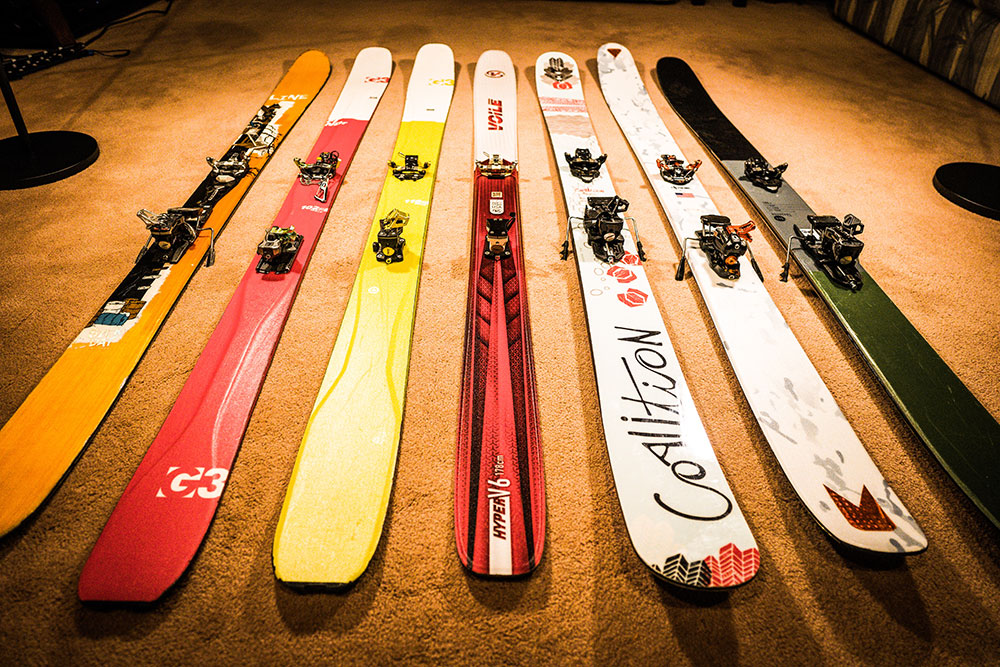
Skis aren’t tires. As such, “AT” stands for Alpine Touring, not all-terrain. To be totally honest, any downhill ski will work as an AT ski, as long as you mount ’em up with an AT ski binding. However, if you want to actually enjoy backcountry touring, you may want to take a few things into consideration when selecting a pair of AT skis.
Weight
This should seem obvious, but for some reason, it’s not. Just remember, you no longer have a ski lift to get you and all of your stuff to the top of the mountain. Weight should be a consideration for any piece of backcountry equipment, but skis are one place where you can really shave some pounds. Forget about metal top sheets and Maple cores. You want to look for skis that use materials like Aspen or Paulownia for the cores and carbon fiber in the laminates. Carbon fiber is much stiffer than fiberglass, so you can achieve similar flex properties with much less material. There are lots of ins and outs with ski construction, so just check the weight on whatever you’re interested in. The biggest fatty fats in the longest lengths should be under 9 lbs for a pair. Smaller skis should obviously be lighter.
Size and Shape
Skis have gone through a radical revolution in size and shape over the last 20 years. Way back in the day, super long and skinny was all the rage. Then, for a while there in the mid-aughts (is that what you call the early 2000’s?) Icelantic Skis showed us all that skis could be ridiculously short as long as you made them ridiculously wide as well. We now seem to have found a happy medium. Backcountry AT skis all tend to be 160 – 200 cm in length, and anywhere from 90 – 130 mm wide. The exact size, width, and shape will depend greatly on your skier profile (height, weight, ability, etc) as well as the type of snow that you most often ski.
In general, wider skis are better for powder, but also for riding over chop, breakable crust, wet mank, or other not-so-ideal snow conditions that you may find out of bounds. Narrower skis are going to perform better on spring corn, or anytime you need more agility out of your boards. They’ll also save your knees over the long run. Rolling a fat board up on edge is hard on the joints. Long skis are nice for going fast in big terrain, but they’re more challenging to tour with, specifically when kick turning.
Any kind of camber is fair game in the BC. Reverse cambered skis are going to slay pow, but probably be a little squirrely on the skin track. High cambered skis are going to be lost in deep snow, but responsive on corn. We’ve found that a flat(ish) cambered ski with early rise seems to be the ticket. Early rise is when the tips begin to bend back upwards further back on the ski. You want it. Get it.
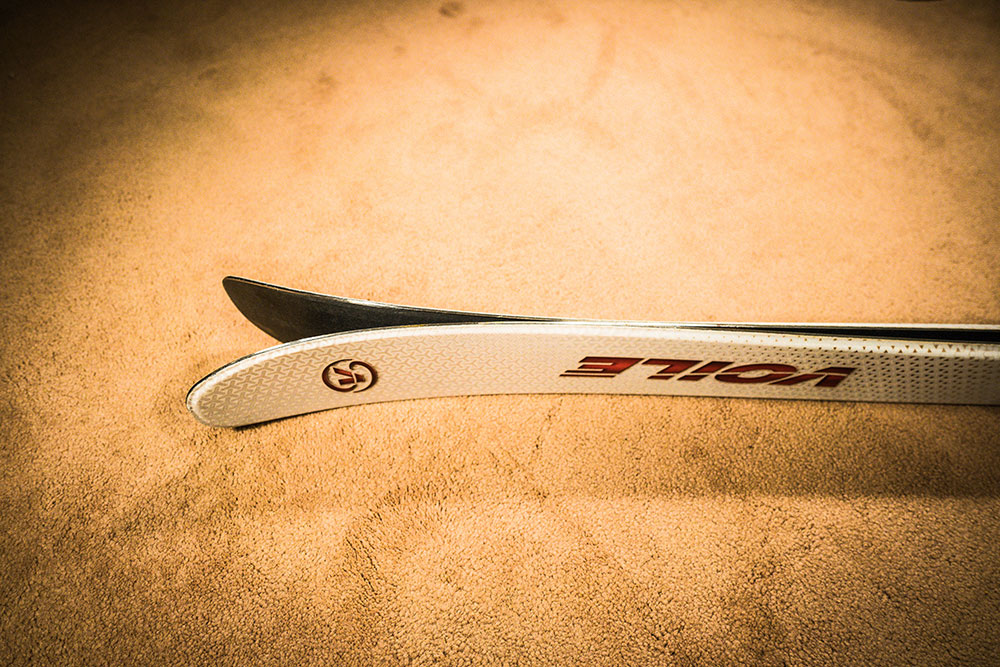
Also, stay away from full twin tips. They may be fun to ride, but that’s about all they do well. In the backcountry, you’re going to ask your boards to do many things besides just slide downhill. Flat(ish) tails are going to hold a skin clip much better. Additionally, most good backcountry AT skis have a notch or a plate in the tails for the tail clip on your skin. Oh so nice. Flat tails are also going to plunge more easily, which has benefits for kick turning as well as using your skis as snow anchors.
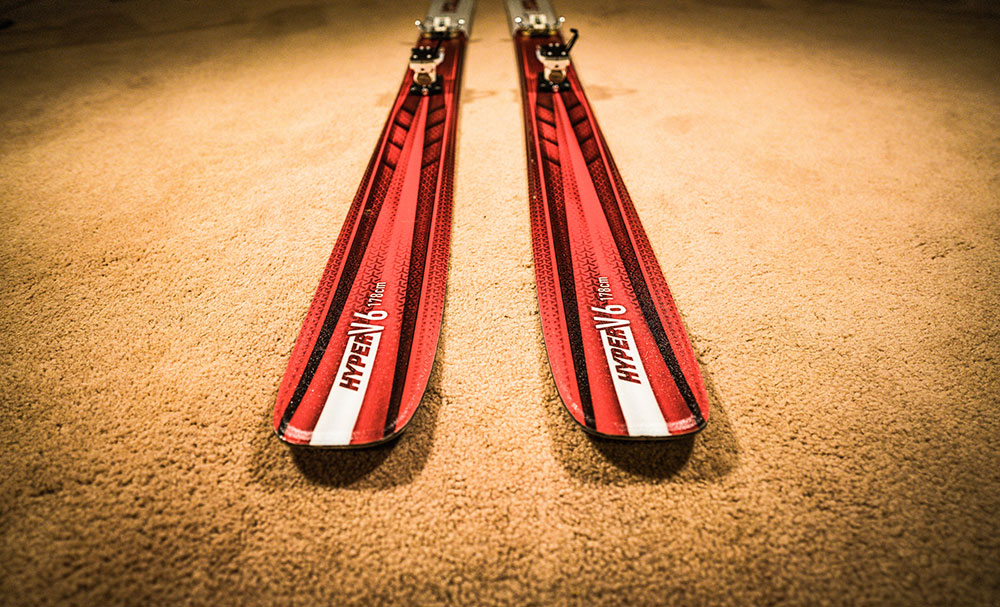
In Summary
There’s not nearly enough space in this post to get into which exact skis you should buy and why. There are a lot of companies specializing in backcountry AT skis these days, so just make sure you on one of their websites. At Baker Mountain Guides, we all seem to be loving G3 Skis lately.
AT Ski Bindings
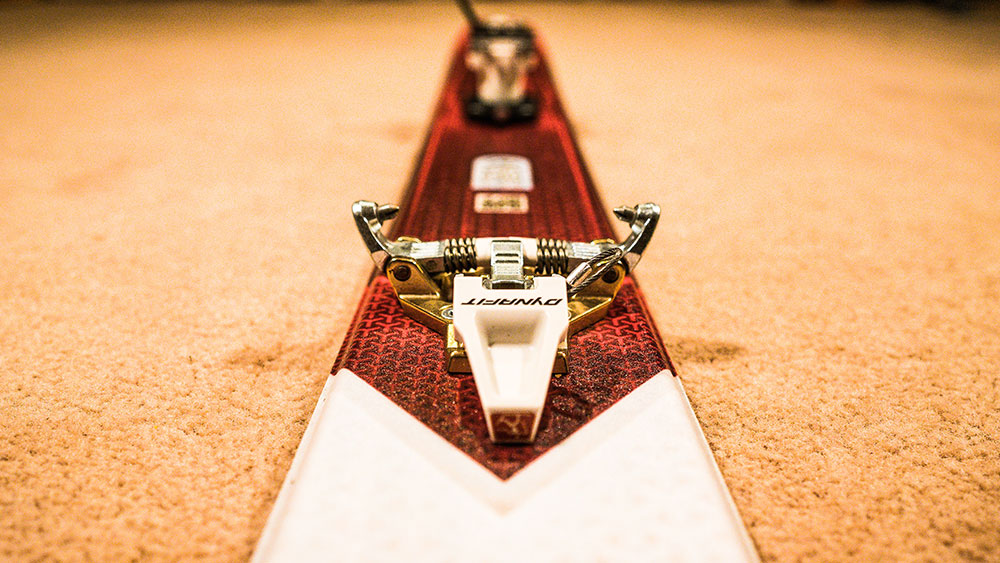
Once upon a time, the backcountry was the domain of telemark skiers. With the advent of modern AT ski bindings, we can all enjoy the backcountry without having to drop a knee. Essentially, AT ski bindings allow you to alpine ski downhill. On the uphill, AT ski bindings allow the heel to release and the toe to pivot. It’s beautiful.
Tech Vs Frame Bindings
But as always, there’s more to the story. AT ski bindings have evolved considerably over the years, and from the evolution arose two divergent species: Frame bindings and tech bindings. The concept behind frame bindings is simple – mount an alpine binding to a frame that pivots at the toe for the ascent and can be locked to the ski for the descent. How all of this works can be rather complicated, but the point is that you get all the downhill benefits of a fully-featured alpine ski binding. Unfortunately, frame bindings suffer on the uphill. Not only are they heavy, but they’re also inefficient. With each step, the skier is forced to lift the full weight of the entire frame and binding. They are also known for the dreaded frakenstride. Because the pivot point on most frame bindings is so far forward, the user is forced into an unnatural, lumbering gait. Therefore, frame bindings are mostly for the downhill oriented backcountry skier.
On the other hand, tech bindings were designed with the uphill in mind. Tech bindings achieve pivot by snapping two pins into the sides of your boot toe. The boot locks down to the ski via two more pins that can be snapped into the heel. This obviously requires you to have a tech binding compatible boot. Both the toe and heel mechanisms are springloaded to create DIN-like characteristics. Tech bindings are great for going uphill because 1) they are light and 2) you’re not lifting a frame with each step, only the weight of your boot. Unfortunately, tech bindings cannot offer highly responsive power transfer when skiing aggressively in challenging conditions, and they do not offer true DIN reliability, at least based on how DIN is tested.
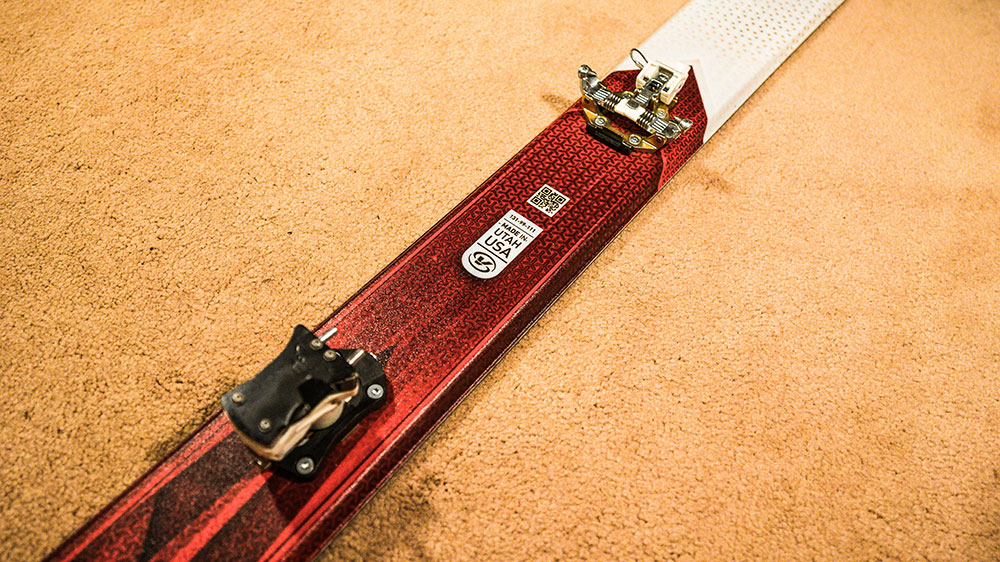
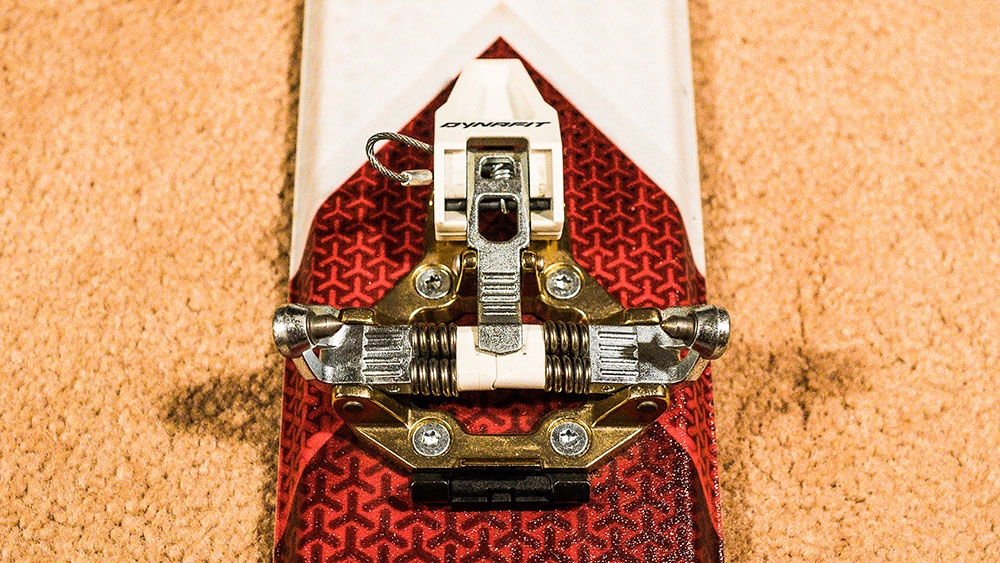
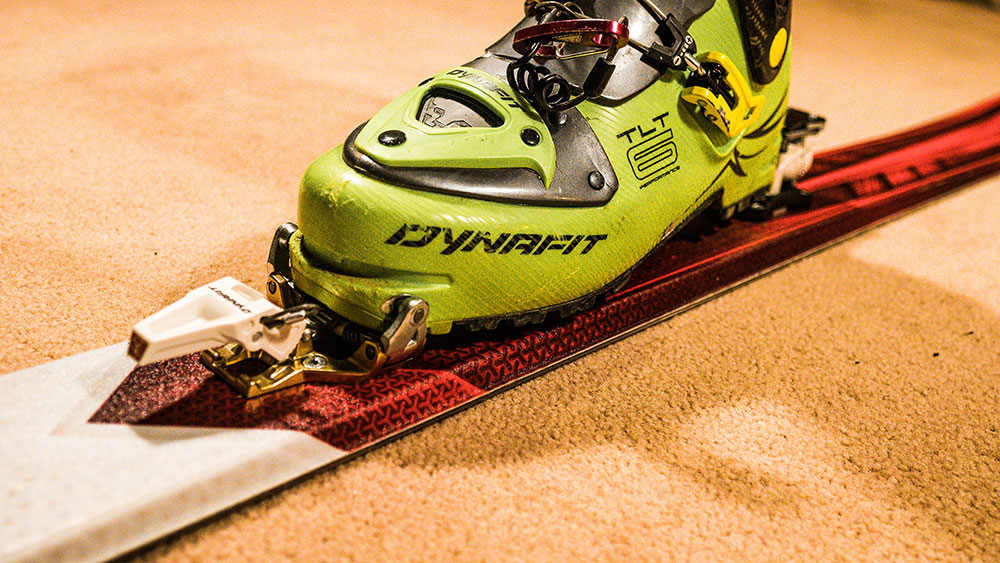
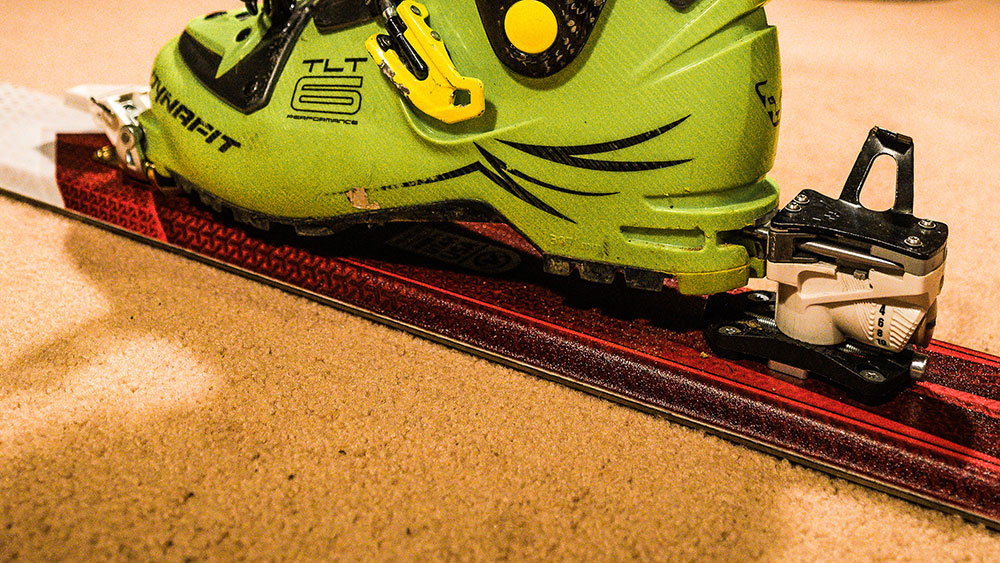
To compensate for the shortcomings in both styles of AT ski bindings, gear manufacturers have created hybrid tech bindings that use an alpine heel piece. On the uphill, a ski/walk mechanism slides the heel piece back, away from the boot. The Salomon Switch binding goes one step further with a toepiece that does a crazy transformer move between tech and alpine. In our opinion, as guides, most of these hybrid bindings need further refinement to make them more reliable or easy to use.
If you plan on earning the majority of your turns and you’re not Hulk Hogan, a classic tech binding should be more than adequate for your needs. However, if you mostly skiing lift-accessed backcountry and you want the option to tour on occasion, or if you’re Bode Miller and you don’t ski any slower than 50 mph, you may want to go with a frame binding.
Heel Risers
All backcountry touring bindings, including splitboard bindings, come with heel risers. Heel risers improve efficiency by decreasing calf fatigue. When ascending an incline, your skins grip the best when even pressure is applied to the entire length of the ski. This requires that you weight your heel, and weighting your heel is much easier and more comfortable with heel risers. Most tech bindings build the heel risers into the heel piece in such a way that they can be actuated with your pole. Frame bindings often use metal wires that flip up from the frame under your foot. Either system accomplishes the same goal.
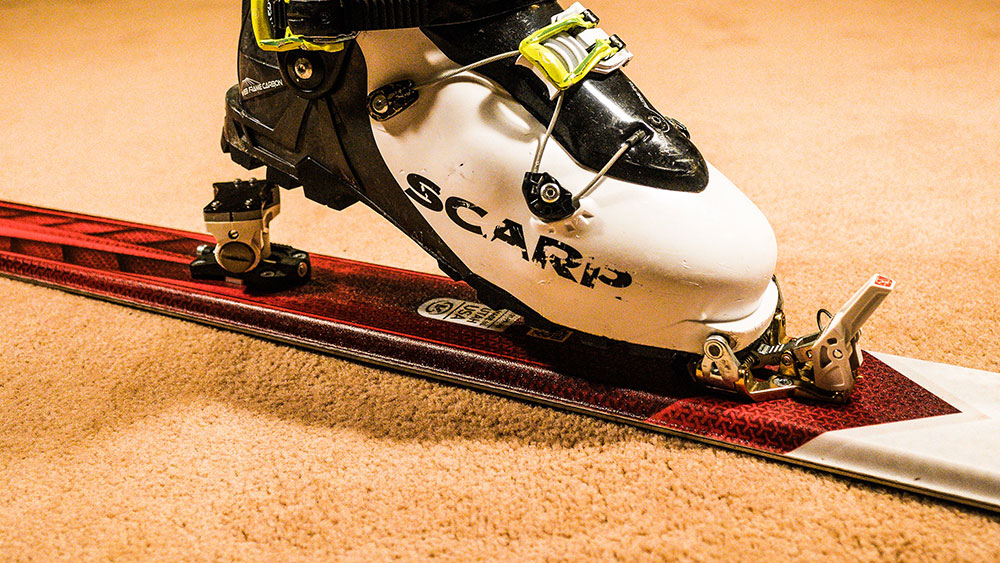
SplitBoards
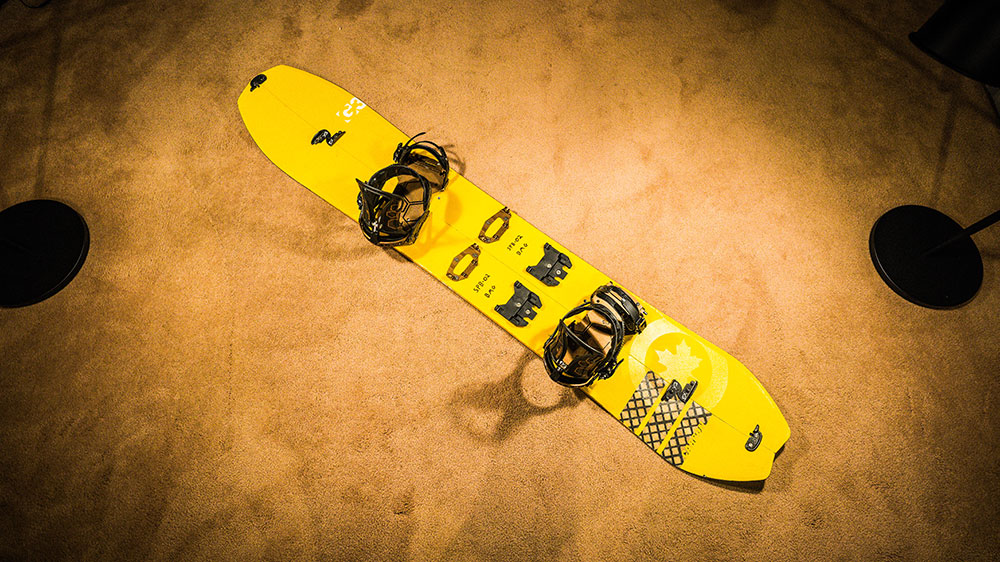
Splitboards are literally just that: Snowboards that split in half to create skis. Splitboard bindings are basically just fancy snowboard bindings that quickly remount for skinning or riding. In ski mode, splitboard bindings face forward on each ski and pivot at the toe. In snowboard mode, the bindings slide onto plates across both pieces of the board, creating rigidity. Strange? Absolutely. Clever? For sure. Splitboards are the frankentool of backcountry touring, and like most inventions, they were born from necessity. Despite the brief popularity of cross-country snowboarding, skis continue to be the better tool for getting around the mountains.
Size and shape
All the things about size and shape that are true for AT skis are also true for splitboards. The difference is that all splitboards are designed for backcountry use, as opposed to skis, which makes your consumer experience more straightforward. The exact size, shape, and style of splitboard are going to depend on your rider profile as well as the kind of splitboarding that you are doing and the snow conditions that you most commonly ride. Flat(ish) camber with early rise is a good starting point, but we would encourage you to demo different styles (like swallowtails) to see what floats your boat. In general, however, you do want to size up at least 5 cm from whatever you’ve been riding in bounds. Because powder.
Manufactured or Homemade?
If you’re working on a shoestring budget, you can borrow your uncle’s table saw and make a splitboard out of an old snowboard. This is how splitboards were born. Voile still sells their classic split kit that you can use to Bob Vila your way into the backcountry. Just remember to seal up those new sidewalls with some kind of epoxy.
However, homemade boards suffer from a number of issues. First, they’re going to be really heavy. The Voile split kit includes metal splitboard plates that you simply mount your old snowboard bindings to. This is a lot of extra material to be lugging up the hill. Second, you’re not going to have a metal outside edge when you’re touring, which makes side-hilling super fun. When skinning, the cut edges need to face outward so that the connection hardware doesn’t get hung up on itself. Finally, snowboards aren’t designed to be cut in half, and the torsional rigidity of the resulting skis is going to suffer greatly. Manufactured splitboards solve all of these problems by starting with the premise that you’re building two skis that fit together to make a snowboard.
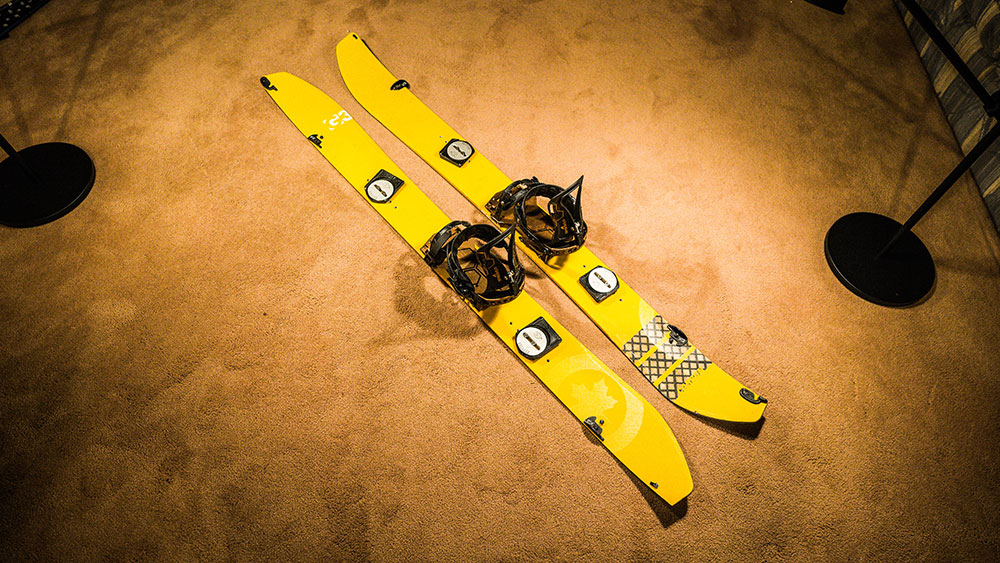
Boot and Binding Systems
Splitboard bindings are about as creative as splitboards themselves. The two most common attachment systems are built around either soft boots or hard boots. Soft boot splitboard bindings look a lot like normal snowboard bindings with the same selection of bells and whistles. The difference is in the base plate. Soft boot bindings have rails along the bottom of the baseplate that allow them to slide onto mounting plates when in snowboard mode. In skinning mode, the bindings remount onto the skis via some kind of pin system at the toe. Every manufacturer has a different take on their pin systems, but the good news is that everyone has moved away from the classic trailer hitch pin attachment. Seriously. That’s what they used to use. The two most common soft boot splitboard bindings are Spark R&D and Karakoram.
Hard boot systems obviously require the purchase and use of some kind of hard boot, but they help to solve the biggest drawback of splitboarding: sidehill slop. Because soft boots are soft, and because they flex in soft boot bindings, holding an edge while skinning across a firm sidehill can be really difficult. As it turns out, there’s a lot of firm side-hilling in the backcountry, especially when you get into splitboard mountaineering. Hard boot systems solve this problem by pairing hard boots with AT tech binding style toepieces, mounted to both skis. Lightweight plates are still used to secure the boot to the board and to create structural rigidity in snowboard mode, but they go in the backpack on the uphill. The added benefit of hard boot systems is that they are lighter as well. If a hard boot system is your cup of tea, check out Phantom Hardware.
Skins
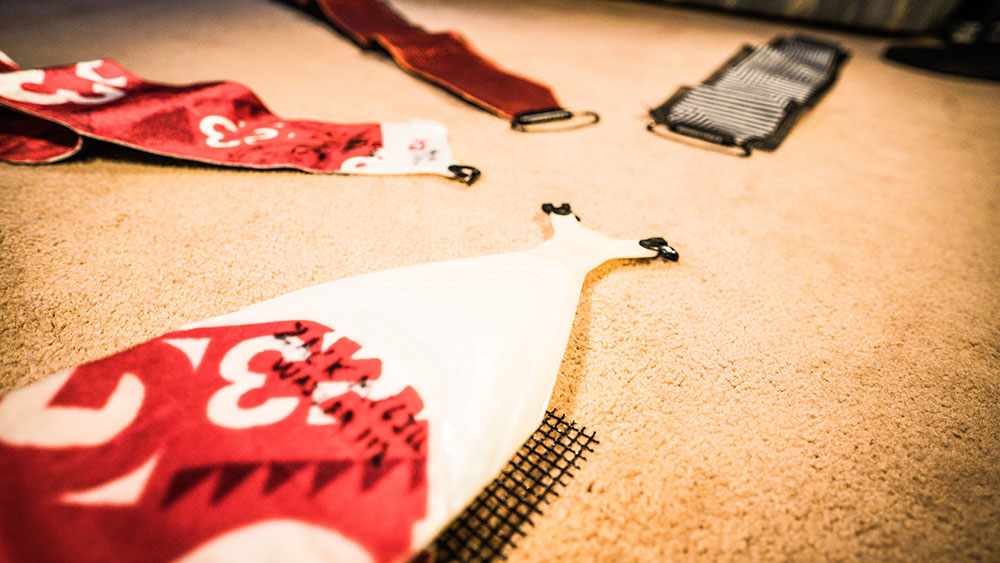
Climbing skins allow you to tour uphill with skis on your feet. They’re basically a strip of fabric with “plush” on one side and glue on the other. The plush can be a variety of materials, but it’s always smooth tip to tail, and grippy tail to tip. Skins literally used to be made out of seal skins, which is how they got their name. No longer do we need to club a baby seal to go skiing, though. Now we just make skins out of oil…and goats. Which is better…I guess?
Size
For the purposes of backcountry skiing and riding, skins should cover as much of the base of your boards as possible, while leaving the metal edges exposed. This means that you’re going to have to either purchase skins that are designed to fit your boards perfectly, or trim them to the correct size. Skins that need trimmed always come with skin trimmers, and all manufactures have a “how to trim your skins” tutorial.
If you have a splitboard, congratulations, buying skins is easy. Just choose the correct length for your board and trim them to width. For you skiers, sizing can get weird. Some manufacturers like Dynafit, K2, and La Sportiva make skins that fit their skis perfectly, so you just need to select the model and length that you need – no trimming required. Additionally, G3 and Pomoca skins come in several generic lengths and widths, which need to be trimmed to your specific ski width. Black Diamond skins just have options for width and come in longer sections that need to be trimmed to both length and width, with the added fun of mounting the tip loop to the skin. Black Diamond also sells “Custom” skins that arrive in pre-cut lengths. When selecting the skin’s width, check your ski’s dimensions so you can choose a skin that is wider than the widest part of your boards. Hot Tip: This is usually near the tip.
Material
Skins come in three different material types: Nylon, mohair, or a mix of the two. Mohair is goat hair, which is more slippery, resulting in less resistance with each step. It’s also a lot lighter and less bulky than nylon. However, the sacrifice you make with Mohair is that it does not climb as well as nylon and is less durable. Nylon skins do just the opposite — climb really well and are more durable, but have less glide and are heavier. The mix skins come at different ratios of nylon to mohair: the more mohair, the more glide. If you’re just starting out, we’d recommend getting nylon skins. For splitboarders, definitely go with the nylon, you don’t get much glide anyway and you’ll appreciate the extra grip on the uphill.
Attachment Type
In general, climbing skins attach your boards with either hooks or a loop at the tip, and an adjustable strap with a clip at the tail. This method works well with most skis and boards out there, but especially on dedicated touring skis or boards that have flat or notched tails. For skiers with twin-tips, G3’s Twin-Tip Connectors are great. Without them, your skins will continually slide off your tails. All skins use glue to make them stick to the base of your boards. Some skin manufacturers are experimenting with different technologies to get away from glue, but none we know of have had much success.
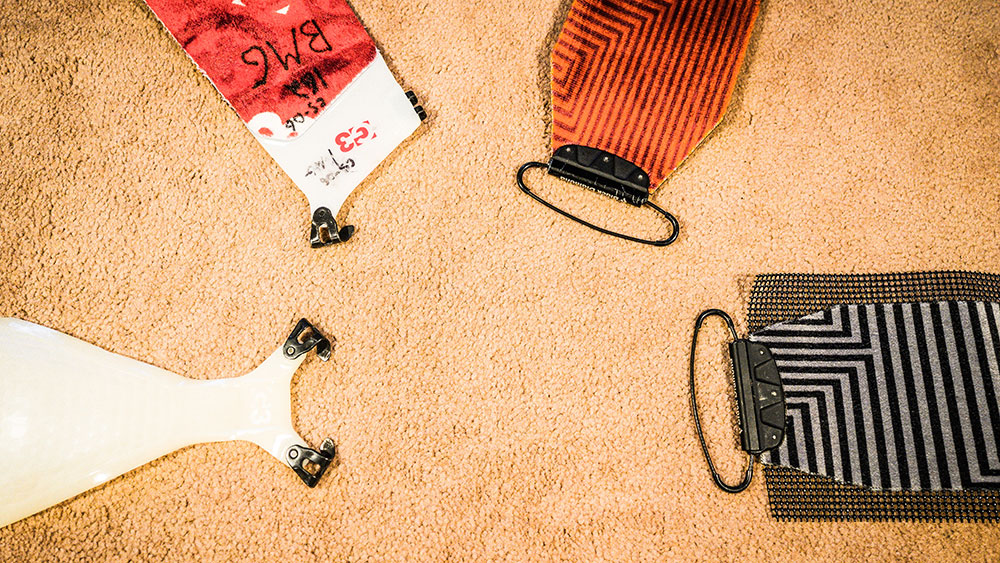
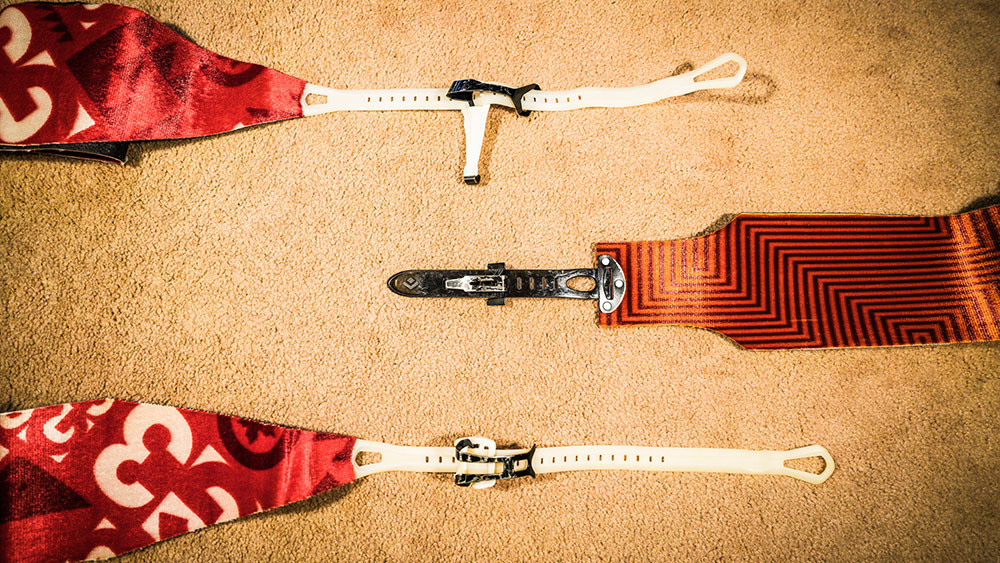
Storage
To store your skins in the field on the downhill, just fold each one in half, glue-to-glue, then fold em’ or roll em’ to fit in your pack. Some people choose to put the skins in front jacket or bib pockets to keep them warm on cold days. This keeps the glue nice and tacky. If you live in CO, this is a pretty common practice. In WA, it’s almost never needed. G3 makes the “love glove” for storage of skins and most manufacturers provide “skin savers,” (plastic sheets that you apply to the glue-side of the skin prior to folding) but we recommend not carrying these items in the field. Just fold your skins glue-to-glue. Do it. You’ll be fine.
After you get home, the skins need to be dried as quickly as possible. Leaving them folded and wet can make your glue less effective. Just hang them on a coat rack or over a door. When they’re dry, you can fold em’ or roll em’ for storage. For prolonged periods of time and the off-season, throw on those skin savers and leave them in a cool, dry place, like a freezer.
Curious about how to use skins? Check out our Backcountry Skiing Skinning Techniques blog.
Ski Crampons
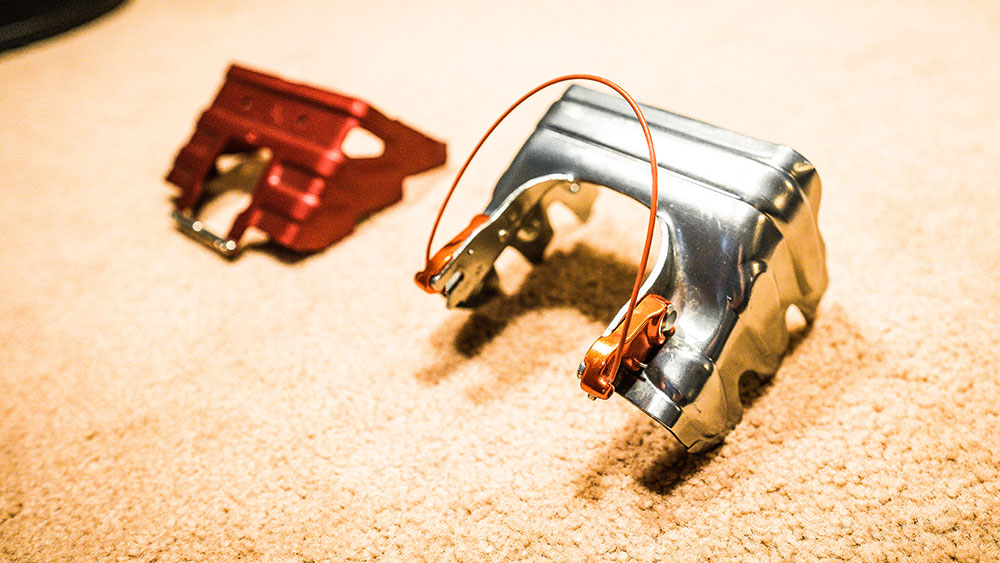
Ski crampons are one of those items that you don’t need most of the time while out skiing or riding in the backcountry, but are a HUGE bummer to not have when you do need them. Like a boot crampon, a ski crampon gives you more purchase in hard or icy conditions. Usually, they attach to your binding and insert directly under your boot. The binding attachment point is hinged so the crampon releases from the snow as you lift your foot, and then bite into the snow when you step down. In firm conditions, especially while side-hilling, ski crampons are essential. This is especially true for splitboarders. The lack of torsional rigidity and the shorter effective edge on a splitboard creates huge problems while side-hilling.
Size
Ski crampons historically have come in 10mm increments (i.e 90mm, 100mm, 110mm). Always choose the crampon size at your ski width or just above. If you get a crampon that is smaller than the width of the ski, it won’t fit. One that’s too big will be loose and more likely to break. Consequently, if you have a ski that is 95mm underfoot, you’d typically be forced to go up to a 100mm ski crampon. This works but is less than ideal. Luckily, more and more companies, like G3 (Genuine Guide Gear) are breaking from the mold of 10mm increments and have created crampons that align perfectly with the widths in their ski line.
Compatability
Not all bindings are compatible with every ski crampon, so make sure you know what types of crampons fit your binding before making your purchase. G3 has their own special attachment system that only works with their equipment. It’s fabulous. Check it out. Dynafit, the pioneer in this realm also has their own attachment system, though other manufacturers have created crampons that work with their Dynafit bindings. There are a multitude of other crampons available as well. 22 Designs (telemark), Plum, Voile, B&D, Fritschi, ATK, Salomon, and Atomic all make ski crampons.
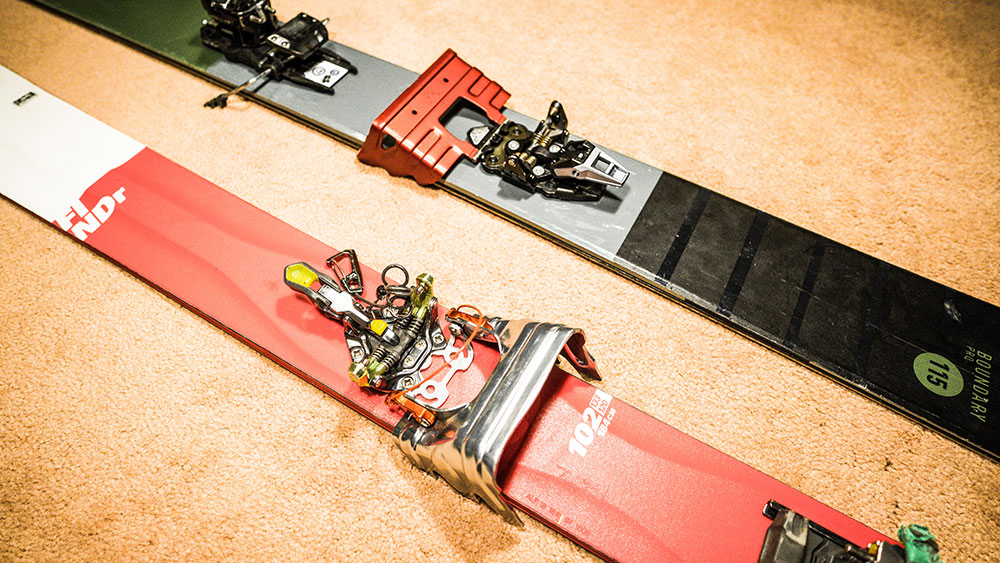
For splitboarders, Spark R&D and Karakoram make splitboard specific crampons. These work the same as ski specific crampons, but are wider to accommodate board width/asymmetry.
For more information on ski crampons, check out Phil’s 5 tips for Ski Crampons for Backcountry Skiing. For a full tutorial on skinning techniques that include ski crampon use, check out our blog on Backcountry Skiing Skinning Techniques.
AT Ski Boots
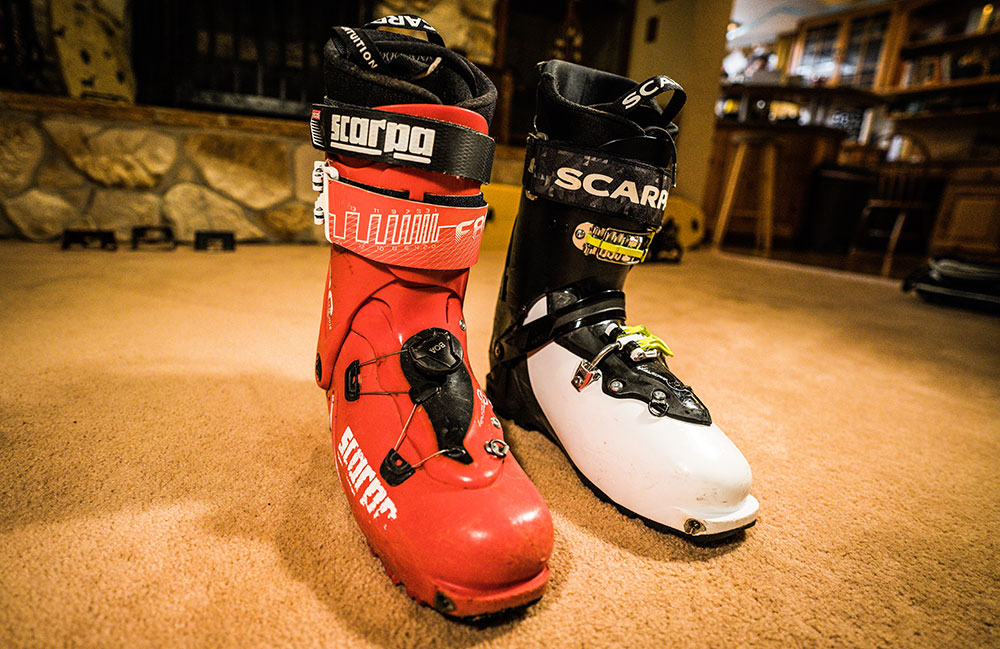
What exactly is an AT ski boot? Why do you want one? Can’t you just use your alpine boot? All good questions. Technically, you could get away with an alpine boot if you’re using a frame binding, but the bigger question is “Why?” Why would you do that to yourself? Alpine boots are designed to go downhill, not up. AT ski boots are designed to do both. There’s a lot of crossover, but the main difference between alpine and AT ski boots is the ski/walk mechanism – among a few other important details that will decrease your chances of being sweaty and frustrated.
Types
Like a lot of other backcountry equipment, boots are separated into two types: those that go downhill really well, and those that go uphill really well. Obviously, there are boots that split the difference, but it’s easier to organize everything into uphill and downhill categories. Uphill boots will typically have a tongue, tech binding compatible inserts, fewer buckles, a greater range in cuff rotation as well as a higher pivot point, a lugged sole, and be made of thinner plastic. Downhill AT ski boots may simply look a lot like a traditional, overlap cuff alpine boots, with the addition of a ski/walk mechanism. With the advent of burly tech bindings, many downhill oriented AT ski boots are now offering tech inserts as well.
However, it’s really amazing how well light, uphill oriented AT ski boots are skiing downhill these days. Don’t let the number of buckles fool you, either. There are two-buckle AT ski boots that ski just as well as any four-buckle AT ski boots. Tounge boots can be just as stiff as overlap cuff boots, although the flex pattern will be different. The cuff rotation on downhill oriented AT ski boots gets better and better every year. We’re big fans of having different tools for different purposes, but if you’re going to invest in your first pair of AT ski boots, it’s worth buying something that falls right in the middle.
Ski/Walk Mechanism
With backcountry touring, you’re going to spend about 85% – 90% of your day going uphill. Learn to love it, or at least get gear that’s going to make it less difficult. A ski/walk mechanism should be mandatory on any boot that you are using in the backcountry. Basically, the ski/walk mechanism releases the cuff of the boot so that it can pivot back and forth. The more range you have, the more comfortable you’re going to be.
But there’s so much more to it than that! Pretty much every boot manufacturer has their own take on how to switch from ski to walk and vice-versa. All of these mechanisms are going to be located on the spine, or the back of the boot. The spine is also a critical part of the boot’s structure and helps to determine how stiff the boot is – aka, how powerful the boot is. Brands like Scarpa and Atomic have tackled this issue by literally making the ski/walk mechanism THE spine of the boots. In these cases, the spine is a big, burly level that flips up and down. When it’s down, it locks the cuff to the lower shell, and when it’s up, it doesn’t. All brands seem to have some take on the spine lever now.
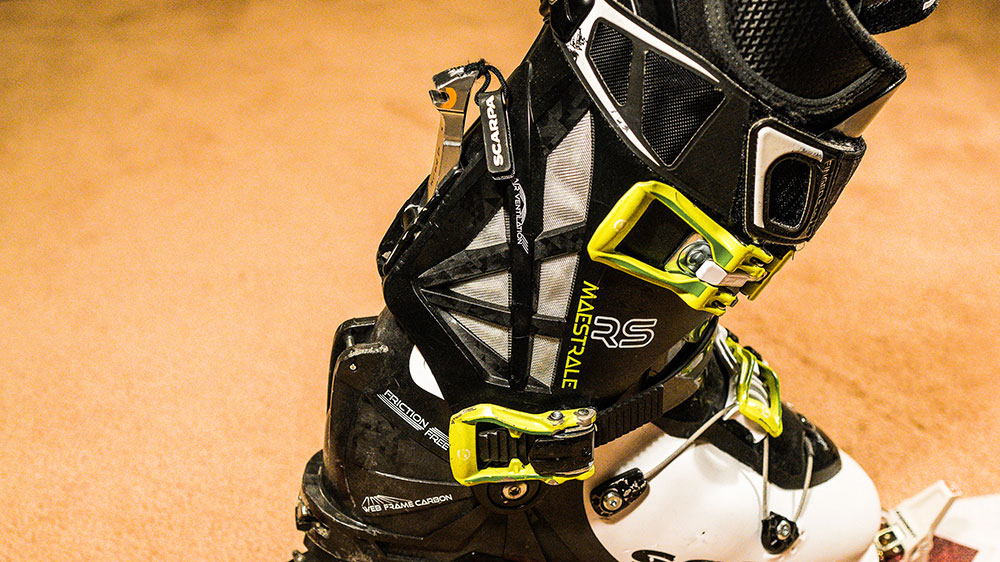
Other brands, like Dynafit, have opted for ski/walk mechanisms that make transitions easier. Unbuckling the cuff buckle on some Dynafit boots automatically puts the boot in walk mode, and vice-versa. In general, when you’re skinning uphill, you want to open all of your buckles. Additionally, the “buckle mechanism” has proven to offer surprisingly good range of motion and power on the downhill.
Buckles
The three different types of buckles that you’ll find on AT ski boots are wire straps, ratchet straps, and traditional alpine boot cam buckles. Traditional cam buckles are going to provide the most rigid connection, and therefore the best power transfer, but they don’t work well with tongue boots because they can’t span across the tongue. To solve this problem boot manufacturers use wire buckles which basically extended the reach of cam buckles via a wire loop, and ratchet straps, which look a lot like snowboard straps. When buying AT ski boots, look at how many buckles there are, what kind of buckles they are, and how easy it will be to transition from ski to walk and back.
Tech Inserts
Almost all AT ski boots offer tech inserts these days. Tech inserts are metal indents in the toe and heel that allow the boot to connect to a tech binding. Unless you know for sure that you are never going to use the boot in a tech binding, just get a boot with tech inserts.
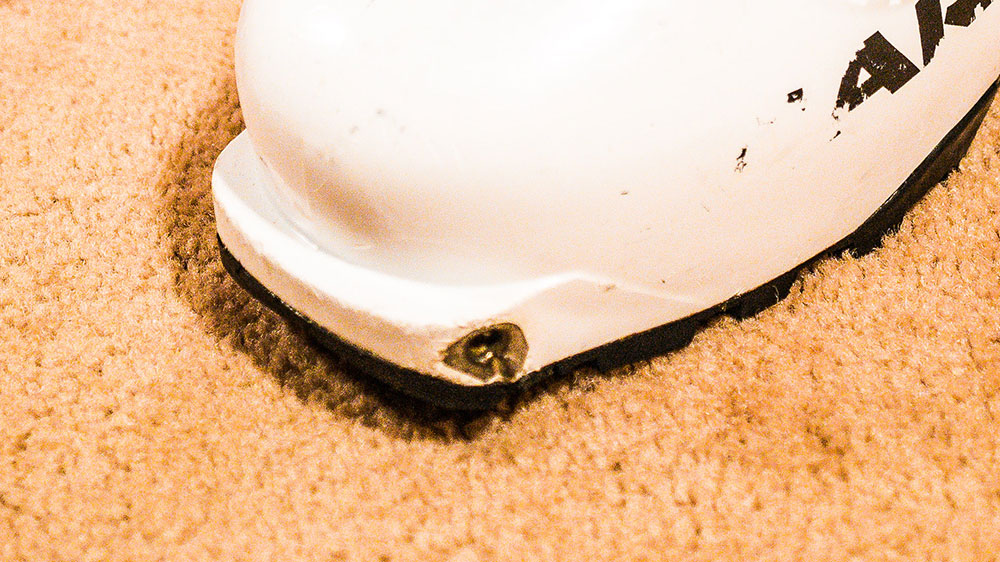
Soles and DIN Compatibility
AT ski boots will either have a lugged sole or an alpine sole. Lugged soles look like mountaineering boot soles and are ideal if you’re going to be walking around on rock (i.e. ski mountaineering). In general, most lugged soles shouldn’t be used in frame AT ski bindings or alpine bindings because the boots do not meet DIN standards for side release. Some frame bindings have an anti-friction plate under the ball of the foot. This feature certainly improves reliability, but nothing is as good for DIN as a smooth alpine sole. But then, your boot will suck for walking around. Again, just figure out what kind of backcountry skiing you’re going to be doing and go from there.
Riding Specific Backpack
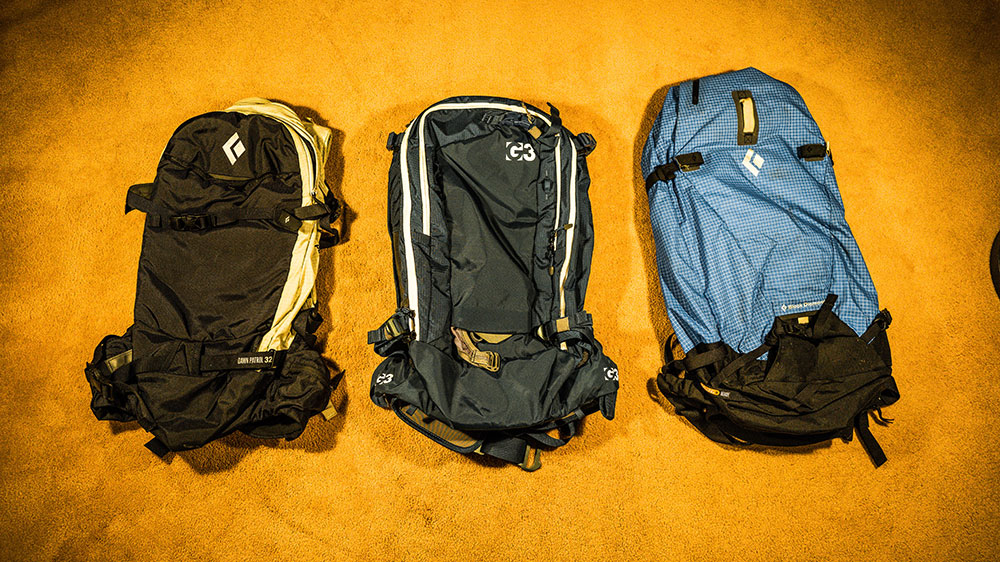
This is one of those items that is arguably essential. You can definitely get away with a non-riding specific backpack for a little while as long as it is large enough to fit all your things, but, if you’re serious about getting out into the backcountry, you’re going to want one. Here are some of the benefits of riding specific backpacks.
Size
Riding specific packs are big enough to fit everything inside. No more shovel handles falling off into the snow to become lonely, neglected, trash in my gear room. Most are between 25L and 45L for capacity. If you’re going out for a shorter day tour and you’re splitting up essential group gear amongst the squad, 25-35L is a great size. Going out for a longer tour or a mountaineering objective in glaciated or complex terrain? Get something more on the 45L side of things so you can fit your rope and rack inside your pack as well.
Storage of Essential Equipment
All riding specific backpacks have an easy access pocket that fits your shovel, probe, and snow saw, if you’re carrying one. Some also have an easy access pocket for your FA kit. When time is of the essence in a rescue, being able to easily access your equipment is essential.
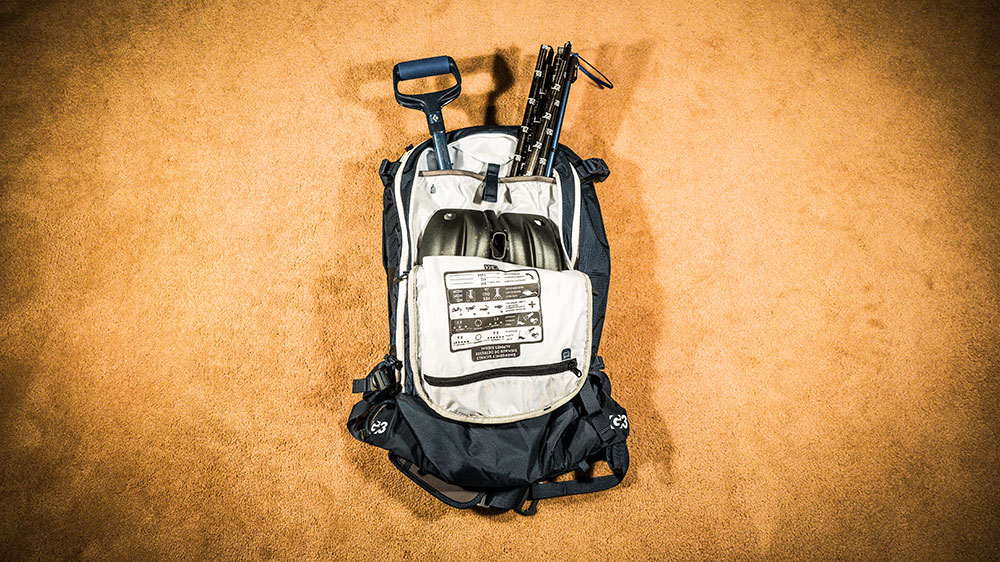
Ski/Board Carry
Most backpacks have several available carrying system options built-in (Diagonal, “A” Frame, or Straight) depending on how long you’re booting, where you’re storing your helmet, etc. These systems are designed for skis/boards, so you don’t have to worry about the plastic buckles on your non-riding specific tension straps exploding on you and launching your fun sticks to the bottom of the mountain without you.
Riding Specific Pockets and Access
Having a goggle pocket, external helmet carry system, and zippers in all the right places for easy access to things in your backpack even while you’re carrying your boards is dreamy. Treat yo’ self.
Airbag Compatible
Many packs coming out now are airbag compatible. This means that even if you’re not ready to drop the major coin on an airbag, you can get the backpack and leave that option open for the future.
Airbag Backpack
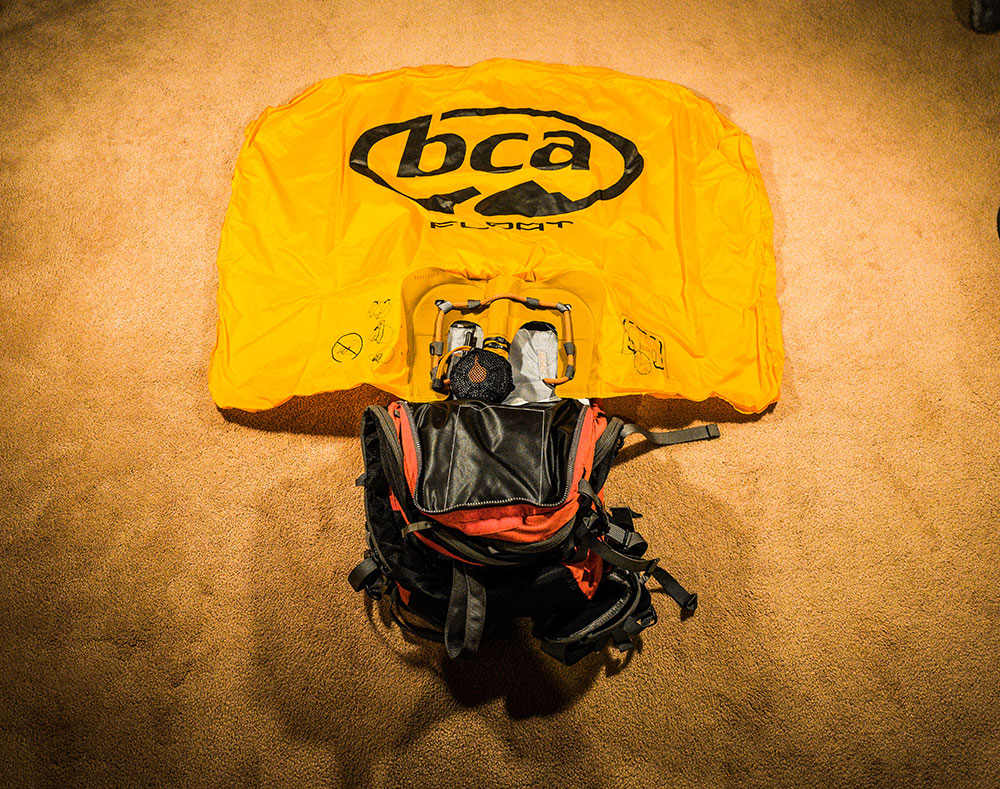
Once upon a time, nobody skied the backcountry with an airbag backpack. Those days are pretty much over. Airbag backpacks work. Period. If you’re just getting into backcountry skiing and riding and you’re tight on bucks, you definitely want to purchase a beacon, probe, and shovel first. However, an airbag backpack should be on your Christmas list.
Science!
Airbag backpacks prevent you from being buried in an avalanche via the law of inverse particles. Say what? Let’s make this more simple by framing it in the context of the Brazil nut theory. If you take a jar of mixed nuts and shake it, the Brazil nuts will work their way up to the top. Why? Because they’re the biggest nuts in the jar. Just like you – or like you want to be in an avalanche, at least. So no, airbag backpacks don’t actually “float” you in the traditional sense of fluid dynamics, they simply sort you to the surface of the tumbling ball pit. That’s right – it’s physics, baby!
Why is this awesome? Well, 75% of avalanche fatalities are the result of asphyxiation. Asphyxiation requires victims to be fully buried, and if you’re not fully buried, it’s hard to asphyxiate. 25% of all avalanche fatalities are the result of trauma, however, airbag backpacks decrease the likelihood of trauma as well. If you’re not getting washing machined hard, you’re probably not going to get as beat up. Surfers know what I’m talking about.
Inflation Systems
Airbag backpacks have come a long way since their inception. To begin, the backpacks themselves have improved greatly as skiing and riding specific packs. For the most part, one brand or style is no better than another in terms of backcountry touring features. One of the best innovations in recent years is modular inflation systems. Basically, with a modular inflation system, you only have to buy the airbag part of the backpack once, and you can use it with different styles or sizes of compatible riding-specific backpacks. Most major airbag manufacturers now offer some sort of modular option.
All airbags are deployed via a handle in the shoulder strap. In order for the airbag to work, you have to actually pull the handle while you still can. There are two primary systems for getting air into the airbag. The first is compressed air, and the second is turbofan technology. Compressed air comes in the form of an air canister that can be filled to extremely high pressures (3000 PSI), sort of like a mini scuba tank. When deployed, the canisters release their air into the airbag. Additional outside air is often sucked into the airbag as well via the Venturi effect. More science! Different brands have different ways in which the canisters release air, each with their own pros and cons. However, all compressed air systems are single deployment. Canisters must be exchanged with a dealer or refilled at a scuba shop.
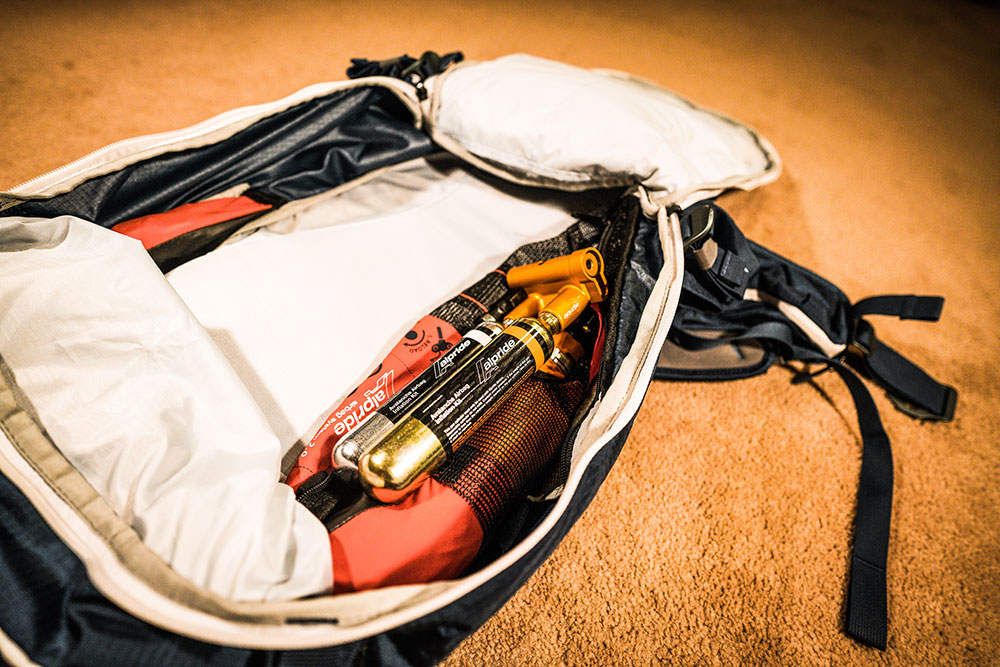
Turbofan airbag backpacks use batteries or super-capacitors to power a turbofan and move a lot of air really quickly. Turbofan technology allows for some innovative features such as multiple deployments, puncture refill, and airbag deflation to create a potential air pocket if the victim is fully buried. Because the system is electric, it can run diagnostics on itself as well. And there are no canisters to refill. Just plug it into an outlet.
Travel Considerations
Because airbag backpacks all utilize either a compressed air canister or a dense lithium-ion battery, air travel can be a bit of a pain. In our anecdotal experience, domestic travel or travel within North America seems to be a little easier with turbofan technology. International travel seems to go more smoothly with compressed air technology. The exact rules will depend on the airline and the country you’re traveling within, to, or from.
Risky Shift
All that being said, airbag backpacks are in no way a substitute for sound decision making and avalanche hazard avoidance. In our avalanche courses, we talk about the risky shift, which is the idea that people do dumber things when they feel more confident. Airbag backpacks should be used to simply increase your margin of safety, much like avalanche beacons, probes, and shovels. You should most definitely never say “well, I can ski this terrain because I have an airbag,” either out loud or otherwise. Airbag backpacks are great, but once you are caught in an avalanche, you’re not guaranteed a 100% chance of survival.
Repair Kit
Let’s layout a little scenario. You’re out for a long day tour in perfect pow conditions. To get away from the crowds, you push out pretty far into terrain and drop into a different drainage than the car is parked. On your run down, you take a tumble and rip out your toe piece.
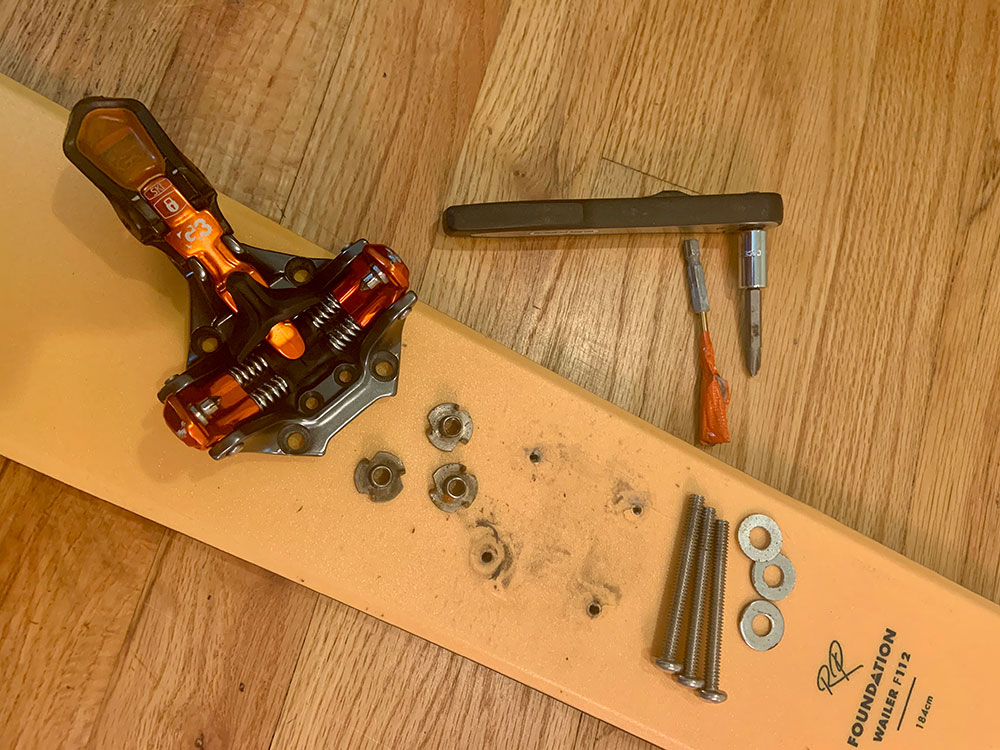
Without a repair kit, what are your options? How long will it take you to crawl out? Is that even possible? People have died this way. The way to avoid (at the least) a very frustrating and slow evacuation out of the field is to invest in a quality repair kit that can fix most problems. You’ll be surprised how modest a financial investment it is. Check out our blog on repair kits to get some ideas on what to carry.
First Aid Kit
If someone is actually caught in an avalanche, they’ll likely be suffering from a plethora of injuries — including trauma. Do you have the education to know how to help? Do you carry a first aid kit? Does it consist of some blister care stuff, a couple of band-aids, and a beer? If so, that’s not going to do much if the poop smacks the fan. Check out our blog on first aid kits to get some ideas on what to carry.
Backcountry Skiing Skills/Techniques (How do I do it?)
“On the mountains of truth you can never climb in vain: either you will reach a point higher up today, or you will be training your powers so that you will be able to climb higher tomorrow. ”
Wax on… Wax Off
Alright grasshoppers. Whether you’re just beginning this journey or have hundreds of days logged in the backcountry, there’s always more to learn. In this section you’ll find resources to hone your skills in the following categories:
Avalanche Rescue | Navigation | Uphill Travel Techniques | Downhill Travel Techniques
If you don’t see what you’re looking for, remember to let us know, and we’ll add it!
Avalanche Rescue
An essential skillset for anyone traveling in avalanche terrain is the ability to perform a rescue. Though you hopefully make good decisions and never have to use rescue skills in real-time, prepare for the worst. Below we walk you through how to perform a single person rescue and go over some strategic shoveling techniques. In order to truly become fluent in rescue, take a rescue course and practice, practice, practice!
Single Burial Rescue
Most often, avalanche incidents involve just a single buried individual. In the most simple terms, an avalanche rescue requires one to use their avalanche beacon to follow a signal, probe to physically identify the buried human, and then shovel to extricate them. Our Single Burial Rescue blog will walk you through all the nitty-gritty details of how to perform a rescue.
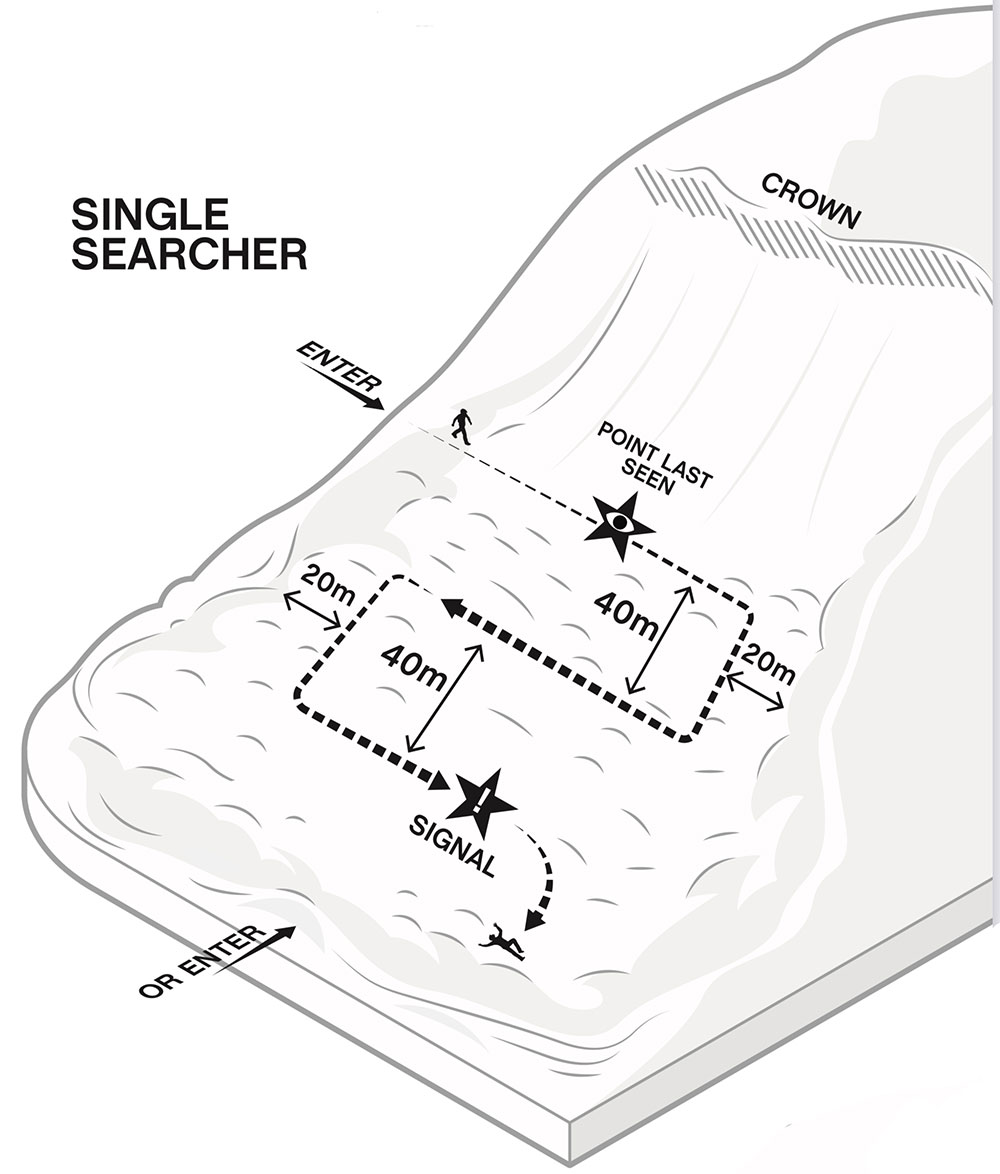
Strategic Shoveling
In an avalanche rescue, you’ll spend the most amount of time shoveling. Yes, shoveling. So knowing how to do it efficiently will not only save your back, but save lives. Check out Strategic Shoveling for Avalanche Rescue to learn how to dig well and with purpose.
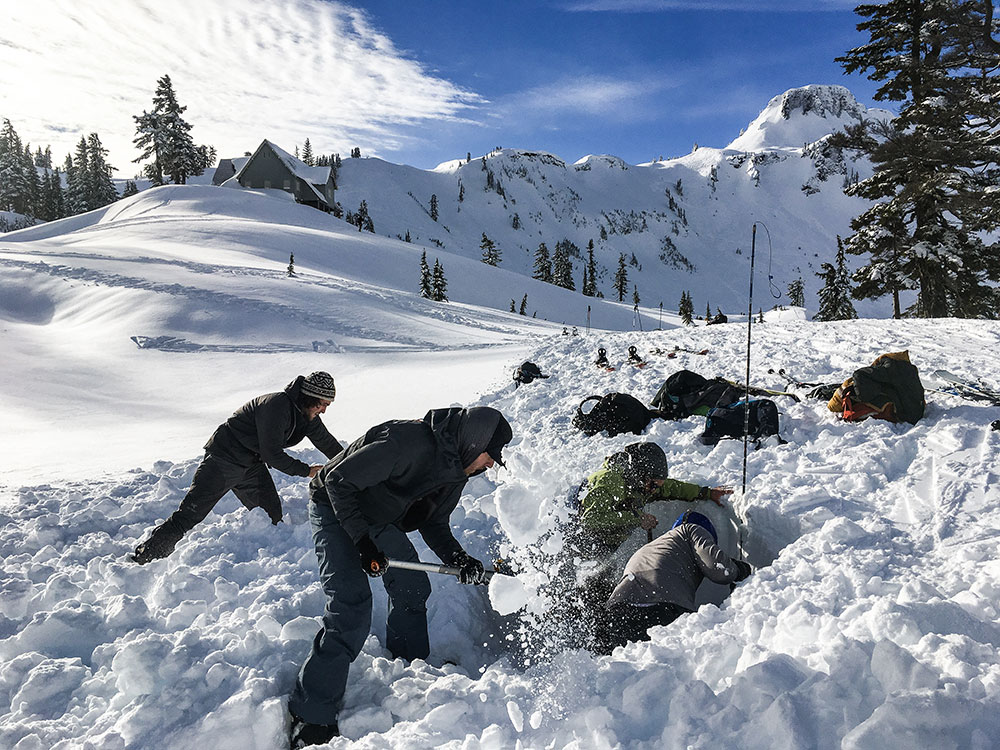
Back to Skills/Techniques | Back to Top
Navigation
Whiteout Navigation
If you get caught out in a whiteout, especially in glaciated or snowy terrain with no distinguishable terrain characteristics, it’s easy to become disoriented. Heard the phrase “inside the ping-pong ball?” Check out our blog on Whiteout Navigation to learn the things you need to know to make the best decision on where and how to navigate.
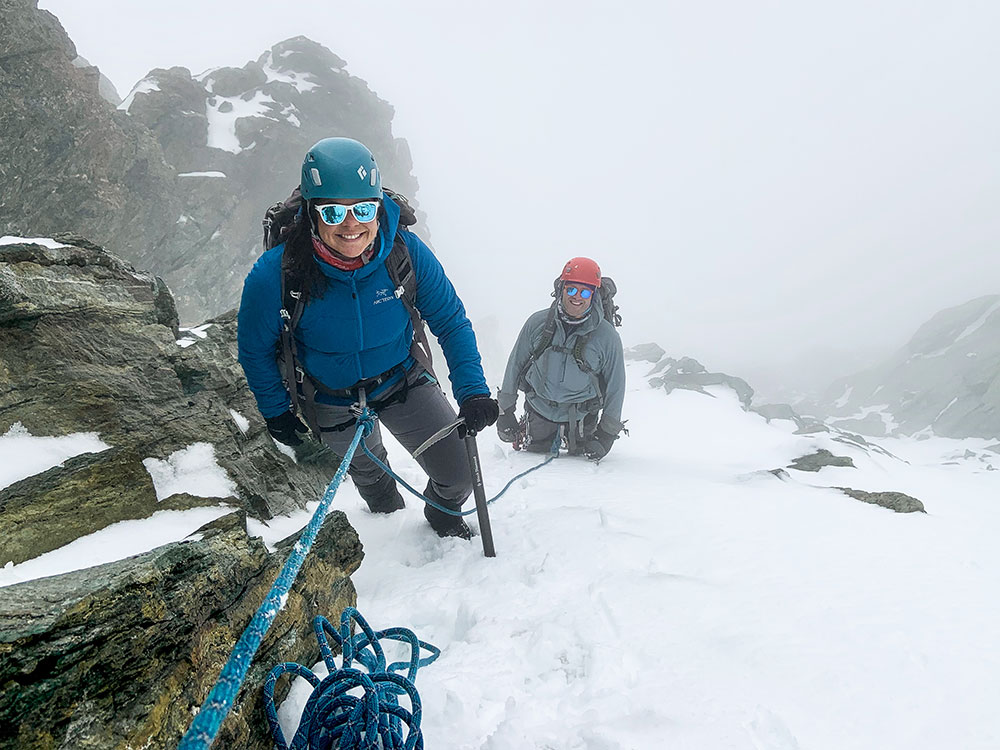
Navigation 101
Taking it back to the essentials for navigation: how to use a compass in conjunction with a map to find your way through terrain. In our Navigation 101 post we go over the parts of a compass, declination, magnetic vs true north, taking bearings, and more.
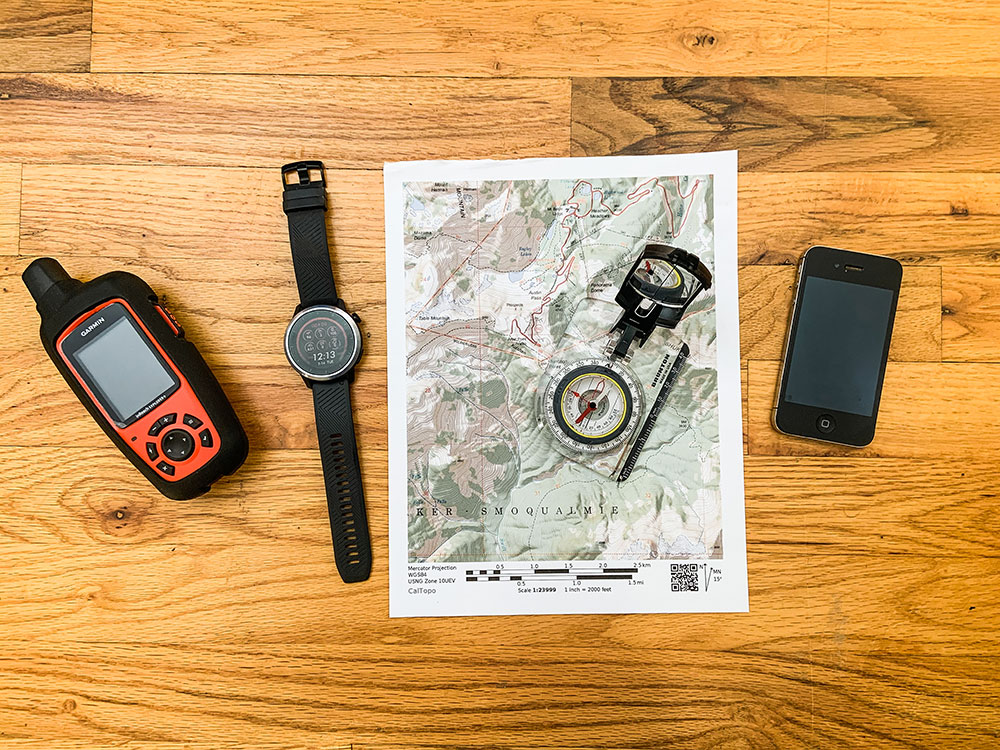
Back to Skills/Techniques | Back to Top
Uphill Travel Techniques
A big part of traveling in the backcountry is learning to be efficient on the uphill. Learning how to do rounded, AVA, and multiple types of kick turns allows you to travel through terrain without entering the “V of Doom.” If you’re curious about skinning techniques that includes transitions and ski crampon use, check out our blog on Backcountry Skiing Skinning Techniques. For travel strategies to help keep the group traveling safely together, check out our Travel Techniques for Backcountry Skiers post.
Back to Skills/Techniques | Back to Top
Downhill Techniques
Once you transition to downhill in the backcountry, things can go wrong in a hurry. Though there are many incidents where travelers are caught in avalanches on the up-track, the majority of accidents happen on the downhill. Where you’ve hopefully been traveling pretty close together and utilizing the uphill travel techniques above appropriately, it’s much easier to spread out and lose each other once gravity is on your side. Skiing or riding downhill is really fun… so enter the human factor again. Below are some common travel strategies to help manage folks through the terrain.
- Eyes On
- One At A Time
- Safe Zones
- Easing Into Terrain
- Fencing
- Buddy System
- Stacking Tracks
- The “Yell-a-pillar”
- Short Pitches
- Long Pitches
- Leap-frogging
Not sure what these techniques are? Check out our blog on Travel Techniques for Backcountry Skiers to get full descriptions of each.
Back to Skills/Techniques | Back to Top
Backcountry Skiing Planning Resources (When and Where do I go?)
“A goal without a plan is just a wish”
One of the most common questions we get after courses is “where should I go skiing or riding?” Thankfully, there is endless terrain for us to explore in Washington — especially if you have a brap-brap machine AKA Snowmobile. If you can ride even a tenth of the terrain in the state available to ride in your lifetime, hats off to you. The Cascades are gnarly. You can have all the beta on a route and still get shut down if you go at the wrong time. To that end, this section will be all about the resources available to show you not just where you can go, but nail it with appropriate timing.
Your Avalanche Center | Run Lists | Guide Books | Mapping/Navigation Resources | Weather Resources
Your Avalanche Center
In the United States, you can find your local Avalanche Center by going to Avalanche.org. Avalanche.org connects the public to avalanche information and education in the United States. They are partnered with the American Avalanche Association (A3) and the US Forest Service National Avalanche Center (NAC). The site consolidates data from professional forecast centers to provide real-time avalanche information.
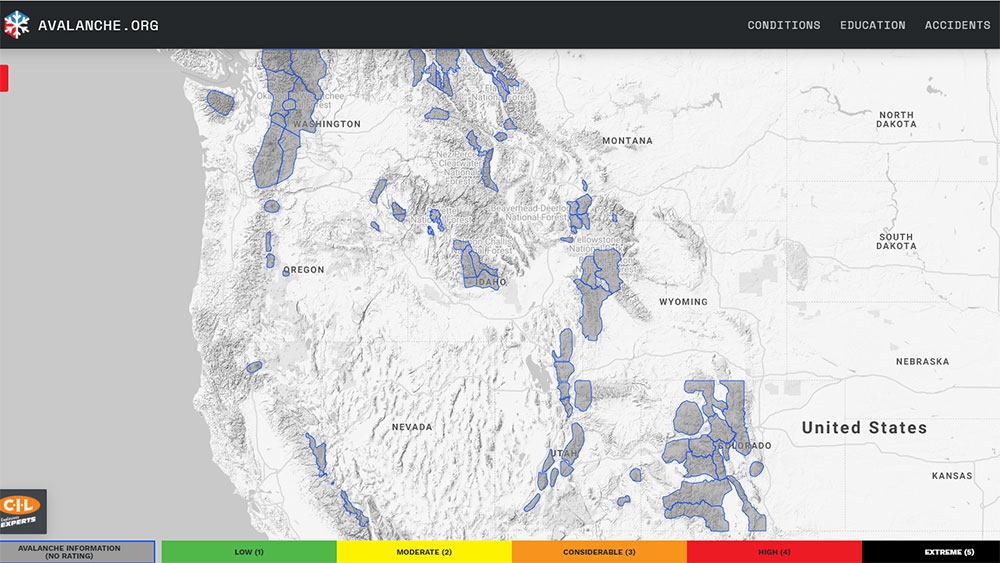
In Canada, you can go to Avalanche Canada for information on avalanches.
Avalanche Danger Scale
The North American Avalanche Danger Scale is a tool used by avalanche forecasters to communicate the potential for avalanches to cause harm or injury to backcountry travelers.
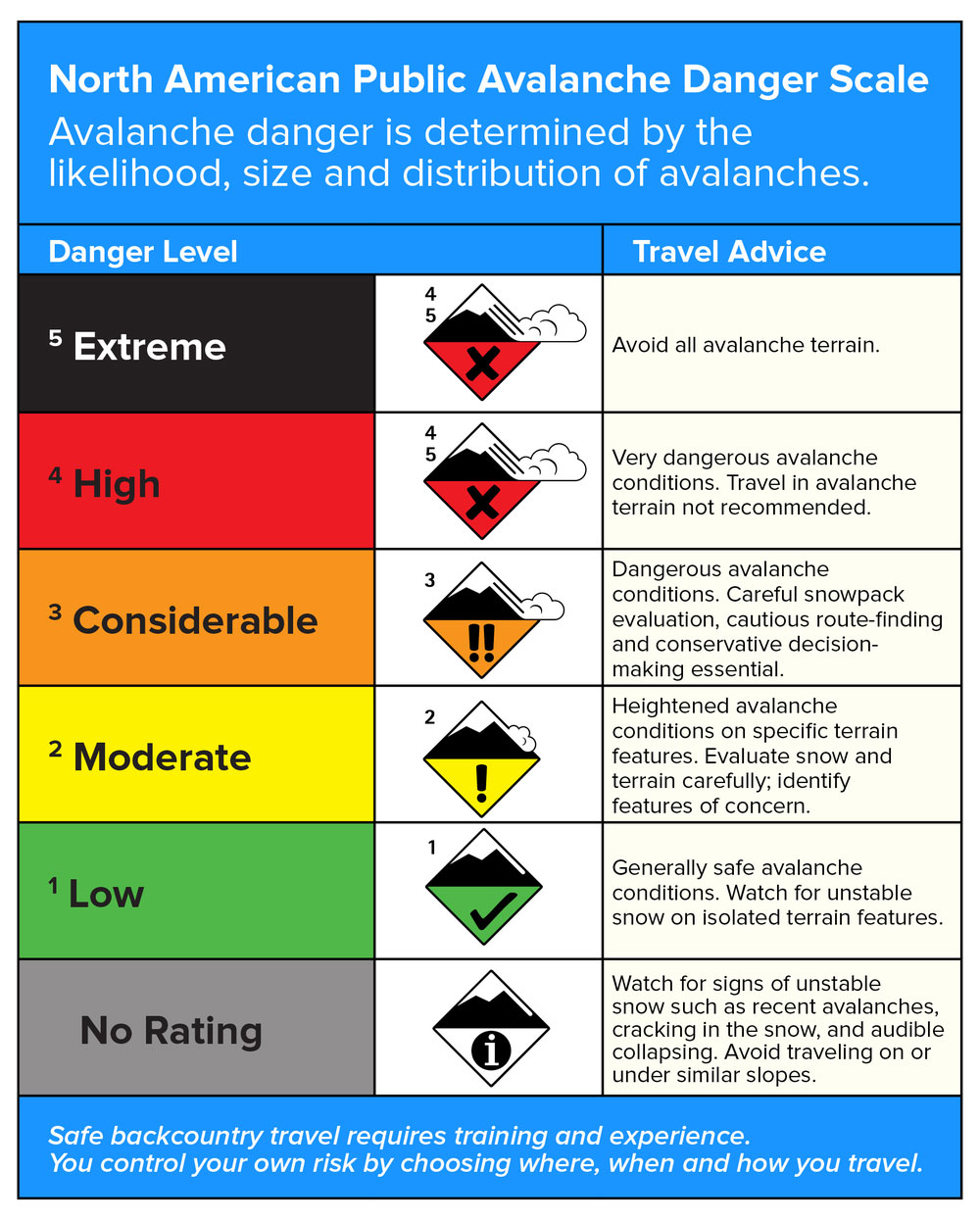
Avalanche Problems
Not all avalanches are the same. In order to communicate the distinct personalities of avalanches, experts identified nine distinct problem types you could encounter on any given day in the backcountry. These are:
- Loose dry
- Loose Wet
- Wind Slab
- Storm Slab
- Wet Slab
- Persistent Slab
- Deep Persistent Slab
- Cornice Fall
- Glide Avalanche
To learn about the different types of avalanche problems, check out our Avalanche Problems blog.
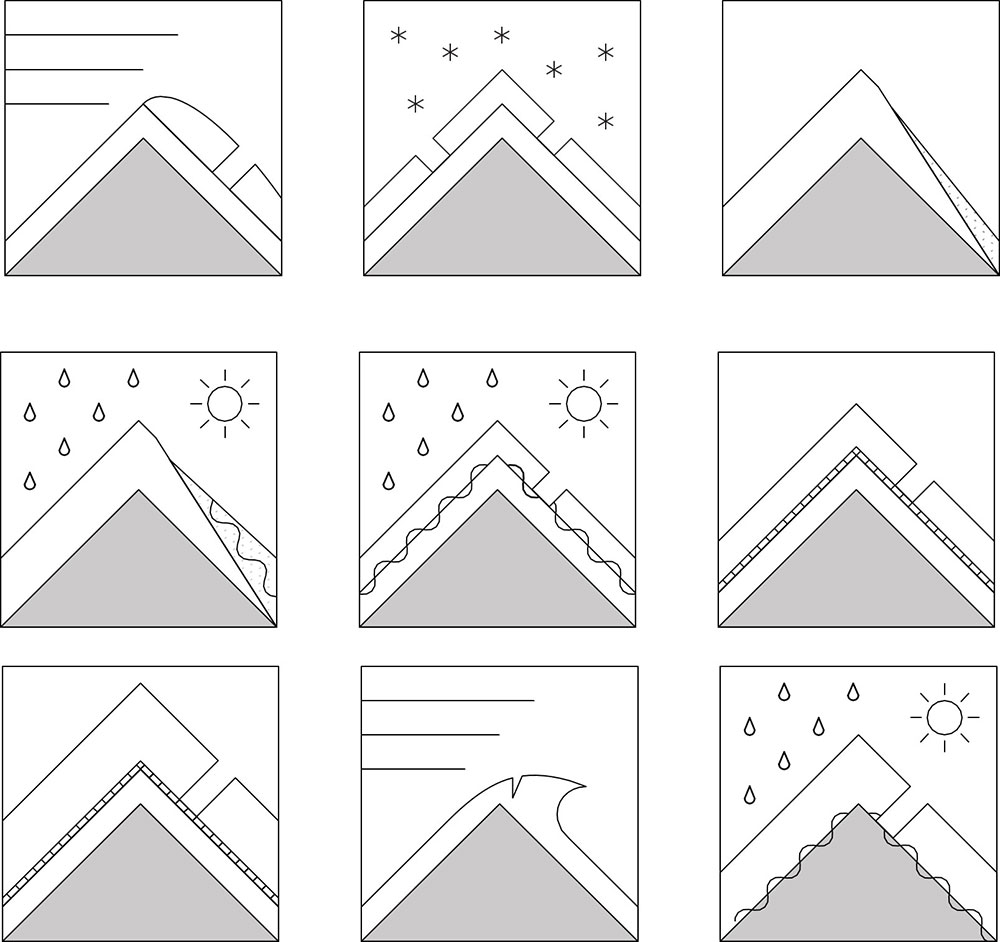
Back to Resources | Back to Top
Run Lists
Run lists create a structured process for assessing terrain. They often include maps, photos, satellite imagery, and other resources with common runs drawn in and labeled. Maps help us determine distances, elevation changes, and slope angles. Imagery allows us to build familiarity with terrain, and identify areas of concern in much greater detail. Labels, or names, allow us to communicate our terrain choices clearly. The goal is to sit down before a day of backcountry skiing or snowboarding, assess the avalanche hazard, and rate each potential run as either open or closed. Once in the field, further observations can be used to close open runs. However, a run that is closed at any point cannot be re-opened. Those are the rules.
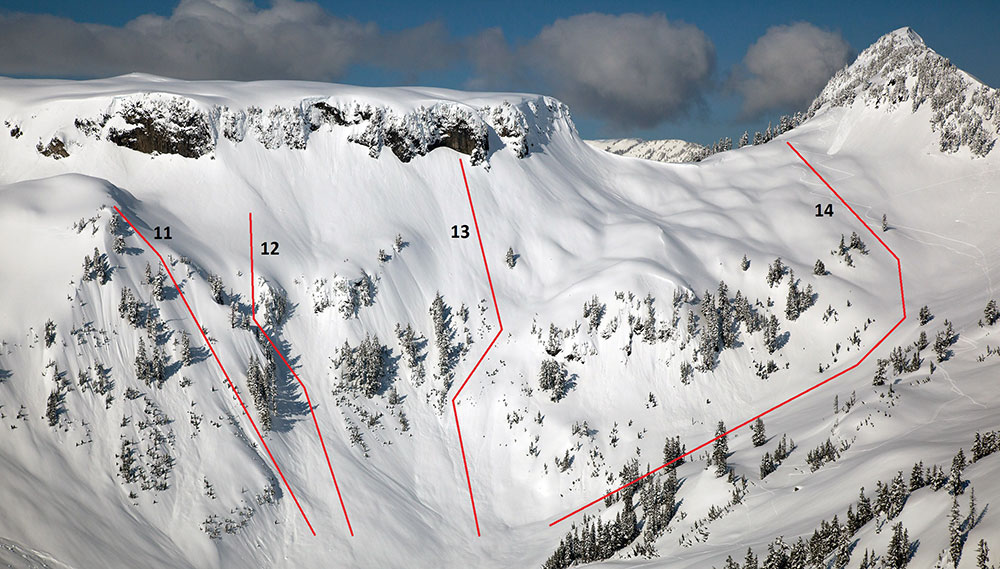
Check out our blog on Operational Run Lists to understand how to utilize them as a resource.
Back to Resources | Back to Top
Guide Books
Backcountry Ski & Snowboard Routes Washington by Martin Volken
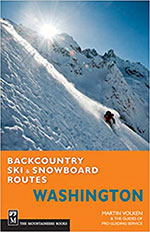
Backcountry Ski & Snowboard Routes Oregon by Christopher Van Tilberg
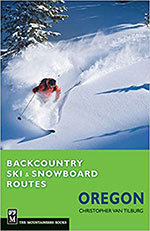
Backcountry Skiing: Skills for Ski Touring and Ski Mountaineering by Martin Volken, Scott Schell, and Margaret Wheeler
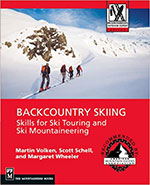
Staying Alive in Avalanche Terrain By Bruce Tremper
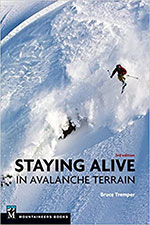
Snow Sense: A Guide to Evaluating Snow Avalanche Hazard by Jill Fredston
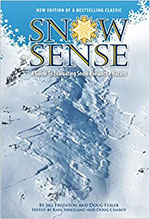
The Avalanche Handbook by David McClung and Peter Schaerer
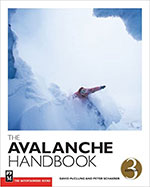
Back to Resources | Back to Top
Mapping/Navigation Resources
CalTopo allows you to build your own routes and run lists with multiple overlays from slope angle shading to sun exposure. You can also get all the terrain statistics from your routes including elevation change and loss, ground cover, total distance, and more. Then, you can make PDFs of your maps, print them, or upload tracks to your phone or GPS via their app. Some of the pro features and overlays cost money, but the base application and package is free!
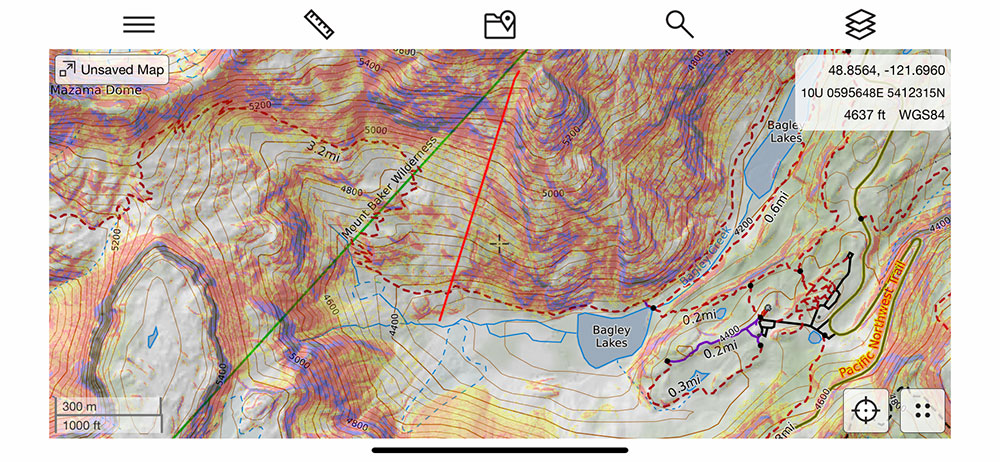
Back to Resources | Back to Top
Gaia is quite similar to CalTopo, but is a yearly subscription. It’s track or route building is not as refined as CalTopo, but it’s tracking features in their phone application is fantastic for turning your smart phone into a GPS. Also, there are tons of community tracks you can explore to see where folks are climbing and how they are accessing certain terrain. If the tracks are public, you can download them and save them to your own devices, saving you the trouble of creating the track yourself! Gaia also allows you to upload photos and tag their exact locations for more detailed trip reports.
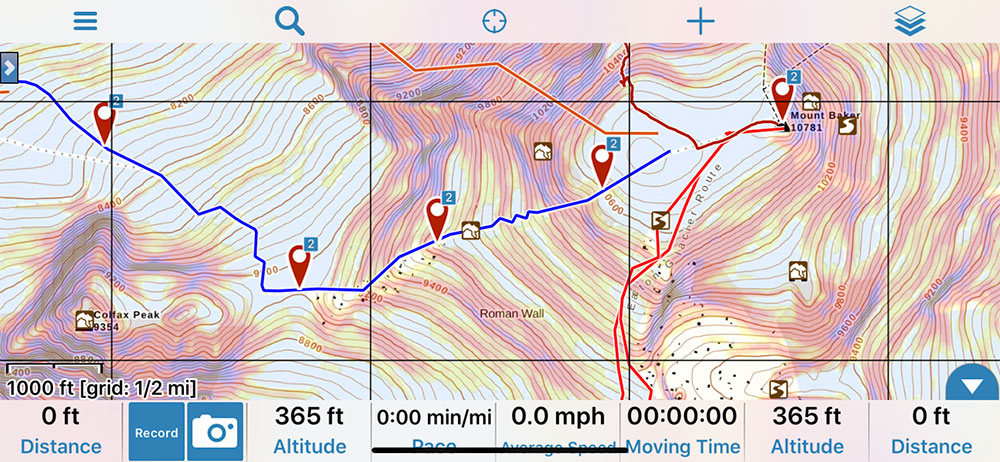
Back to Resources | Back to Top
Weather Resources
Windy is a fantastic tool for weather forecast visualization. This fast, intuitive, detailed accurate weather app is the most up-to-date weather forecast around. It brings you all the world’s leading weather forecasting models: global ECMWF and GFS, plus local NEMS, AROME and ICON (for Europe) and NAM (for the USA) so you can compare forecasts. 40 weather maps from wind, rain, temperature and pressure to swell or CAPE index.
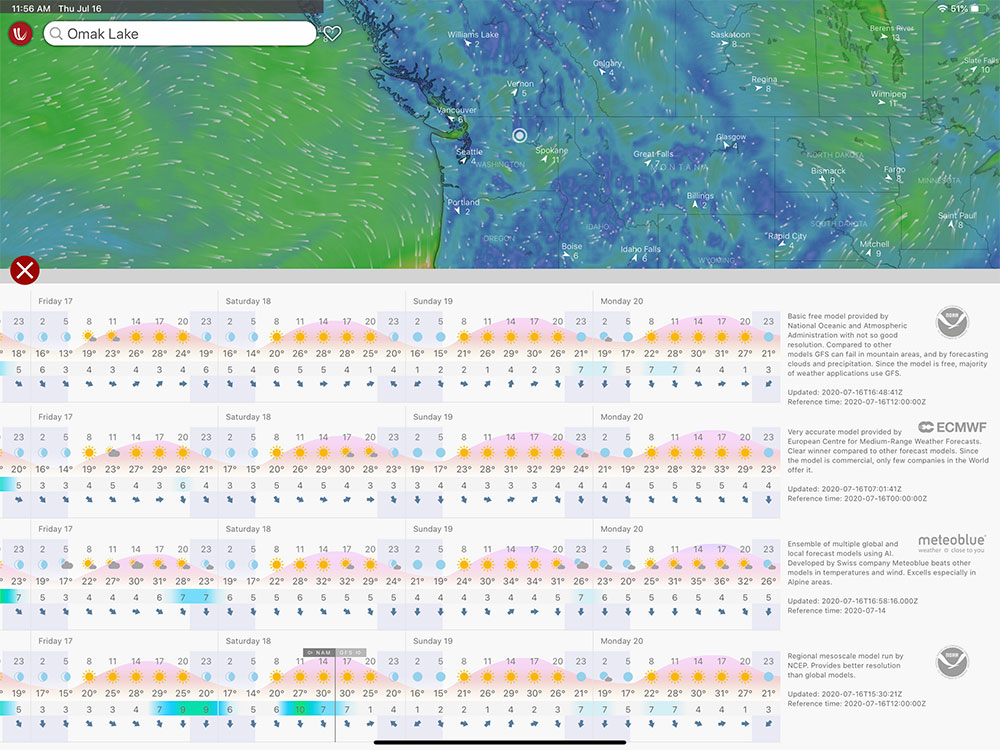
NWS provides weather, water, and climate forecasts and warnings for the United States, its territories, adjacent waters and ocean areas, for the protection of life and property and the enhancement of the national economy. These services include Forecasts and Observations, Warnings, Impact-based Decision Support Services, and Education in an effort to build a Weather-Ready Nation. The ultimate goal is to have a society that is prepared for and responds to weather, water, and climate events.
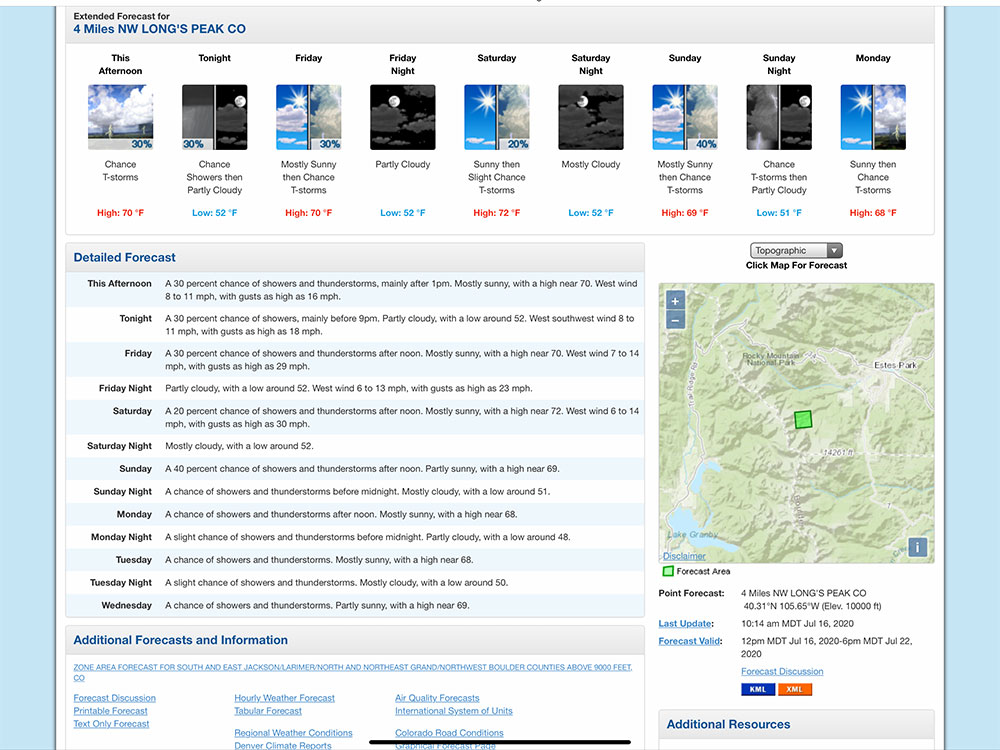
Most avalanche centers are tasked with developing a mountain weather forecast as well as an avalanche forecast. In fact, the mountain weather forecast is used to inform the avalanche forecast. Weather creates snowpack which creates avalanche hazard.
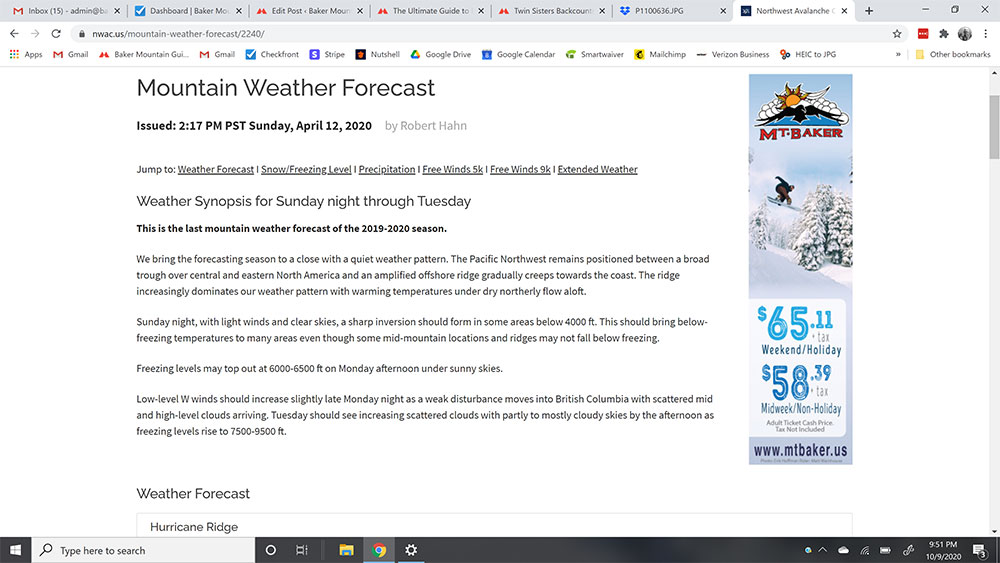
The nice thing about avalanche center forecasts is that they are developed specifically for the mountains, as opposed to NOAA, which produces forecasts for population centers. NOAA’s point forecast tool uses an algorithm to estimate the forecast at any point on a map, but it’s not as good as real life meteorologists building weather forecasts specifically for the mountain pass where you are planning on backcountry skiing or riding.
Most avalanche center websites conveniently link to weather station data for commonly used areas within their forecast zone. Every hour you get up to date information for precip totals, max/low/avg temps, wind speed, and so on. You can find the weather station nearest where you are traveling and get real-time numbers of what is actually happening out there.
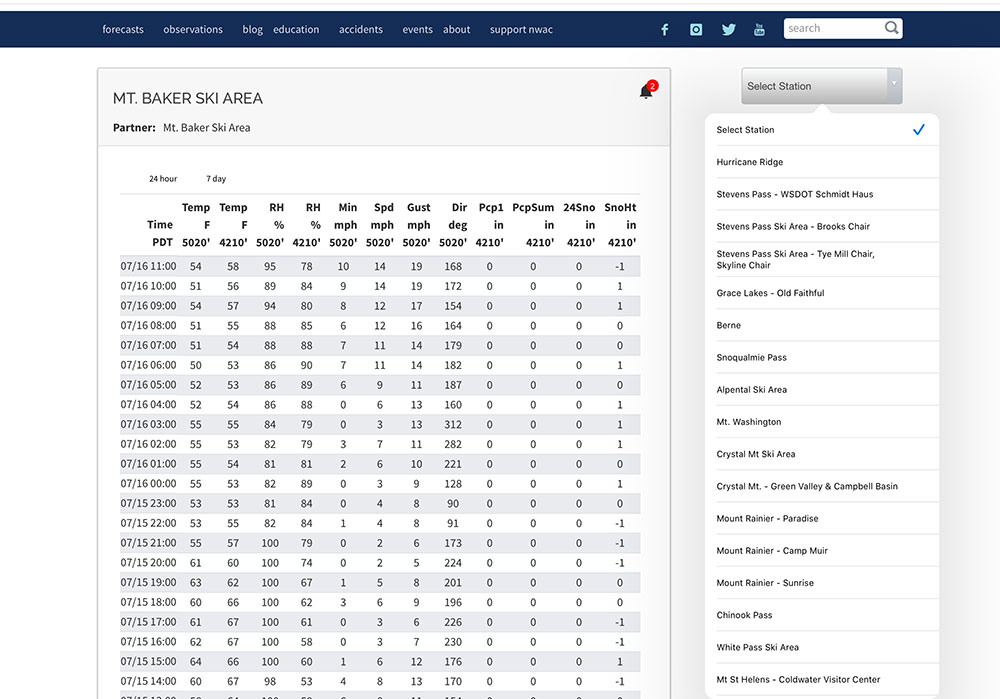
Not every single weather station is listed on avalanche center websites. In fact, in the Mount Baker region, NWAC only lists one of the three local telemetry stations. SNOTEL data allows you to see real-time numbers from telemetry sites all over the United States including Alaska. Precipitation, temperatures, Snow Water Equivalent (SWE), Snow depth, etc. The information may not be presented in a format that is as user friendly as the avalanche center, but it’s all there.
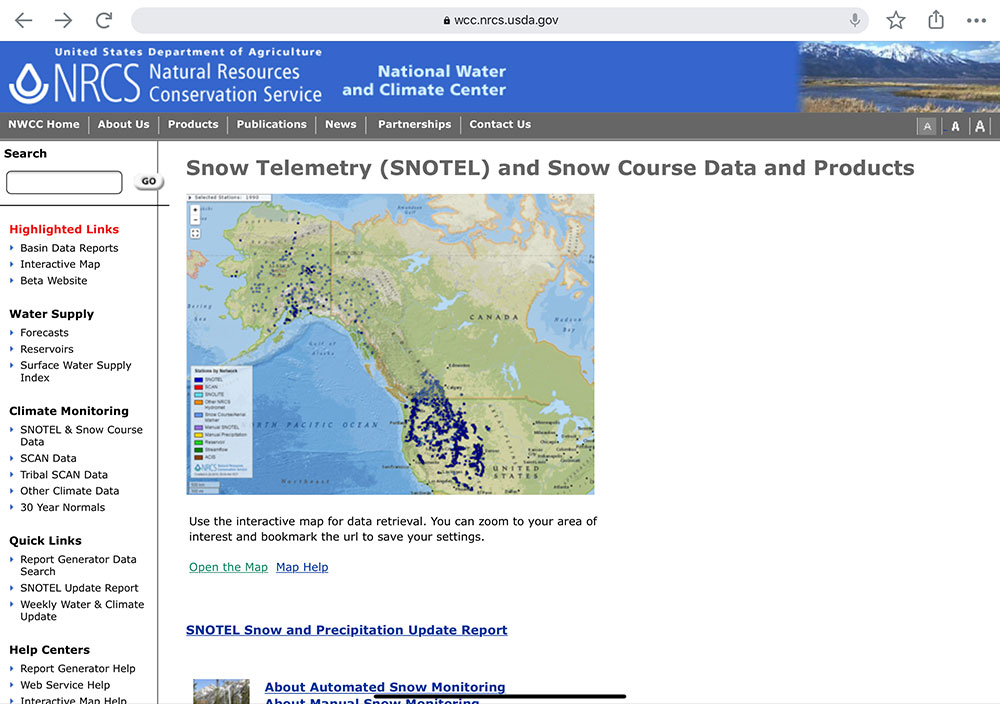
Back to Resources | Back to Top
Mountain Ethics (How do I recreate responsibly?)
“When we see land as a community to which we belong, we may begin to use it with love and respect…. That land is a community is the basic concept of ecology, but that land is to be loved and respected is an extension of ethics.”
Reimagining Recreation
At Baker Mountain Guides we sell recreation. We sell fun, even if it is Type II fun. We encourage people to get outside, to move across the lands, to explore, and help them achieve their goals. We practice Leave No Trace and we pack out our poop. That’s not enough anymore. We can all feel the pressure of all the humans in the backcountry. The desire to push our bodies farther and farther out on the land. We like to remind ourselves that our playground is someone else’s home.
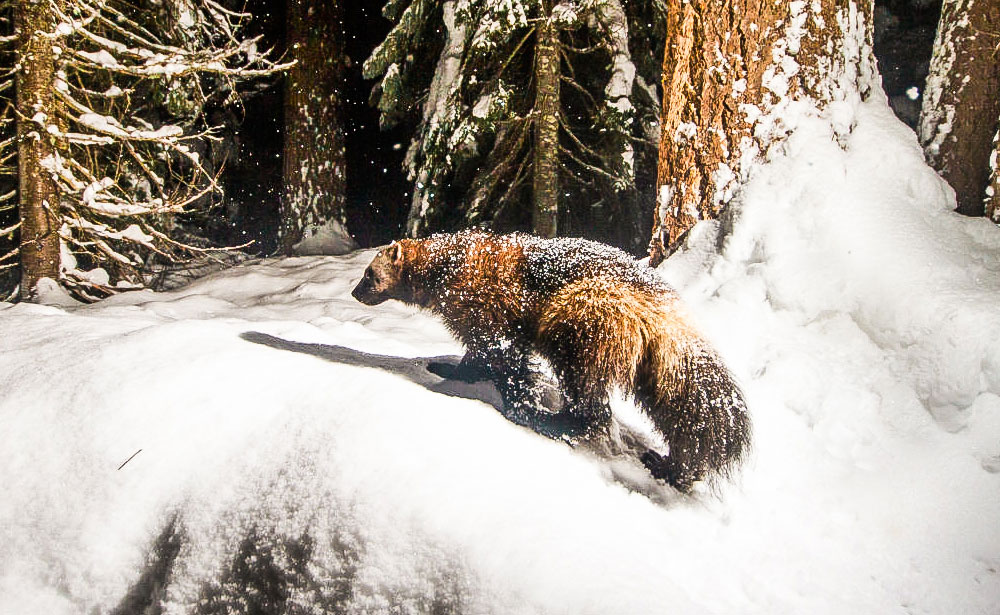
Photo by David Moskowitz – Cascades Wolverine Project
We invite you to engage in a conversation with us on how we can reimagine recreation together. You can start by reading Reverence, Respect, Reciprocity: A Sustainable Future for Recreation. Then send us an email or leave us a comment with your thoughts!
Trail Etiquette
Say you’re going up an established skin track and a group of bandit snow-shoers are decending upon you like an unruly pack of cackling cayotes clutching White Claws. Who has the right of way? How can you engage with other users in a respectful way that benefits everyone? Check out our blog on Winter Backcountry Trail Etiquette.
Continued Education (How do I get better?)
“Education is a progressive discovery of our own ignorance.”
Avalanches Don’t Care
There’s no replacement for hands-on experience with certified professionals for getting better at anything. If you’re learning to fly a plane, you don’t just read a book about being a pilot, play flight simulator on the computer a few times and then jump in a real plane, confident that you can fly. If you tried this, you might get away with it, but odds are you’re playing with COVID (Too soon)?
Instead, you go up with a certified flight instructor who can teach and mentor you as well as be a safety net if things go wrong. In any activity where your life is potentially forfeit for a wrong decision, you should try to stack the odds in your favor as much as possible. Like it or not, the majority of backcountry skiing and riding takes place in avalanche terrain, and avalanches don’t care if you’re highly ignorant or highly skilled. They just are. Knowing where they are and how to avoid them as well as how to respond in case of an emergency is essential. So here’s a list of courses available to you to continue your education and make sure you’re set up for success.
Recreational Level 1 and 2 | Professional Level 1 and 2 | Avalanche Rescue Course | Backcountry Skiing Courses | Wilderness First Aid/Responder (WFA/WFR)
Avalanche Courses: Recreational Level 1 and 2
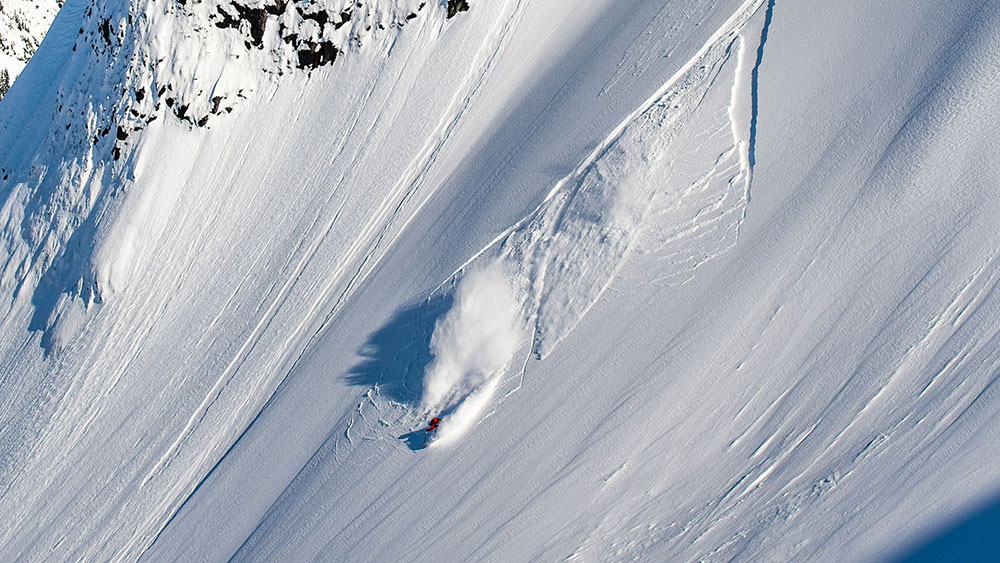
AIARE Level 1 Avalanche Course
The AIARE Level 1 Avalanche Course is designed to provide you with a foundational understanding of avalanches, observational and decision-making techniques, avalanche terrain assessment, and companion rescue. Along with learning the science and theory behind the avalanche phenomenon, you will be challenged to apply your new skills in the backcountry.
AIARE Level 2 Avalanche Course
The AIARE Level 2 Avalanche Course is designed for experienced backcountry skiers and snowboarders looking to improve their evaluation of critical avalanche hazard assessment factors. The 3-day curriculum focuses on advanced observational techniques and prepares you to lead backcountry tours in more complicated terrain and snow conditions.
Back to Education | Back to Top
Avalanche Rescue Course
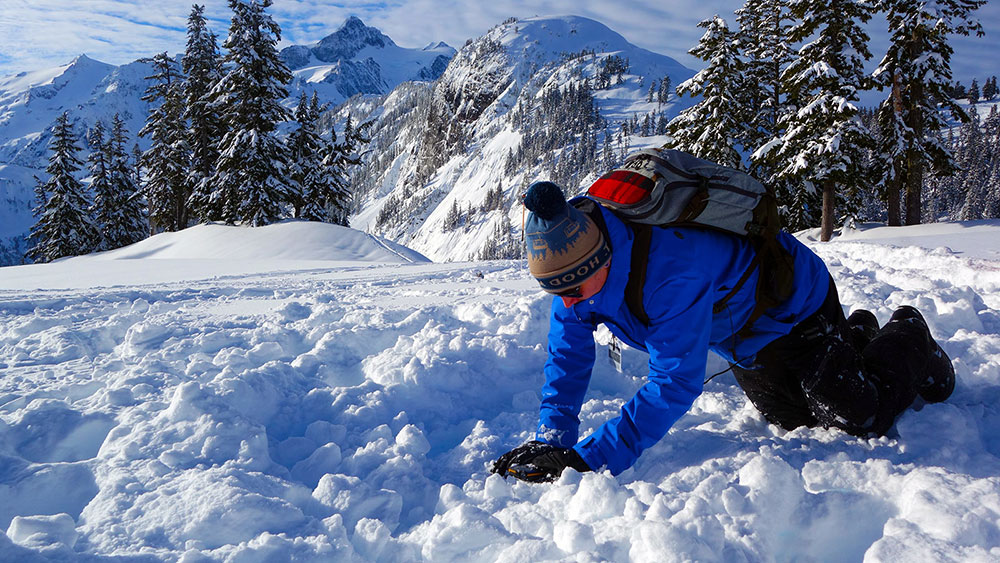
The AIARE Avalanche Rescue Course is a pre-requisite for both the AIARE Level 2 Avalanche Course, and the AIARE Pro 1 Avalanche Course. Students can expect to learn fundamental avalanche rescue skills for both single and multiple burials. Instructors will facilitate realistic practice scenarios, and provide mentorship and feedback.
Back to Education | Back to Top
Avalanche Courses: Professional Level 1 and 2
Professional level courses are be run directly through AIARE and other AAA approved providers. You will begin your professional avalanche education with the Professional Avalanche Training 1 course. The AIARE Level 1 and the AIARE Avalanche Rescue Courses are pre-requisites for the Pro 1.
Professional Avalanche Training 1
The Professional Avalanche Training 1 Course is designed for entry-level avalanche professionals, or those seeking employment in the avalanche industry. The Professional Avalanche Training 1 is similar to the old AIARE Level 2, but allows more time for students to develop their standardized observational skills, recording methods, and operational decision making. The Pro 1 is 5 days in length and includes an examination at the end of the course to ensure student competency.
Professional Avalanche Training 2
The Professional Avalanche Training 2 course replaces the old AIARE Level 3. Pre-requisites for the Pro 2 include the AIARE level 1, AIARE Avalanche Rescue course, and Pro 1.
From the AAA: Professional Avalanche Training 2 (Pro 2) is designed for developing avalanche professionals with several seasons of applied professional experience. This course focuses on skills and proficiencies that enable the student to step into a leadership role within an operational avalanche program. The student will be taught proficiencies to develop operational risk management decision-making skills, including forecasting, risk mitigation strategies, and professional communication.
Check out our blog on the Pro/Rec Split for avalanche courses to understand which path is right for you.
Back to Education | Back to Top
Backcountry Skiing Courses
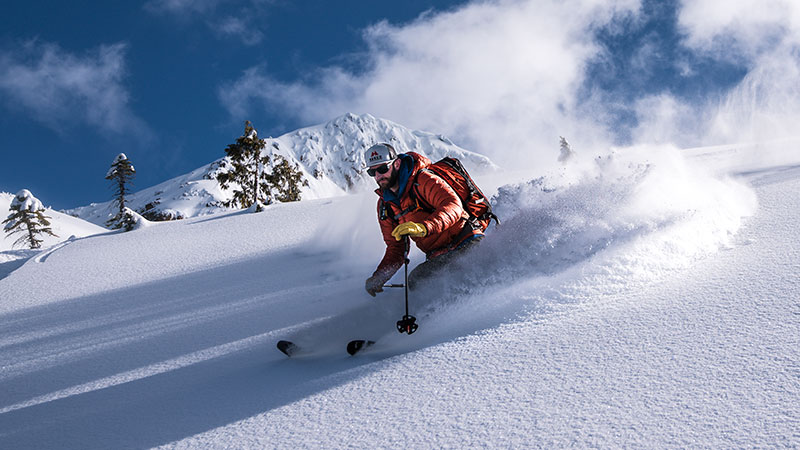
All our backcountry skiing and ski mountaineering courses are broken up between Tech Courses and Pro Courses. Tech Courses are designed to provide specific technical knowledge in a short course format. Pro courses, on the other hand, are for recreationists wanting to operate at a professional level. Below are our five available backcountry skiing and mountaineering courses.
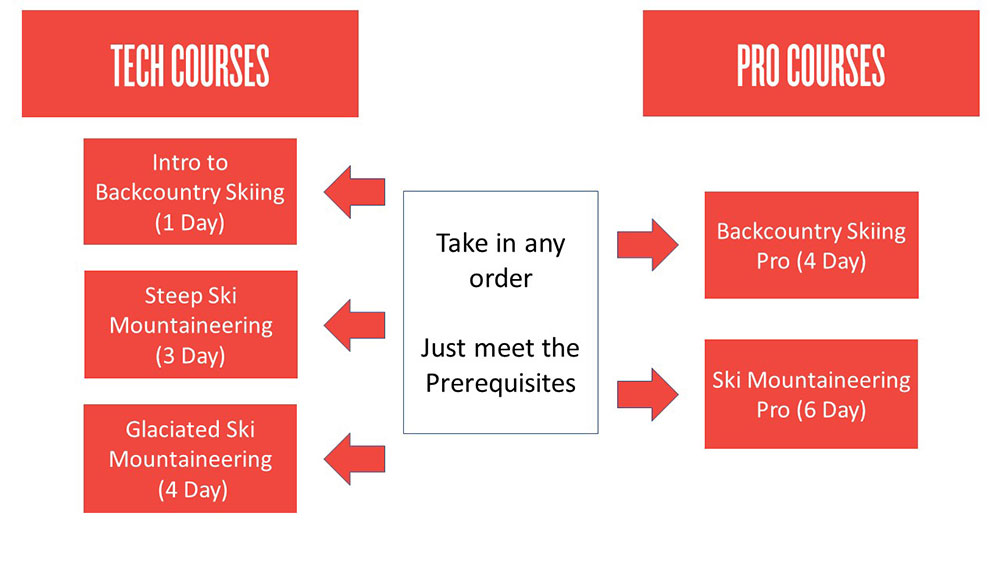
These courses are designed to be taken in any order as long as you meet the prerequisites. Below is a brief explanation of Tech vs Pro courses. For a full breakdown of these courses, check out our Backcountry Skiing Courses page.
TECH COURSES
Tech courses are designed for those seeking a concise and affordable approach to learning technical backcountry skiing and riding skills. From introductory skinning techniques to rappelling into couloirs, our tech series has you covered.
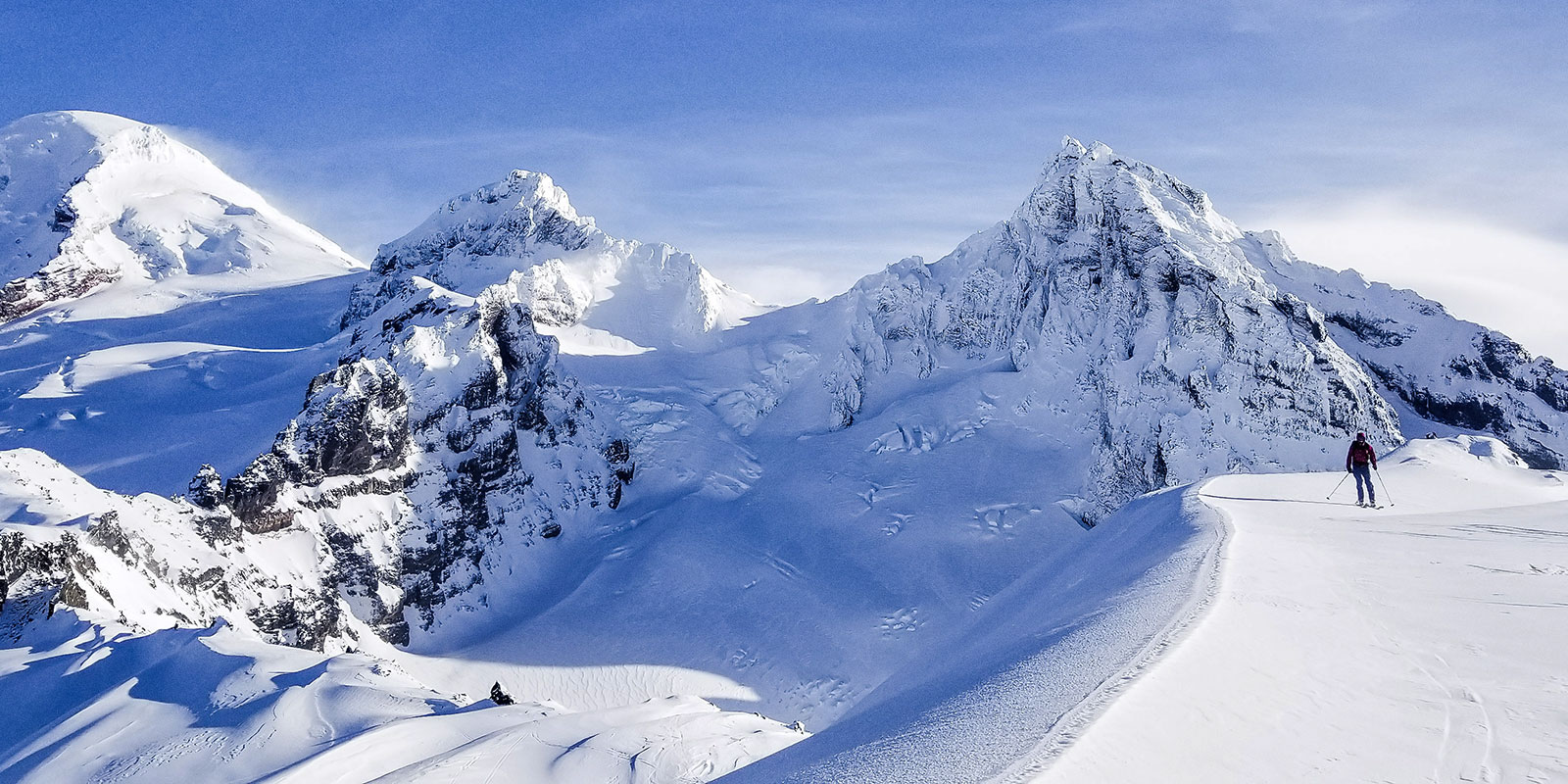
Our three Tech Courses are: Intro to Backcountry Skiing Course | Steep Ski Mountaineering Course | Glaciated Ski Mountaineering Course
PRO COURSES
Pro Courses are designed for recreationists wanting to operate at a professional level. The only certifying body in the United States for professional Mountain Guides is the American Mountain Guides Association (AMGA). If certification is not your goal, our courses offer a similar curriculum as these industry professional-level courses but tailored specifically to you, the recreationist.
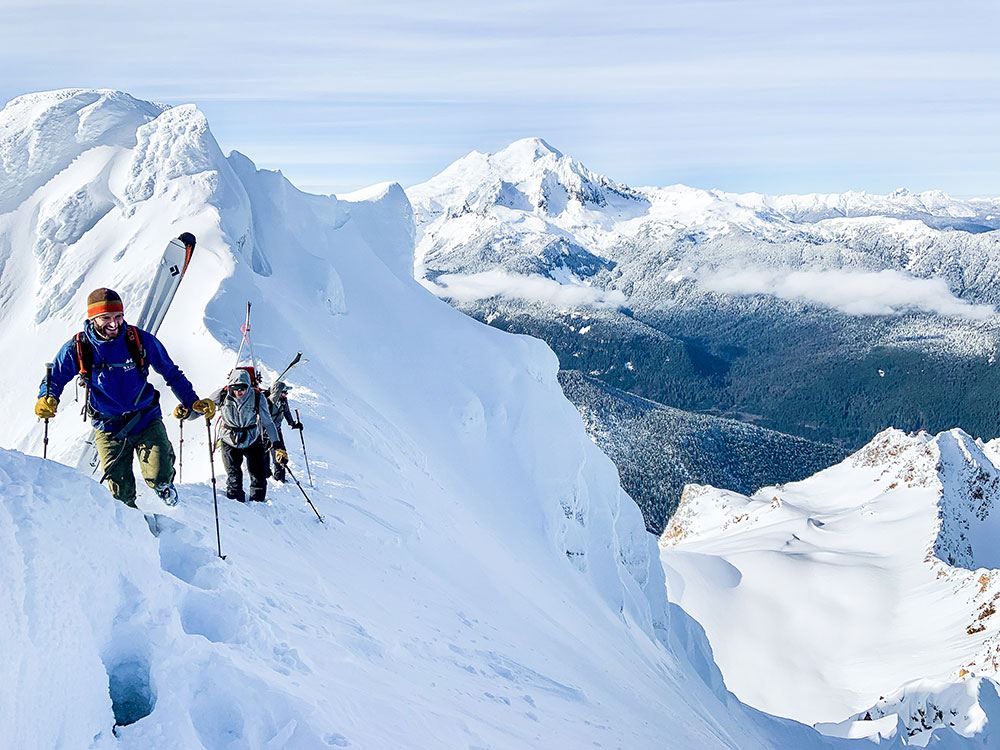
Our two Pro Courses are: Backcountry Skiing Pro Course | Ski Mountaineering Pro Course
Back to Education | Back to Top
Wilderness First Aid/Responder
If you are planning on traveling in the backcountry, you should have the skills to provide medical assistance. Since you will likely not have quick access to emergency care out in the wilderness, you are the first responder to any emergency. Thus, the Wilderness First Aid (WFA) and Wilderness First Responder (WFR people say “woofer”) courses.
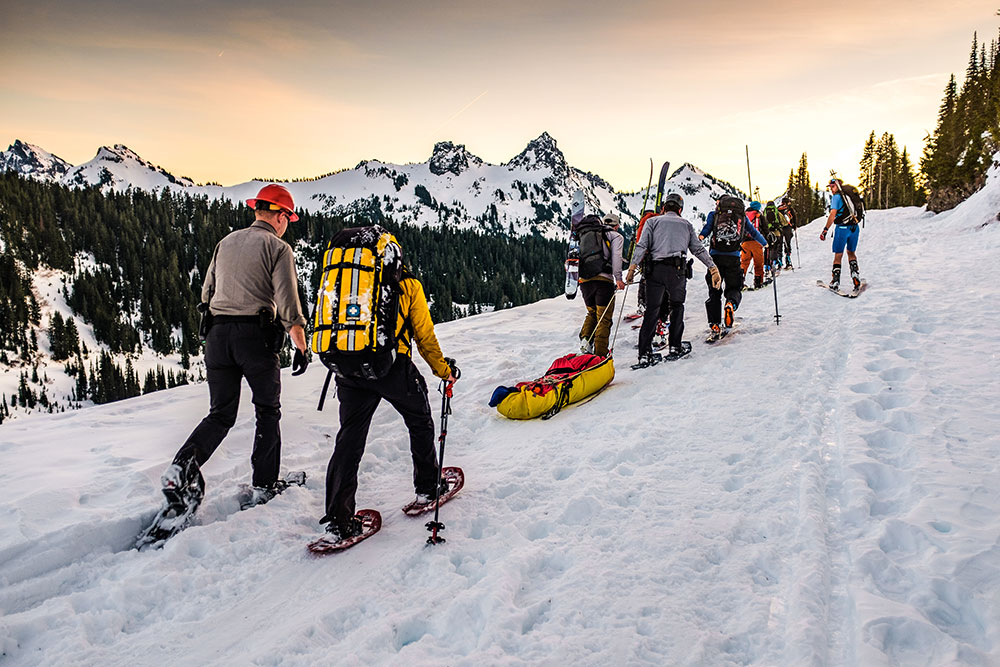
There are many providers of these two different courses. NOLS Wilderness Medicine is the most recognized and known for quality in the business, so we’ve linked them here, but Desert Mountain Medicine also delivers a really high-quality course, so check them out as well. As a small guide service, we like supporting fellow small businesses.
Wilderness First Aid
The Wilderness First Aid course is an introduction to wilderness medicine, taught over two or two and a half days. It’s great for some base knowledge if you recreate outdoors where EMS response can be expected in a timely manner (fewer than eight hours). “You’ll learn the Patient Assessment System, how to provide effective first aid treatments for injuries and illnesses common in the outdoors, and how to make appropriate evacuation decisions.” (NOLS WMI) The course consists of indoor and outdoor components and is a lot of experiential learning through the use of scenarios.
Wilderness First Responder
The Wilderness First Responder Courses are the industry standard for professional guides, trip leaders, search and rescue team members, outdoor recreationists, and international travelers, but they are fantastic knowledge for anyone that plans to travel to more remote locations where access to care is greater than eight hours. After the 9-10 day course, “you will be able to conduct a thorough physical exam, obtain a patient history, assess vital signs, provide emergency care in the wilderness, and make crucial evacuation decisions.” (NOLS WMI)
Back to Education | Back to Top
Whiteout
Navigation
Whiteout Navigation
Whether you are a backcountry skier or mountain climber, learning the basics of whiteout navigation is essential for off-trail travel in the mountains. This post presents tools, strategies, and techniques to keep in your quiver for those low visibility days.
This post has two main sections:
1. Where to Move (Tools for knowing where to go in a whiteout)
Whiteout Navigation Plan | Navigation Tools
2. How to Move (Strategies and techniques for how to travel and stay on course)
Handrails | Bearing Off | Travel Techniques
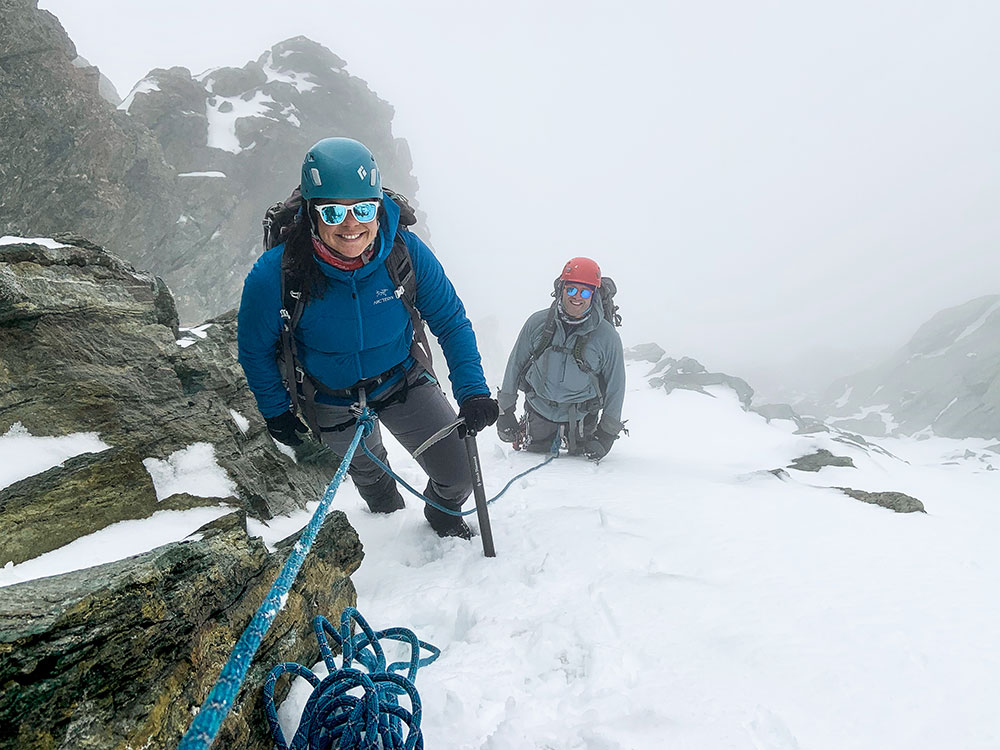
Where to Move
If you get caught out in a whiteout, especially in glaciated or snowy terrain with no distinguishable terrain characteristics, it’s easy to become disoriented. Heard the phrase “inside the ping-pong ball?” Below are the things you need to know to make the best decision on where to navigate.
Whiteout Navigation Plan
The easiest way to know where to navigate in a white-out is to be proactive and have a whiteout navigation plan. These plans can be as complex and detailed as you’d like but need at the core three main details: Waypoints, Bearings, and Back Bearings. Below is an example of a complex whiteout navigation plan that also includes UTMs, distance, elevation, and munter rates. Curious how to make complex tour plans? Check out our Backcountry Skiing Pro Course for backcountry skiers and riders.
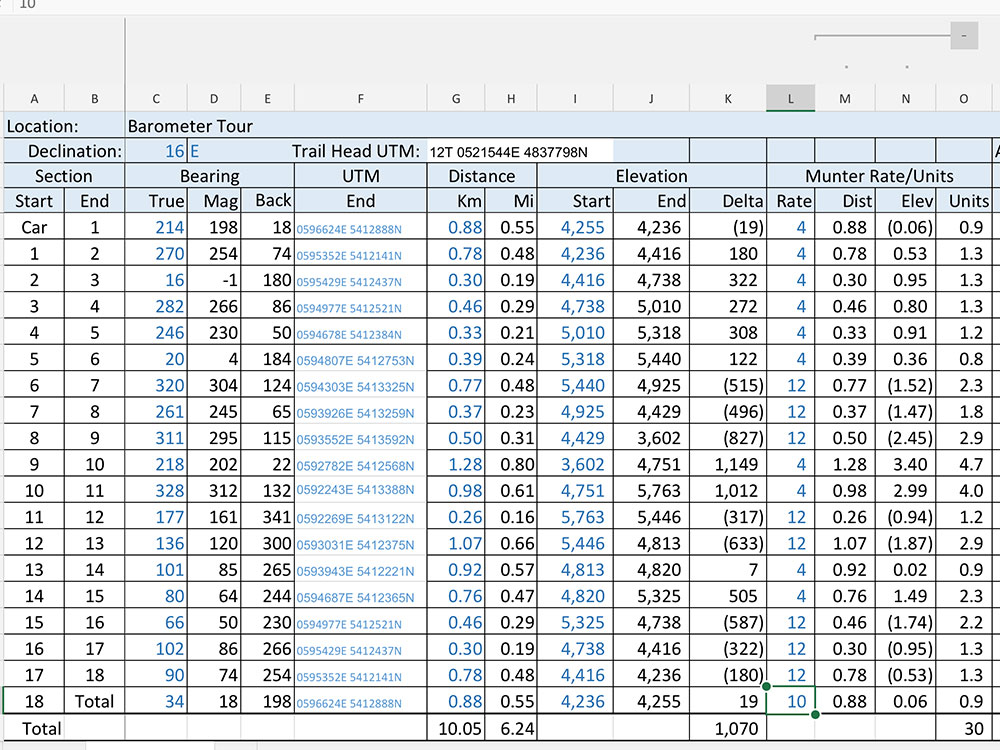
Waypoints
Waypoints are points placed along your route at regular intervals that are used for navigation. Think of them like a trail of bread crumbs you can use to navigate through terrain and then also get back home. Ideally, waypoints are placed at the start and end objective of your route, and anywhere a change in direction is required.
They also work best at obvious terrain features that you can’t miss. Those could be an individual tree or large boulder on a ridge, or a lake, cliff face, drainage, highway, or larger scale feature. Your goal is to go then from waypoint to waypoint to get to your objective and then reverse the waypoints to get back home.
Bearings
Where waypoints are the bread crumbs, bearings are how you navigate to the next bread crumb without getting lost. By recording the compass bearing in your plan to the next waypoint, you can be sure that you’re headed in the right direction (remember to adjust for declination). Don’t know how to take a bearing or what declination is? Check out our Backcountry Navigation 101 blog.
Back Bearings
Just as important as knowing your bearing to the next waypoint is the bearing back to the previous one. Back bearings get you home. Calculating the 180 degree opposite of your bearing to a waypoint gives you the back bearing. In the navigation plan above, you can see on line one that the bearing from the car to the first waypoint is 198 degrees. Therefore, 198-180 = 18 degrees for the back bearing.
Navigation Tools

GPS
There are cell phone applications now like CalTopo and Gaia that turn your cell phone into a GPS even in airplane mode. This can be a more affordable option than to drop hundreds of dollars on a stand-alone GPS unit. Drawbacks to using your cell phone as a GPS unit is battery life, cell phones die quicker, and usability in wet conditions (like a whiteout). Touch screens don’t really work well when wet.
Altimeter
There are quite affordable altimeter watches now that (if calibrated regularly) are quite accurate. Knowing your elevation is essential when navigating in a whiteout. A GPS will provide your elevation, but it’s nice to have a back up in case your phone or GPS unit runs out of battery.
Map
Have an analog backup to the technology. If you actually want to be able to use it in a whiteout, laminate the map or at least put it in a zip lock bag to waterproof it.
Compass
The ultimate navigation tool. Much easier than trying to pull out your cell phone or a GPS in a storm. If you did your homework and have a good whiteout navigation plan, then you just need to follow your compass bearing.
How to Move
Once you decide on where to go, here are some strategies and techniques to help keep the squad together and to where you need to go.
Handrails
These are obvious physical terrain features that you can use as a “handrail” to ensure that you don’t get off route. A creek or river, ridgelines, valley bottoms, couloirs, and roads are all obvious terrain features that you’ll recognize when you hit them, even in a whiteout. Below is an example of a ridgeline handrail (the railroad grade on the Easton Glacier route up Mount Baker). Even in a whiteout, as long as you don’t stray from the ridge, you’ll make it where you want to go.
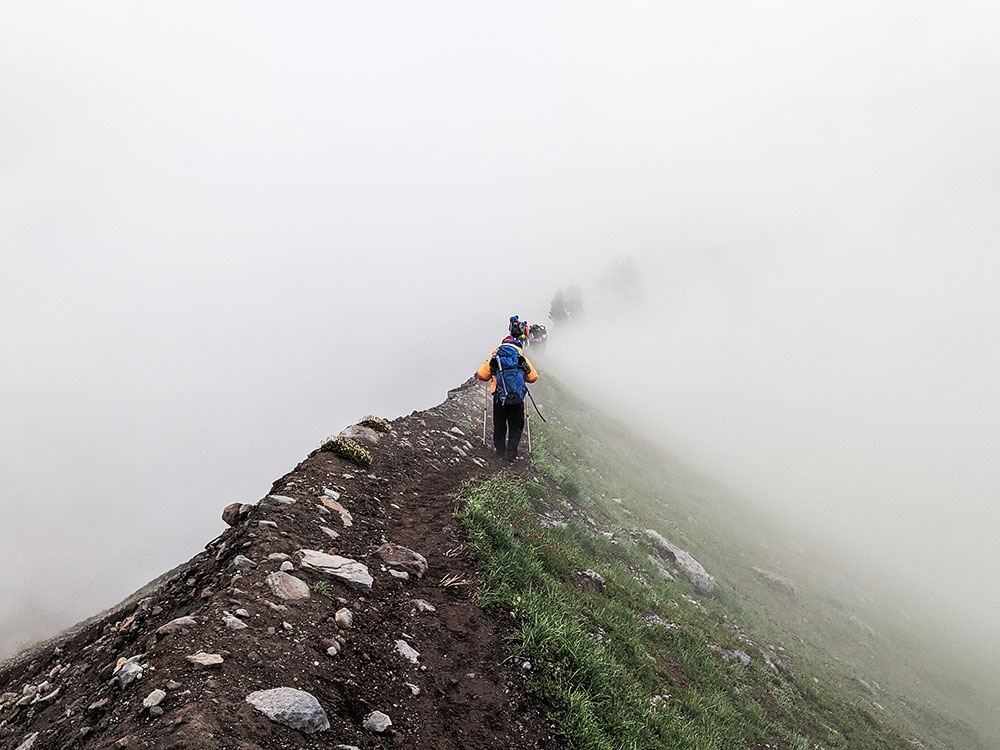
In the picture below, if trying to get from the saddle on the Coleman-Deming Route of Mount Baker (Waypoint in lower right) back to camp (Waypoint in upper left), it is important to avoid the center of the Coleman Glacier (Red) where it is heavily crevassed. By using the Heliotrope Ridge (Yellow) as a “handrail”, you can make sure that you’re headed in the right direction by keeping the ridge in sight on the left as you travel downhill (Green).
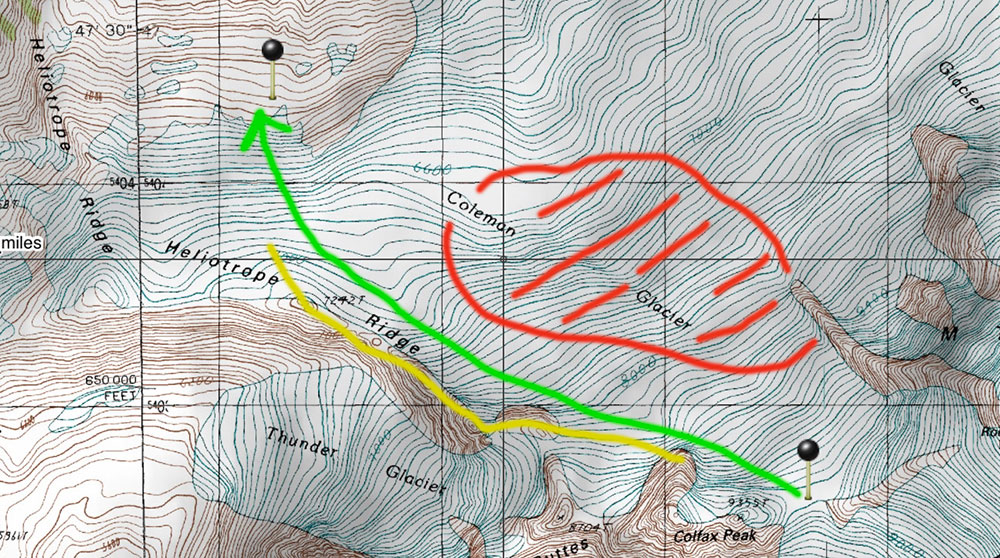
Bearing Off
This is a technique where you intentionally take a bearing that is a few degrees off of your true desired destination in order to hit an obvious handrail feature that ensures you won’t miss your destination. In the example below, in glaciated terrain, we took a bearing that was intentionally off (green) in order to hit the ridge feature where we needed to change direction. If we missed the ridge feature (red), we’d end up out in the middle of the ice field with no physical handrails to know where we were.
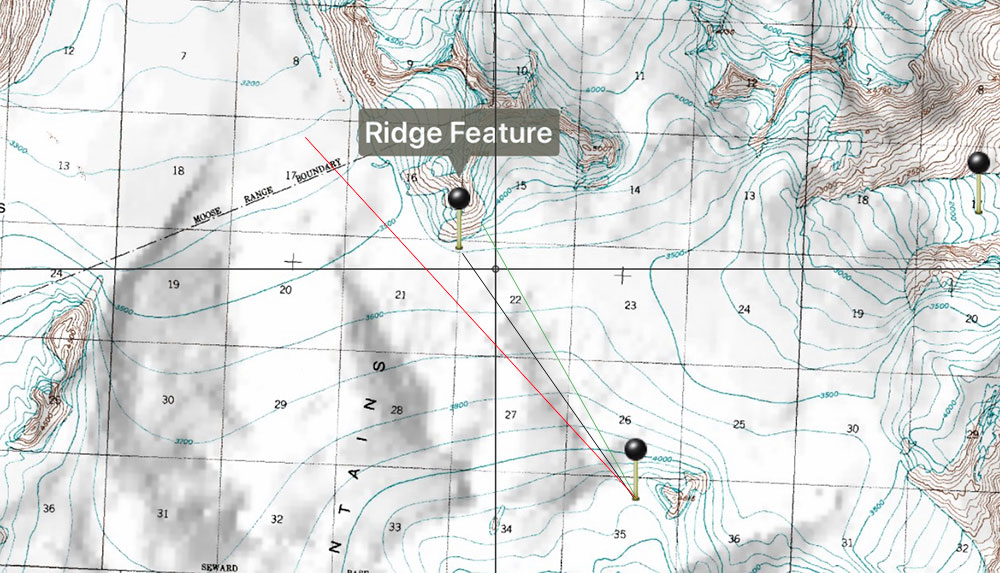
Travel Techniques
Iron Caterpillar
Make this your default uphill technique for ensuring the squad stays together in whiteout conditions. It’s pretty self-explanatory: Stay just behind the person in front of you (tip to tail if you’re on skis), and, like Ludacris says: “When I move you move”. Just like that.
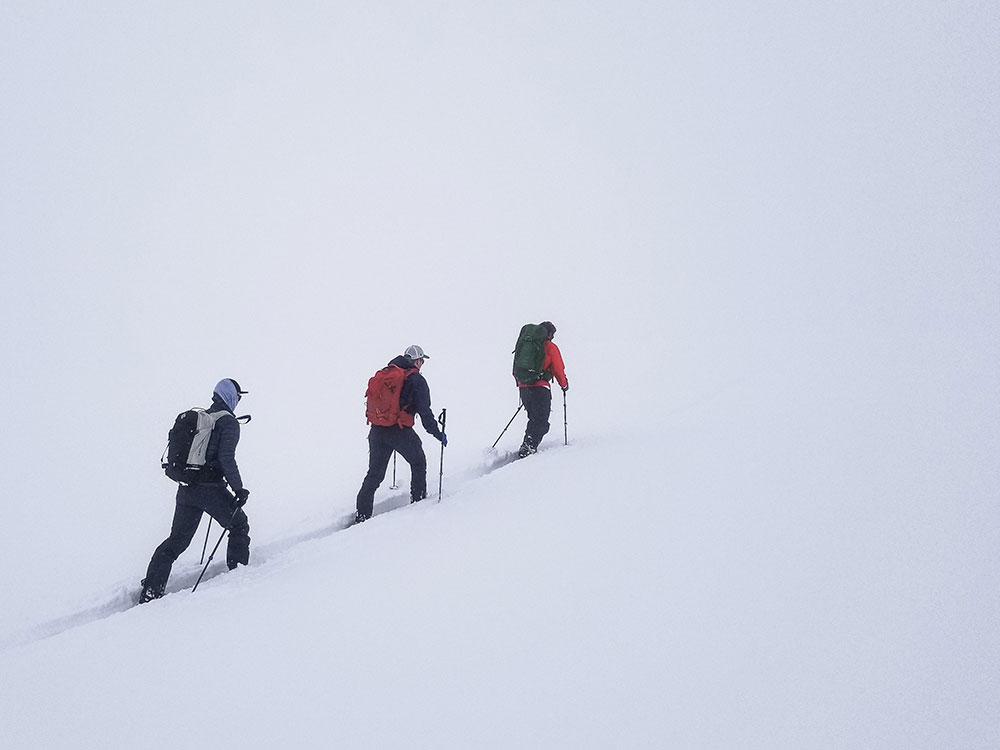
Check the Leader
On flat terrain, most folks travel in circles thinking they are walking in a straight line. To combat this, travel in your iron caterpillar and have the last person carrying a compass and the first person acting as a reference point. Regularly check the compass bearing against the leading person and adjust their direction left or right as required.
Only two of you? Have the leader walk while the rear person stands still and holds the bearing. Instruct the leader where to go to be in line with the bearing and have them stop when they’re almost out of sight. Then Catch up to them, reacquire the bearing, and repeat.
Physical Markers
A common backcountry skiing and riding trick to be able to ride in whiteouts is to place some sort of physical thing on the slope in order to provide some contrast. Examples of this include large washers with flagging tape around them tossed at various intervals downslope, a ski pole tossed a little further ahead, or cordalette tied to a pole that you swish downhill in front of you. If you create a skin track or boot track on the way up, this could also count as a physical marker that could potentially be followed on the way back. Commonly in big glaciated terrain, folks use wands placed at regular intervals to navigate. If you go this route, make sure you pick up your wands on the way back unless you need to leave them for other parties so they don’t just become trash on the glacier.
Want to learn more? Check out our Ultimate Guide to Backcountry Skiing.
Travel Techniques for
Backcountry Skiers
Travel Techniques for Backcountry Skiers and Riders
In the backcountry, as a skier or rider, it is of utmost importance that you manage your group through terrain appropriately. Below are some common travel techniques on the uphill and downhill to help you keep your squad skiing/riding together for a lifetime. And we at Baker Mountain Guides want that to be a long lifetime.
Uphill Techniques
When traveling in the backcountry, it’s the golden rule to stay together unless you have a very good reason to do otherwise. This is much more easily accomplished on the uphill when you are traveling slower but can become a problem if there are folks of different fitness/ability levels. Below are some common uphill specific techniques to keep the squad together and communicating.
Iron Caterpillar
Make this your default uphill technique for ensuring the squad stays together — especially in white-out conditions where someone could easily become disoriented if separated from the group by even ten feet. It’s pretty self-explanatory: Stay tip to tail with the person in front of you, and, like Ludacris says: “When I move you move”. Just like that. Among the many benefits of this technique include: You won’t lose your friends, improves communication, you break at the same time, everyone is present to be involved in decision making.

Space Out
Sometimes the iron caterpillar is not the best option. For example: traveling on glaciated terrain where you want to make sure only one person is on a snow bridge at a time or crossing a known avalanche path you think is safe, but space out to expose only one person at a time.
No FU Breaks
The ol’ FU Break is all too common. Let’s say your squad of four is out for a tour but person “A” is a bit slower on the uphill. Consequently, they fall behind consistently. The rest of the team is moving easily through the terrain but decides to stop every now and again to let person “A” catch up. This break may last 5 or so minutes where the other three members get to enjoy some water and snack while person “A” struggles huffing and puffing to catch up. Once Person “A” finally arrives, the rest of the squad is rested, but getting cold and antsy to continue, so they start moving again. The FU Break in action. Person “A” doesn’t ever get a break to get water and refuel so they will just get slower and slower, and angrier and angrier and angrier.
To avoid this event, utilize the Iron caterpillar technique or at least put the slower person up near the front as you travel. They likely will say: “I don’t want to go up front because I’ll hold you back,” but this is nonsense. In order to travel as a group, you can only go as fast as your slowest member. There will always be a slowest member. Putting that person near the front isn’t a slight on them as a human being — even the fittest humans out there have their off days. Embrace reality rather than play pretend.
Downhill Techniques
Once you transition to downhill in the backcountry, things can go wrong in a hurry. Though there are many incidents where travelers are caught in avalanches on the up-track, the majority of accidents happen on the downhill. Where you’ve hopefully been traveling pretty close together and utilizing the uphill travel techniques above, it’s much easier to spread out and lose each other once gravity is on your side.
Skiing or riding downhill is really fun… so the human factor also begins to creep into our decision making. As always, the most important way to stay safe is to choose appropriate terrain for the conditions and your squad. Below are some common travel strategies to help manage folks through terrain once you make the choice to go.
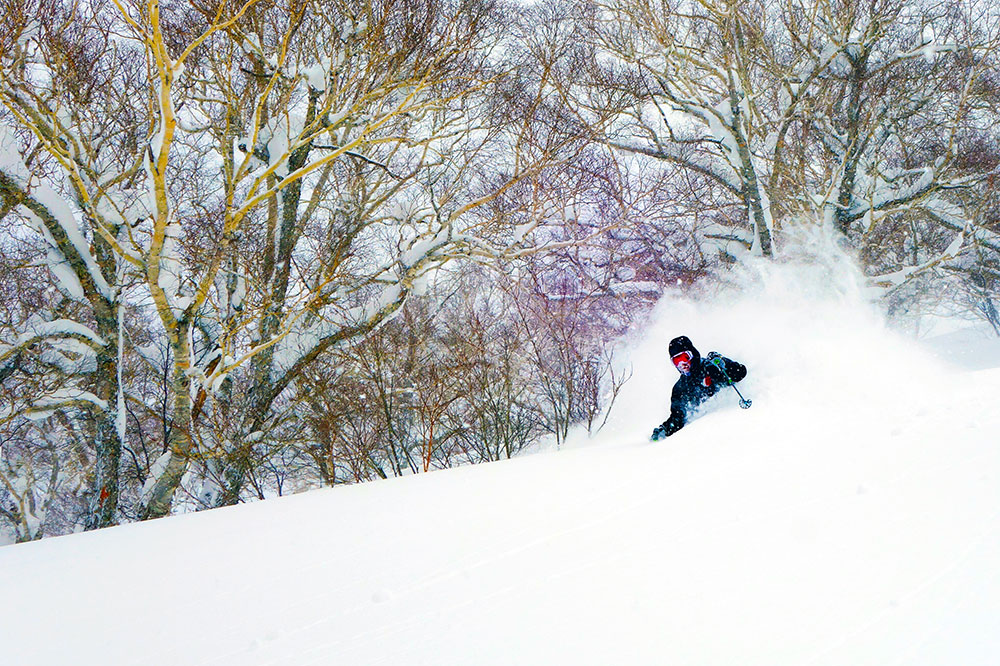
Eyes On
This is one of the techniques you should always seek to do. Keeping folks in visual contact not only allows you to know where to start a search if a rider is caught in a slide, but also aides in mitigating non-avalanche hazards like tree wells, deep snow immersion, or just getting lost.
Ease into the Slope
Rather than the first person hucking their meat off of the cornice in order to center punch the line, the first person on the slope should ease in. You should feel confident that the slope is safe in order to decide to ride it, but people often make the wrong decision. What’s wrong with being just a little more conservative when your life is on the line?
One At A Time
Only one person on the slope at a time hopefully means only one person is exposed to danger at a time. This only holds true, of course, if those not riding are actually stopped in safe zones.
Safe Zones
Safe zones are areas in terrain where you are protected from hazard. The top of a slope or ridgeline away from cornices where nothing can fall on you or break under you for instance. As much as possible, try to travel from safe zone to safe zone in terrain.
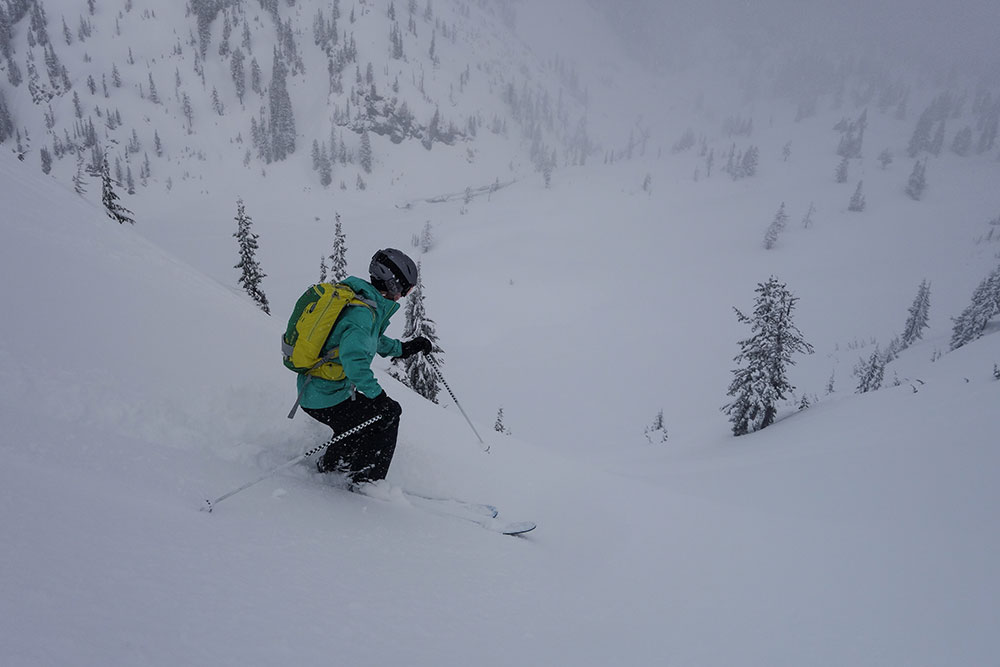
Fencing
Fencing is the technique of utilizing physical features on slopes (rocks, trees, and other terrain features) to create boundaries/constraints for riders. If you’re blessed with a blank canvas of untouched pow to ride, you can also use your own tracks for fencing (i.e “stay rider’s left of my track to avoid…” the cliff, crevasse, or other hazards).
Stacking Tracks
By stacking tracks, or spooning, you ensure that folks ride where they are supposed to. This reduces the chances of folks getting separated and lost or getting sucked towards a hazardous terrain feature that should be avoided. As an added bonus, you conserve more of the slope for your second lap or for the other humans that want to enjoy the pow. Sharing is caring.
Buddy System
This is great for when you aren’t concerned about avalanche hazard and are most concerned with getting separated (i.e. tight trees and whiteout conditions). By pairing up, you’ll at least be with one other human if you get separated from the group.
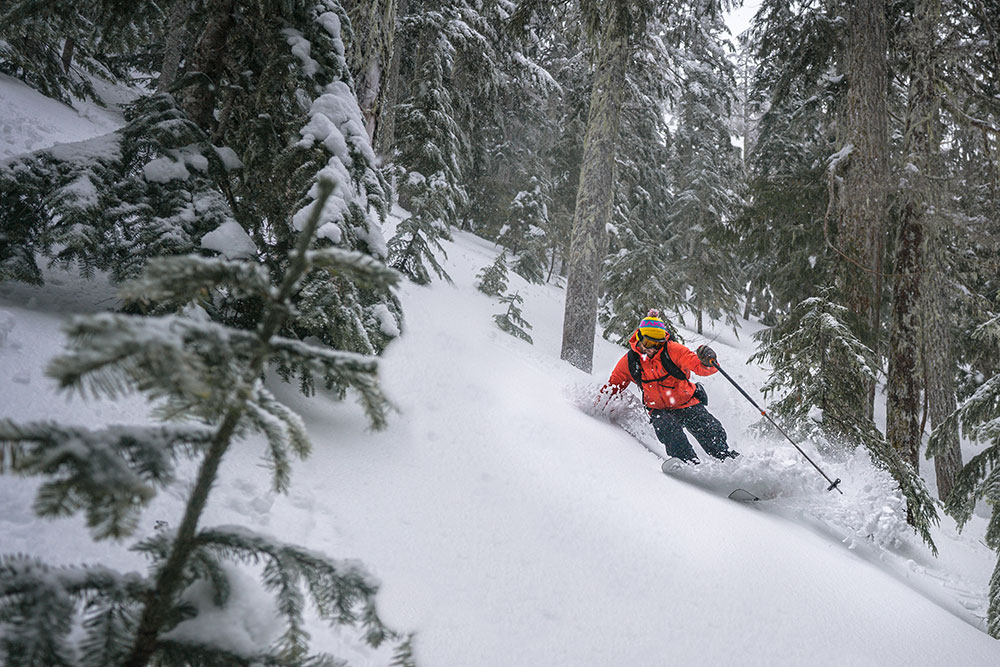
The “Yell-a-pillar”
Similar to the reasoning of the buddy system and the iron caterpillar. The “Yell-a-pillar” is where you try to ride closely together using your voices to make hoots and hollers so you know where folks are. For this technique, it’s great to stop often to ensure you haven’t lost anyone. Also, keep the person behind you in sight!
Short Pitches
In order to keep eyes on and the group together in challenging or complex terrain, it may be necessary to ride in short pitches rather than skiing something from top to bottom. Instead, ski from safe zone to safe zone.
Long Pitches
Sometimes you need to ski something in one long pitch because there’s no safe place to stop in the run. Think couloir or big alpine face. No matter how much your quads burns, keep skiing or riding!
Leap-frogging
This strategy is one you can use in place of short pitches to keep visual contact with your squad in rolly/benchy terrain. Rather than the entire squad stopping at the first convex roller where you would lose sight of them, only the first person stops. Then the next rider can ski a longer pitch as they continue past the first person to the next roller. This helps keep things flowing and allows the squad to ski longer pitches. This only works, of course, if there are clear stopping places and safe zones that folks know to regroup at.
Want to learn more? Check out our Ultimate Guide to Backcountry Skiing.
Human Factor in
Backcountry Skiing
Human Factor in Backcountry Skiing and Riding
The majority of avalanches catching people are triggered by the person skiing/riding or someone in their party. Though some of these incidents are the result of ignorance, the vast majority occur because the party involved made critical decisions based on human emotion and desire (The Human Factor) rather than facts and data. Below are some of the most common human factor traps that will lead you to make poor decisions when skiing or riding in the backcountry. Though there are many, we’ll go over six here that you can remember using the acronym FACETS.
Familiarity
“I’ve skied this 100 times. It never goes.”
Just because you’ve ridden something before and didn’t trigger an avalanche doesn’t make it safe. The mountain snowpack is constantly changing. Be familiar with the most recent conditions to make educated decisions.
Acceptance
“Hold my beer…”
In school, you heard this called “Peer Pressure”. As humans, we all want acceptance from our peers whether we admit it or not. That desire for acceptance can lead us to take more risks than we would normally.
Commitment
“We’ve got to get there.”
This is the pressure you feel to accomplish your Plan A when you don’t provide your squad with very good back-up options. For instance, if your plan is to ski Plan A or go home and clean your toilet (Plan B). You’ll choose Plan A every time. You’re committed to it. Instead, give yourselves several great options you’d all be happy riding. If you like all the options from Plan A (your most aggressive option) to Plan D (your least aggressive) you won’t feel as committed to Plan A.
Expert Halo
“I’m totally safe, I’m riding with an expert.”
Have you ever gone out with someone more experienced than yourself and let them make the decisions because you perceive them to have more expertise? We all have. This is the expert halo. Going out with experts is a great way to learn, but make sure you don’t just blindly follow along. Ask questions and be involved in the decision-making process. Experts make mistakes too.
Tracks
“Cool! Those two just rode ‘Sweet, Sweet Death!’ Should we ride it?”
Commonly folks assume that if there are tracks on the slope, it must be safe. This is not true. In level one courses, I always show the video below of seven riders riding down the same slope one at a time. Each rider spoons another’s tracks. Rider seven skis in between two other tracks, triggers an avalanche, and dies when they get carried into trees below. Though tough to watch, it illustrates the point here… tracks don’t mean a slope is safe. Pretend like they aren’t there and make your decisions based on the facts.
Scarcity
“Let’s hit it before someone steals our line!”
You’ll also hear this called “Mad Pow Disease”. Powder is a limited resource that only exists for a short amount of time. As backcountry skiers and riders, we love pow. Consequently, we can sometimes get pressured into riding a slope because we feel the need to take advantage of the scarce resource and make decisions quicker than we should so that we can ride the slope before anyone “steals our turns.”
FACETS
There you have it: FACETS. Six of the most common human factor traps for backcountry skiers and riders. Take note of which ones you are more susceptible to. Also, take note of which ones your friends are most susceptible to. Awareness of how you and your partners are affected by emotion will hopefully help you recognize when you’re straying from logic and allow you to call it out. Parents Take Note! The video below has some light profanity if you’re around little ones.
Want to learn more? Check out our Ultimate Guide to Backcountry Skiing.
Backcountry Skiing First Aid Kits
Backcountry Skiing First Aid Kits
Do you have the necessary tools to respond to an emergency in the backcountry? Do you have the medical training? Avalanche Rescue training? The more training I get and the more I know, the bigger my pack gets. Below is what I carry in my backcountry skiing first aid kit. Some items are essential items you should always carry in your kit, while others are situational, but always worth consideration. I’ve also included some items that are more rescue oriented than purely first aid.
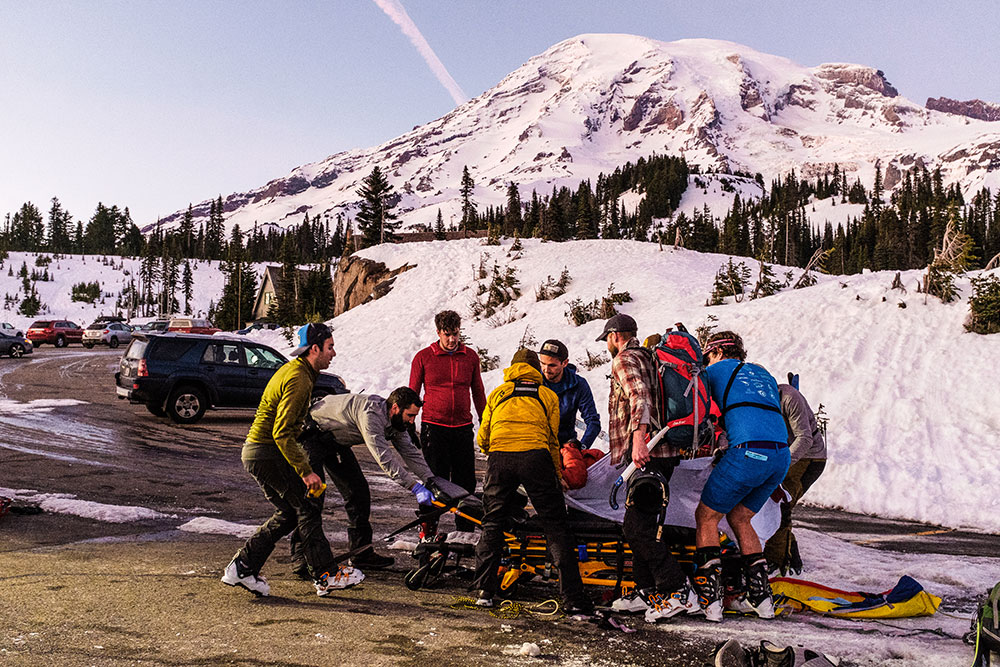
Blister/Burn Care
The most common injuries while touring in my experience? Blisters and sunburns. The key to treating these injuries is prevention. I carry:
– Moleskin
– Athletic Tape and PT Tape
– Tincture of benzoin (makes things sticky so they’ll stay)
– 2nd Skin
– Sun Screen (Ginger Strength or 30 SPF+)
Fractures and Dislocations
Skiing and riding allows you to get going pretty fast on the downhill. Broken bones (wrists and legs most commonly) and dislocations (shoulders and fingers) can be quite painful and scary if severe enough. I carry:
– Pain Relief (Acetaminophen and Ibuprofen taken together are just as effective as presecription pain killers and safer to take in most cases. 1000mg acetapminophen + 800mg IBU every 8 Hrs.
– Triangular bandage
– SAM Splint (Situational, I usually have other things like climbing skins and poles with me that can be used as a splint)
– Stuff to stop bleeding in case of an open fracture (see below)
– Rescue shelter/bivy/sled and inflatable pad(in case we need to wait for rescue or move to a safer location)

Cardiovascular
Whether you just take a fall, smack a tree or rock, or are caught in an avalanche, you’ll likely have some sort of trauma leading to bleeding. To plug those holes in the human container I carry:
– PPE – Gloves and Mask (Non-latex gloves)
– Tournaquet (For severe bleeds)
– Blood clot powder and gauze (For severe bleeds)
– ABD Pads and standard gauze pads
– Wound Closure Strips (For deep wounds requiring stitches)
– Trauma Shears or Knife (for exposing areas under clothing unable to be removed)
– Irrigation Syringe (for cleaning of wounds)
– Various sizes of band aids for the widdle boo boos
Hypothermia
Just being out in a winter environment warrants carrying equipment to keep warm, but, worst-case scenario, someone is caught in a large avalanche and buried in snow for a while or falls through a snow bridge into a crevasse. Once they get out, they’ll be cold if not hypothermic. I carry:
– Extra layers – Large gloves and puffy coat
– Rescue shelter/bivy and inflatable pad (Get someone off the snow and out of the elements)
– Stove and sleeping bag (For overnight expeditions I’ll have these items and have them in the squad as rescue gear)
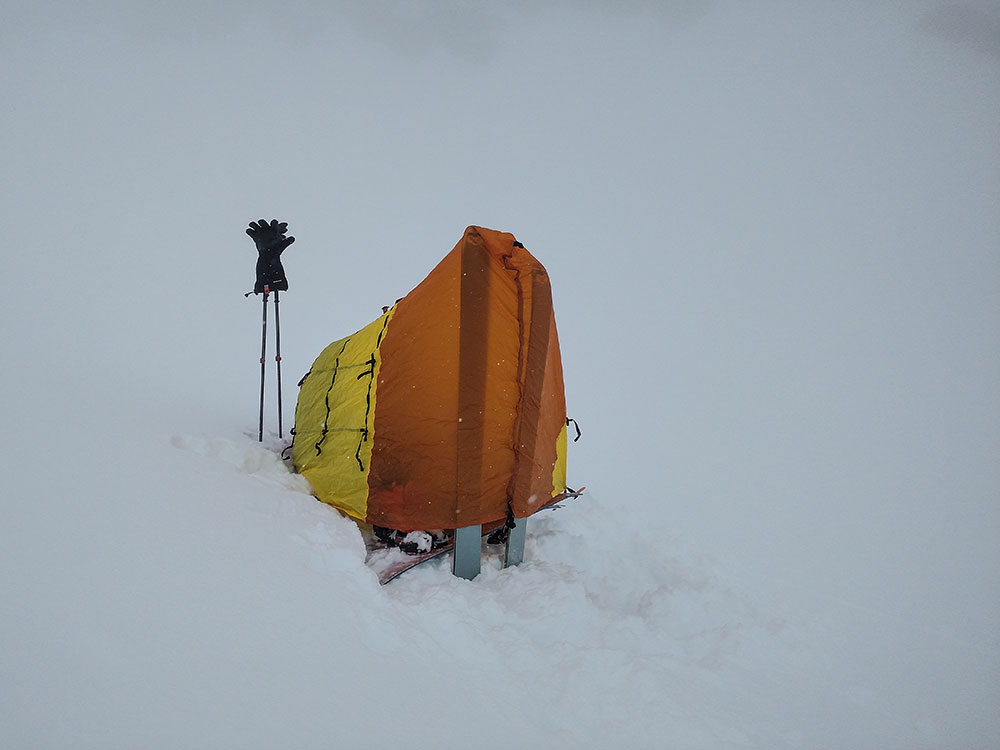
Drugs
As my father always says… “find your drug and find your dose.” Here are the essential drugs I’ve found helpful:
– Tylenol and Acetaminophen (Pain Relief)
– Aspirin (Pain/Swelling)
– Benedryl/Antihistamines (Allergic Reactions and Anaphylaxis)
– Diamox (For expeditions at high altitudes)
– Anti diarrheals (When you don’t want to poop anymore)
Building Your Backcountry Skiing First Aid Kit
Luckily for you, there are already a lot of great kits out there to choose from that are a lot more affordable than trying to entirely put together your own kit. Instead, I recommend getting a kit like those sold by Adventure Medical Kits that are ultra-light and waterproof and then supplement as needed.
Lastly, it’s important to remember that a first aid kit is only one part of your emergency gear/rescue kit. You should be well acquainted with Avalanche Rescue as well as how to administer first aid as a first responder to an incident. Get the gear, get the training, and then stay current on best practices. You’ll hopefully never need to use your knowledge or rescue kit, but, if 2020 is any indication… prepare for the worst. Shred safe friends.
Want to learn more? Check out our Ultimate Guide to Backcountry Skiing.
Back to TopRepair Kits for Backcountry Skiing
Repair Kits for Backcountry Skiing and Riding
Let’s layout a little scenario. You’re out for a long day tour in perfect pow conditions. To get away from the crowds, you push out pretty far into terrain and drop into a different drainage than the car is parked. On your run down, you take a tumble and rip out your toe piece.
Without a repair kit, what are your options? How long will it take you to crawl out? Is that even possible? People have died this way. The way to avoid (at the least) a very frustrating and slow evacuation out of the field is to invest in a quality repair kit that can fix most problems. If you put together your own kit, you’ll be surprised how modest a financial investment it is. There are some quality repair kits pre-built out there now by Traverse Equipment for $90 if you want to go that route.
Below is a breakdown of the everyday essentials you should always have, other items to consider bringing and multi-day specific items.
The Everyday Essentials
Depending on how long of a backcountry tour you plan to go on, your repair kit should adapt accordingly. Are you going out overnight or for multiple nights? Your kit will be much more inclusive than for just a short day tour near a ski area. No matter how long your tour, here are some essential items to always have with you.
Spare Batteries
Most avalanche beacons and headlamps take triple A. Bring three of them.
Pro Tip: Wrap a piece of tape around the three batteries to keep them together so you’re not fishing around for three individual batteries.
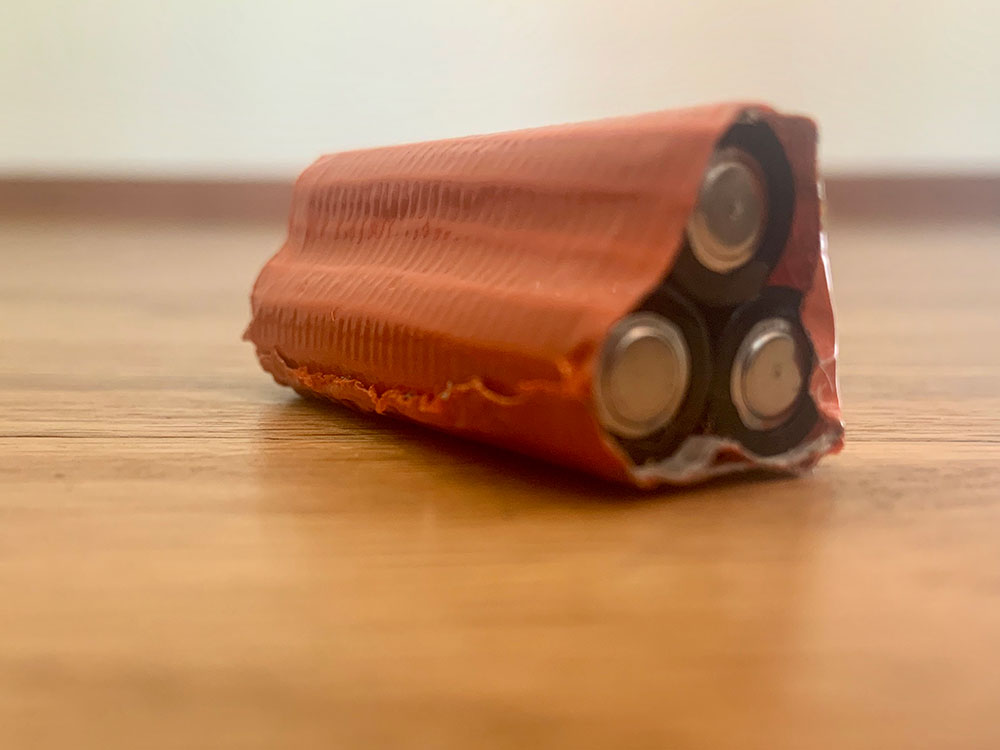
Knife
Sometimes you’ll just need to cut something. Worst case is an emergency where someone has major trauma and you need to expose something buried beneath a lot of different layers. You might need to cut some clothing off. More likely, you’ll need the knife for cutting that spare p-cord to the appropriate length or your block of cheese. Regardless, carry one.
Multi-Tool With Pliers
This multi-tool could also be your knife as long as it’s actually a good one. Pliers are great for grabbing metal parts, which will be quite cold out there in the snow. It should also have some different bits (Phillips and straight at a minimum) so you can tighten loose screws on boots or bindings. Bonus is wire cutting capabilities.
Pro Tip: Keep this in an accessible pocket rather than in your repair kit. You don’t always have to have all items of your repair kit inside the same bag.
Ski Straps
So many applications. I carry three at all times. Break a buckle or tensioning strap on your boot? Ski Strap. Skins falling off your skis or lose a tail clip? Ski Strap.
Pro Tip: Store two rolled up in your repair kit and keep one accessible either rolled on your ski pole or in a pocket that is easily accessible.
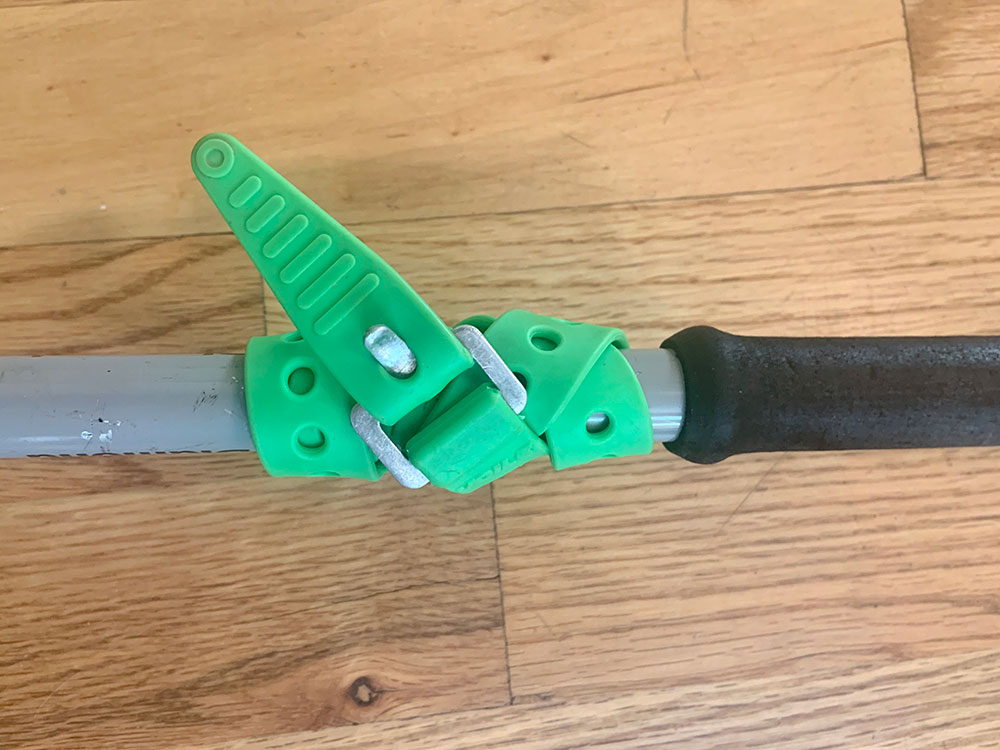
Spare Screws
These should be specific to your boots or bindings. If the screw that holds your walk-ride lock falls out, have fun riding downhill in a sloppy boot.
Pro Tip: If you are a splitboarder, make sure the screws on your binding are tight before each run. Most splitboard bindings have a lot of moving parts, which leads to screws and straps loosening throughout the day. Avoid having to use your spare screws by tightening them proactively!
Extra Powder Basket
Poles are useless in snow without powder baskets. Just carry a spare in case you lose one.
Extra Climbing Skin Tail Clip
You can use a ski strap to keep a climbing skin on a board, but these tend to get scraped off as you walk and can be annoying since they affect glide. It’s way better to just have a spare clip.
Scraper
Snow adhering to your climbing skins? Scrape it off. Snow or ice building up on the bottoms or tops of your boards? Scraper. Can’t get your binding to lock in the right place because there’s too much snow? Scrape it!
Other Items to Consider
Pole Repair
If you take a tumble and snap a ski pole, it’s nice to be able to repair the pole to at least make it usable to get out. With two small hose clamps you can simply clamp the broken pieces together with a little overlap.
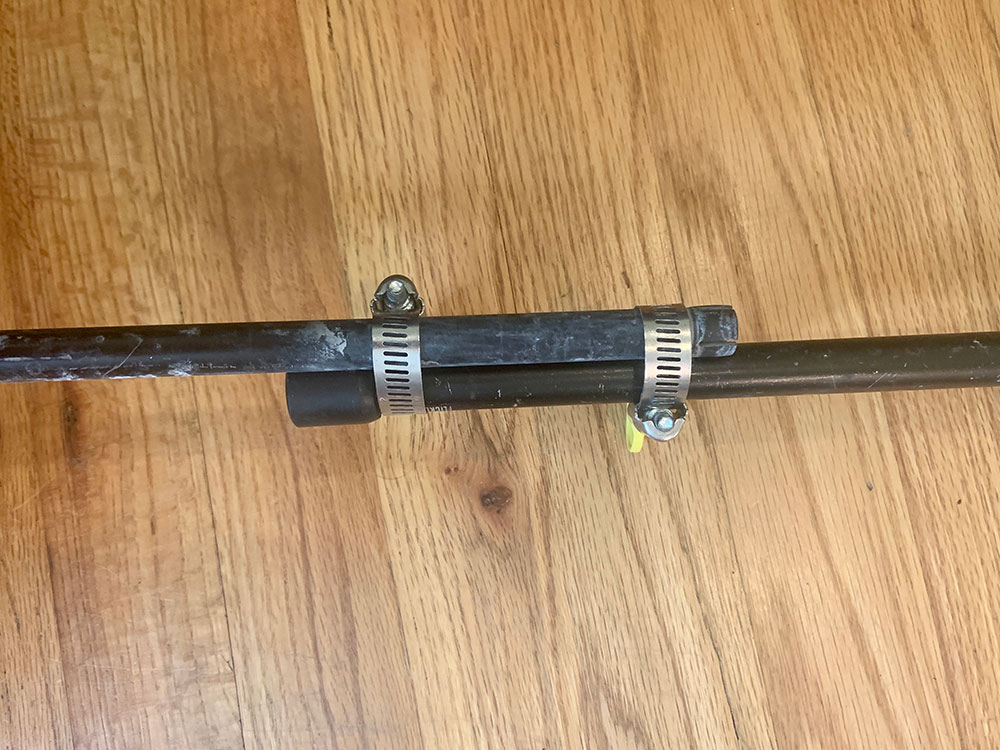
Tape
Duct Tape is classic, but leaves behind a nasty residue once removed and doesn’t adhere to all fabric types. I recommend Tenacious Tape from Gear Aid. I’ve had clothing patches survive multiple years going through the wash. Strong stuff from an awesome local company.
Paracord
Multi-Use similar to ski-straps, but smaller, lighter, and can be cut to any length.
Pro Tip: cauterize the cut end with a lighter to keep it from unraveling!
Lighter
For cauterizing that paracord you just cut, lighting your stove, or creating that fire in a survival scenario.
Binding Buddy
Lots of manufacturers sell cheap but effective multi-tools that get most jobs done if you’re not wanting to drop for a nicer multi-tool just yet.
Glop Stopper Wax
Definitely a nice item to carry in the springtime anywhere, but year-round if you ride in a warmer/wetter climate like the Pacific Northwest. Glop Stopper Wax keeps snow from adhering to the bottoms of your climbing skins. If you’ve ever been out after a fresh dump of snow and then had that snow become sticky risers under your feet, you know the humongous pain that is. It can immobilize you.
Pro Tip: apply it before you actually need it. Once your skins get wet and already have snow sticking to them, it’s tough to retroactively put on the wax. Pay attention to changing conditions and apply glop stopper proactively.
Large Hose Clamp
If you rip out a toe piece on a binding, a large enough hose clamp can fit over the ski and boot to clamp the boot to the ski like a big, dumb snowshoe. This only works, however, if the ski boot has a buckle near the toe to keep the clamp from sliding off the boot as you walk.
Baling Wire
Lightweight multi-use material just like paracord except you don’t need a lighter. You do, however, need wire cutters in your multi-tool if you’re going to bring it.
Storage Bag for Kit
Have a nice compact bag that’s just large enough to accommodate your repair kit items. Preferably this bag is waterproof to keep your metal bits from rusting. Ensuring that you pull out and dry out any items that get wet will protect from rust as well.
Pro Tip: Use a Dynafit Ski Crampon Bag for your repair kit. The clear plastic side is great for visually spotting where the item you need resides. Plus, it’s durable.
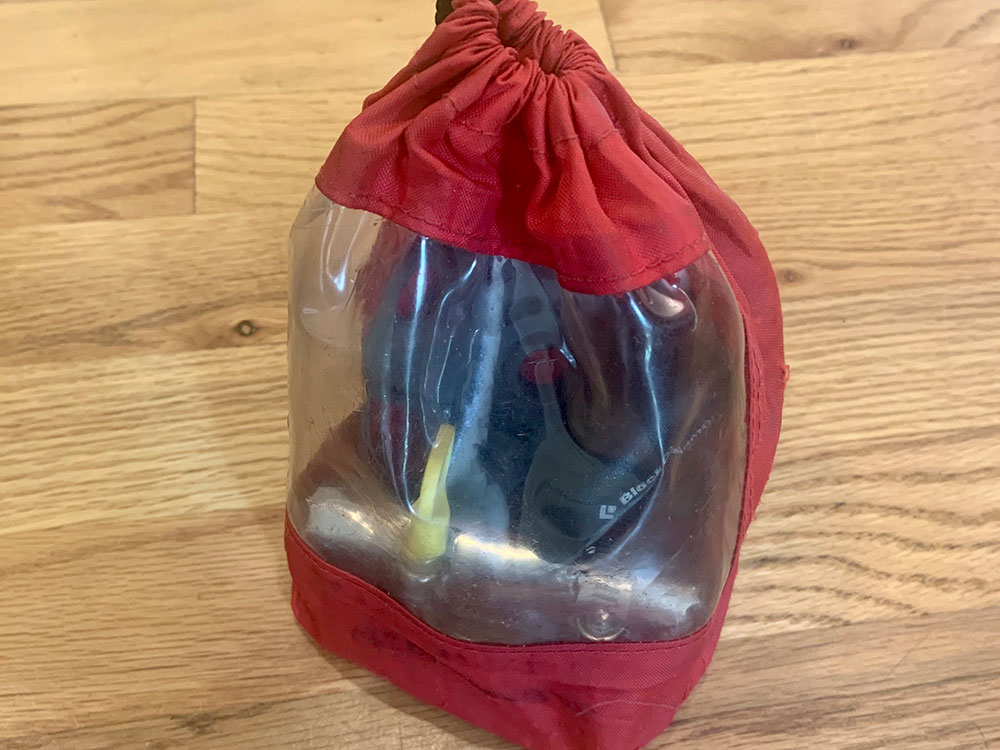
Multi-Day Specific
Spare Headlamp
Having a headlamp die can shut down your aspirations for that awesome line you hiked so far into the backcountry to ride. It’s also one of those emergency items that you should always have on you in case your day is way longer than you expected.
Stove Parts
If you’re going out for a multi-day trip, you’ll likely have a stove. Don’t forget to carry spare “o” rings and other items that are stove specific so you can repair whatever issue your stove has in the field. Often melting snow is how you’ll get water in the winter and not having a working stove can be a big safety concern.
Sewing Kit
For three day+ trips (like a traverse) consider bringing a sewing kit to be able to more permanently repair gear rather than the slap and play of tape.
Zipper Repair Kit
Blowing a zipper on a key piece of clothing or, if you’re using a tent, your shelter door is a huge bummer. Rather than poking holes in your items with safety pins to keep them shut, consider bringing a zipper repair kit to fix the issue.
Ripped Toe Piece Repair
On longer multi-day trips a long way from home, it’s nice to know that you can secure back on your toe piece if it completely rips out. Ski straps, baling wire, paracord, and your big hose clamps will do in the short term but require constant management and adjustment. This is a way to reattach your toe piece permanently in order to get out of the field. Take Note: This will destroy your ski, but it’s probably destroyed anyway.
You’ll need:
Socket wrench with Phillips bit and 1/8″ drill bit.
3-4 bolts 1/4″ or smaller that fit through the screw attachment points on your binding toe piece.
3-4 lock nuts and washers that match the size of your bolts.

Using the socket wrench and drill bit, drill completely through the ski using the holes where your binding toe piece ripped out. Widen the holes if necessary in order to accommodate your bolts.
Pound the lock nuts into the bottom of your ski.
With a washer on the bolts, screw them through the toe piece and into the lock nuts on the other side of the ski. You’ll likely only need three bolts even if you have four screws in your binding. They won’t be coming out.
Cut off or repeatedly bend the excess bolts with pliers in order to break them off flush with the bottom of your ski. You’re back in business.
Final Thoughts
What you carry in your repair kit should be specific for you and your squad, but should contain at the very least the essentials above. Remember that not everyone in your team needs a full repair kit if you coordinate well, but make it a part of the group gear you always bring.
Like what you learned here? Check out our Ultimate Guide to Backcountry Skiing to get more quality educational content.
Avalanche Problems
The Nine Avalanche Problems Explained
Not all avalanches are the same. This post teaches you about the nine different Avalanche Problems you could encounter any given day while out in the backcountry. To get the most out of this post, you should first have a basic understanding of the North American Avalanche Danger Scale.
Avalanche Problems are defined by four major elements, the Avalanche Character, Location the avalanche can be found in terrain, the Likelihood of triggering, and the Size (how big it will be).
Avalanche Character
In order to communicate the distinct personalities of avalanches, experts identified nine distinct problem types:
Loose Dry | Loose Wet | Wind Slab | Storm Slab | Persistent Slab | Deep Persistent Slab | Wet Slab | Glide | Cornice Fall

Dry Loose Avalanches
Dry Loose avalanches are the release of dry unconsolidated snow and typically occur within layers of soft snow near the surface of the snowpack. These avalanches start at a point and entrain snow as they move downhill, forming a fan-shaped avalanche. Other names for loose dry avalanches include point-release avalanches or sluffs.
Back to TopWet Loose Avalanches
Wet Loose avalanches are the release of wet unconsolidated snow or slush. These avalanches typically occur within layers of wet snow near the surface of the snowpack, but they may gouge into lower snowpack layers. Like Loose Dry Avalanches, they start at a point and entrain snow as they move downhill, forming a fan-shaped avalanche. Other names for loose-wet avalanches include point-release avalanches or sluffs. Loose Wet avalanches can trigger slab avalanches that break into deeper snow layers.
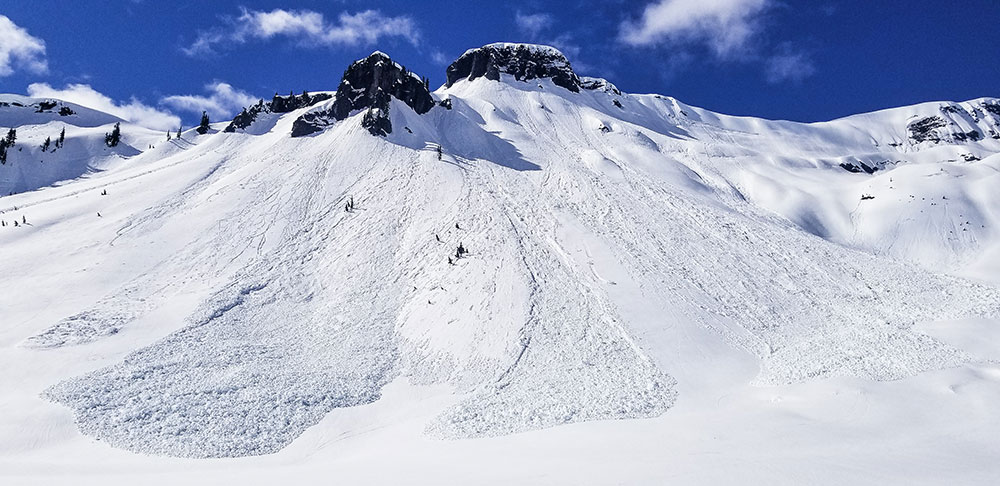
Wind Slab Avalanche
Wind Slab avalanches are the release of a cohesive layer of snow (a slab) formed by the wind. The wind typically transports snow from the upwind sides of terrain features and deposits snow on the downwind side. Often, wind slabs are smooth and rounded and sometimes sound hollow. They can range from soft to hard. Wind slabs that form over a persistent weak layer (surface hoar, depth hoar, or near-surface facets) may be termed Persistent Slabs or may develop into Persistent Slabs.
Back to TopStorm Slab Avalanche
Storm Slab avalanches are the release of a cohesive slab of new snow that breaks within new snow or on the old snow surface. They typically last between a few hours and a few days (following snowfall). Storm-slabs that form over a persistent weak layer (surface hoar, depth hoar, or near-surface facets) may be termed Persistent Slabs or may develop into Persistent Slabs.
Back to TopPersistent Slab Avalanche
Persistent Slab avalanches are the release of a slab in the middle to upper snowpack when the bond to an underlying persistent weak layer breaks. Common persistent layers include surface hoar, depth hoar, near-surface facets, or faceted snow. These layers can continue to produce avalanches for days, weeks or even months, making them especially dangerous and tricky. As additional snow and wind events build a thicker slab on top of the persistent weak layer, this avalanche problem may develop into a Deep Persistent Slab.
Back to TopDeep Persistent Slab Avalanche
Deep Persistent Slab avalanches are the release of a thick hard slab when the bond breaks between the slab and an underlying persistent weak layer deep in the snowpack. The most common persistent weak layers involved in deep, persistent slabs are depth hoar or facets surrounding a deeply buried crust. Deep Persistent Slabs are typically hard to trigger and are very destructive due to the large mass of snow involved. They can persist for months once developed and are often triggered from areas where the snow is shallow and weak. Deep Persistent Slabs are particularly difficult to forecast for and manage.
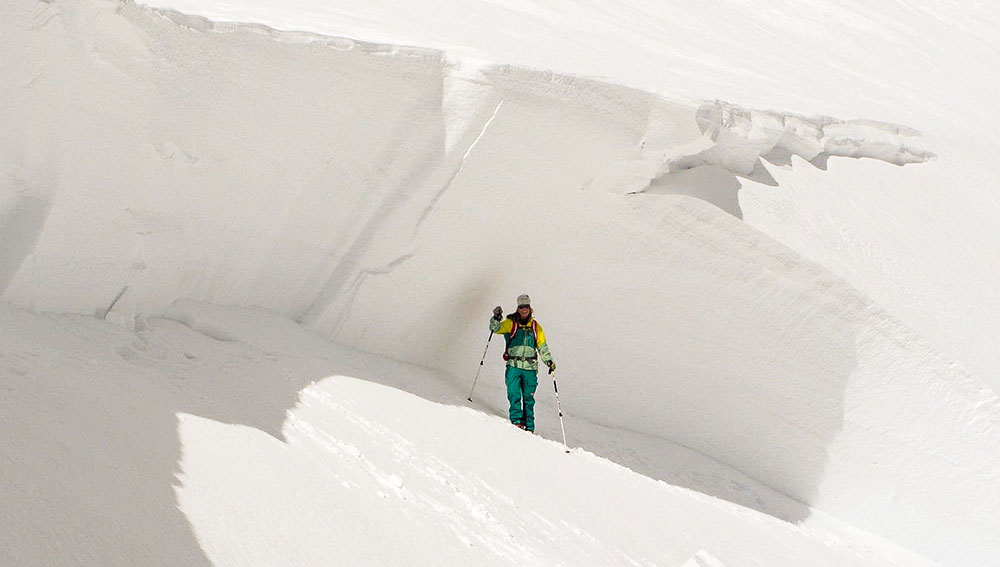
Take Note: The main difference between a persistent slab and deep persistent slab is depth. Deep Slabs break on a layer over a meter down in the snowpack. Because of the difficulty in triggering and larger consequence of a deep slab, they are broken out as separate problems.
Back to TopWet Slab Avalanche
Wet Slab avalanches are the release of a slab that is generally moist or wet. They occur when the flow of liquid water weakens the bond between the slab and the surface below. They often occur during prolonged warming events and/or rain-on-snow events. Wet Slabs can be very unpredictable and destructive.
Back to TopGlide Avalanche
Glide Avalanches are the release of the entire snow cover as a result of gliding over the ground. They can be composed of wet, moist, or almost entirely dry snow. Typically, they occur in very specific paths, where the slope is steep enough and the ground surface is relatively smooth. They are often preceded by glide cracks (“the brown frown”). The time between the appearance of a glide crack and an avalanche can vary between seconds and months. Glide avalanches are unlikely to be triggered by a person, so they are nearly impossible to forecast. Consequently, they pose a hazard that is extremely difficult to manage.
Back to TopCornice Fall Avalanche
Cornice Fall is the release of an overhanging mass of snow. Cornices form as the wind moves snow over a sharp terrain feature (like a ridge) and deposits snow on the downwind (leeward) side. They range in size from small wind drifts of soft snow to large overhangs of hard snow that are 30 feet (10 meters) or taller, and can break off the terrain suddenly. Often, they pull back onto the ridge top and catch people by surprise even on the flat ground above the slope. Even small cornices can have enough mass to be destructive and deadly. Cornice Fall can entrain loose surface snow or trigger slab avalanches.
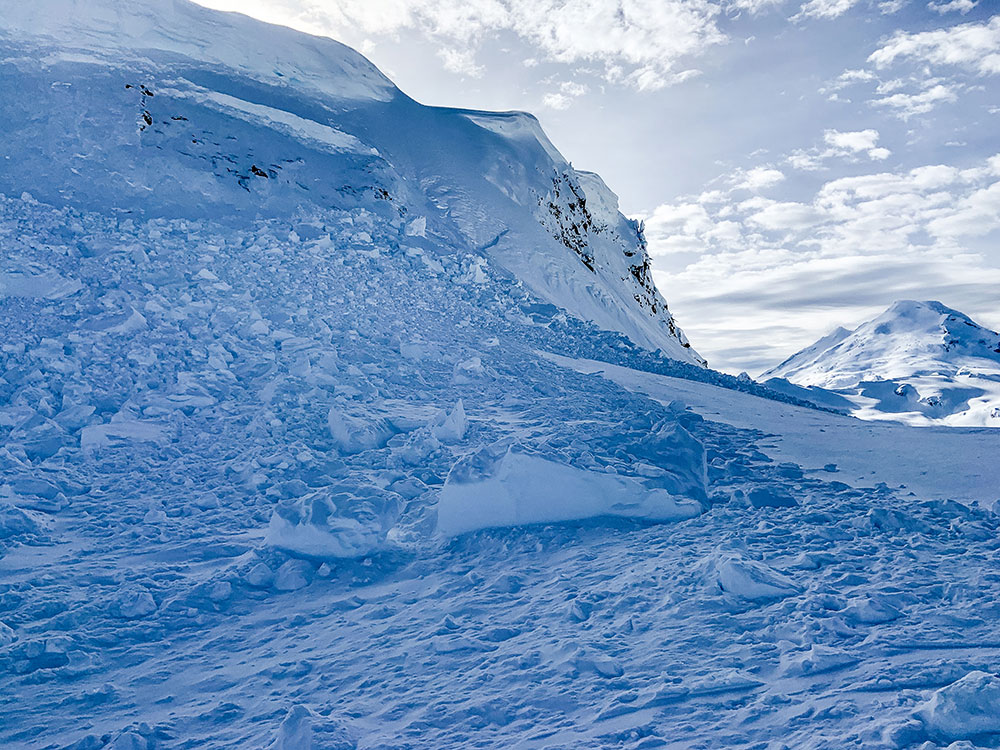 Back to Top
Back to Top
Location
Where avalanches can be found is broken out into three elevation bands: Below Tree Line, Near Treeline, or Above Treeline. From there, it can get more specific as Aspects (N-S-E-W) can also be conveyed.
Below Treeline (BTL) is the elevation band of a mountain or range that is covered by forest. From its upper to lower limits, it often covers the greatest area and the greatest variation in snowpack conditions of any elevation band. These areas usually see less sun, wind, cold, and precipitation than higher elevation bands.
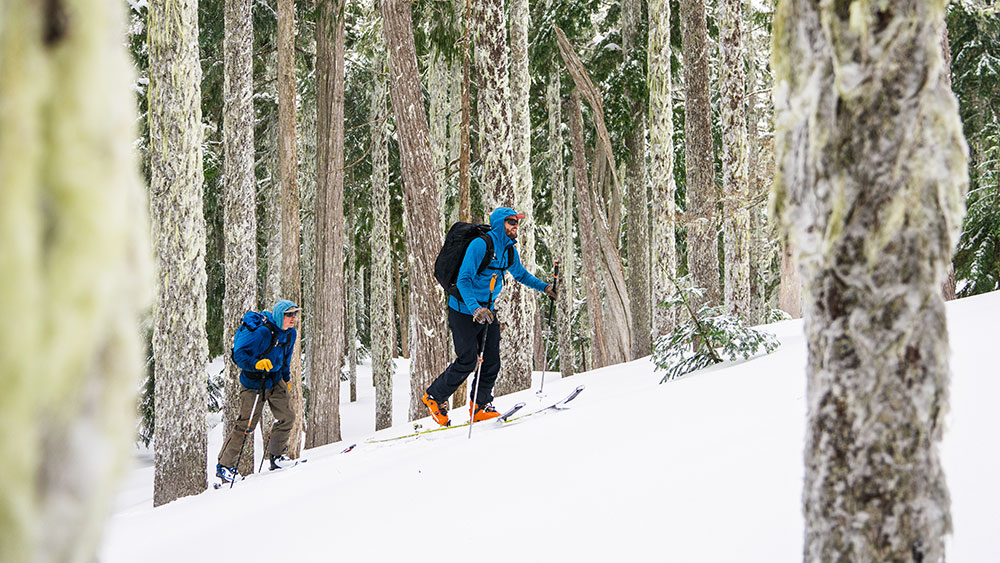
Near Treeline (NTL) elevation is characterized by sparse forest cover and is the transition between uniform forest cover below it and the alpine above it. These areas are distinct for sharing features of both alpine and below treeline elevations. Exposure to sun, wind, cold, and precipitation is generally less here than in the alpine but greater than below treeline.
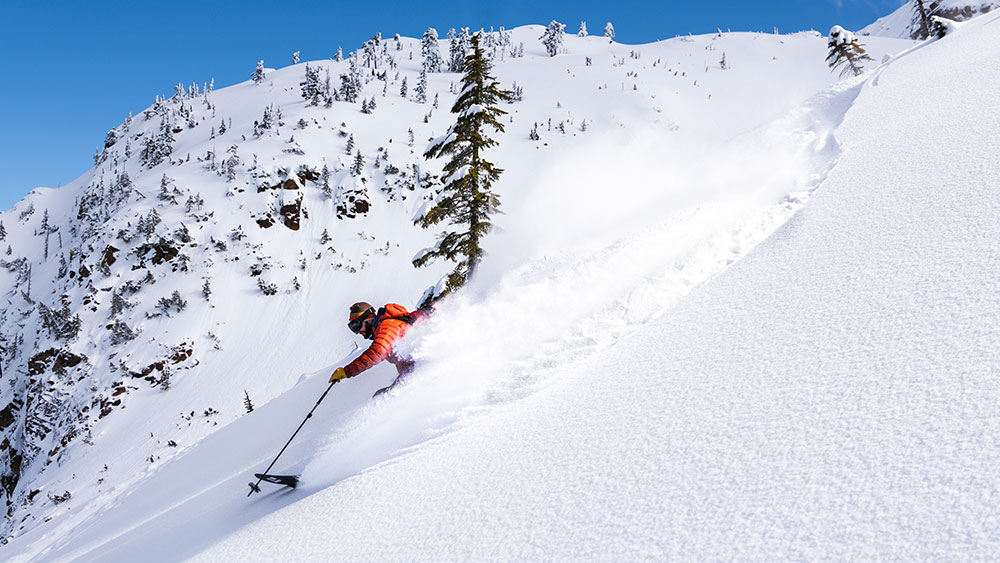
Above Treeline (ATL) consists of wide expanses of open, exposed terrain with few or no trees. Where it exists, it is the highest elevation band of a mountain or range. Not all mountains have above treeline terrain, but it may be the dominant terrain in other mountains or ranges. This elevation is usually the most exposed to sun, wind, cold, and precipitation.
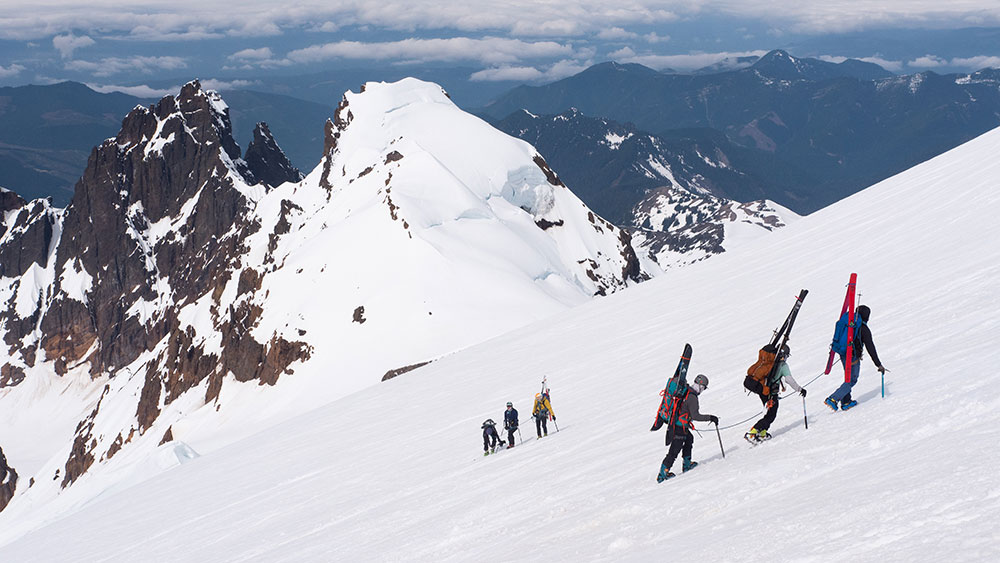
The lower extent of the alpine elevation band is highly variable. It transitions to the NTL elevation band where vegetation, especially trees, overcomes the more open and rocky terrain of the alpine.
Back to TopLikelihood
Likelihood is a description of the chance of encountering a particular Avalanche Problem. It combines the spatial distribution of the Problem and the sensitivity or ease of triggering an avalanche. The spatial distribution indicates how likely you are to encounter the Problem in the highlighted avalanche terrain. The sensitivity indicates how easy it is to trigger avalanches including both natural and human triggered avalanches.
Likelihood is broken down into five categories with Unlikely at the bottom and Almost Certain at the top. In between is Possible, Likely, and Very Likely. Photo below by Grant Gunderson.
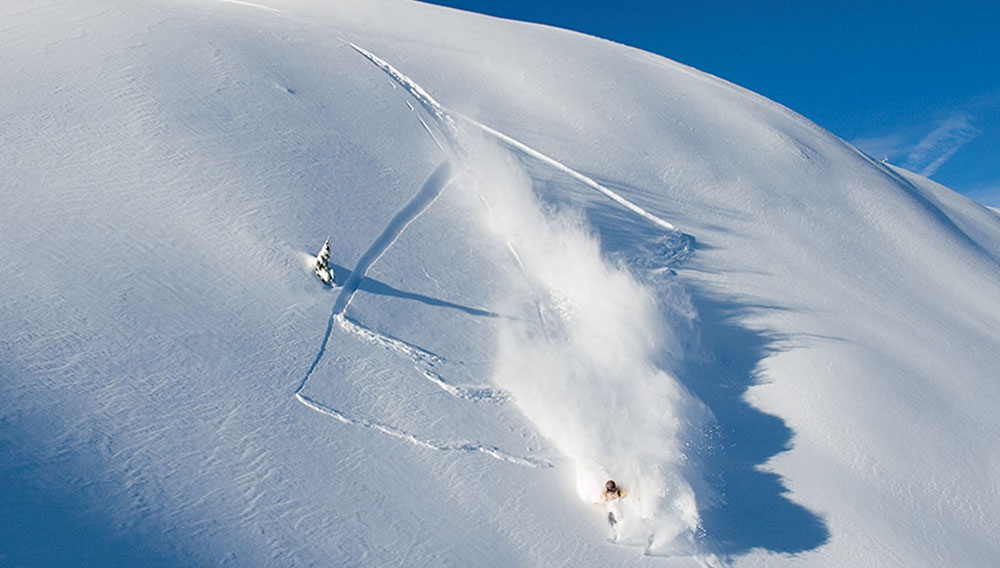 Back to Top
Back to Top
Size
Size is based on the destructive potential of avalanches.
SMALL avalanches are relatively harmless to people unless they push you into a terrain trap.
LARGE avalanches could bury, injure or kill a person.
VERY LARGE avalanches could bury cars, destroy a house, or break trees.
HISTORIC avalanches are even more destructive, and nearing the maximum size the slope could produce.
Back to TopTo Summarize…
The video below does a good job of putting everything together into the bigger picture. Understanding the nuance of where these different avalanche problems live in terrain on any given day takes lots of practice. Take an Avalanche Course to learn more about avalanches and how to avoid them.
Want to learn more? Check out our Ultimate Guide to Backcountry Skiing.
Back to TopAvalanche Beacon
Function Check
How To Do An Avalanche Beacon Function Check
When going out backcountry skiing or riding, one should always do an avalanche beacon function check to ensure everyone is searchable and able to search. Below is a great video created by three IFMGA Guides on how to do a simple and concise avalanche beacon function check.
3 Part Check
1. Battery and Display
Margaret has Mark and Jeff turn on their avalanche beacons, check their displays for any cracks or malfunctions, and then verbally read out their battery percentage.
2. Search Function
Margaret has Mark and Jeff switch their beacons to Search mode (while she stays in Send) and take a step or two back. Then she has them read out their numbers on the digital display to ensure that their numbers go down as she moves her beacon closer.
3. Send Function (Transmit)
Jeff and Mark switch back to Send and stow their beacons appropriately (in the provided harness and below a layer or in a pocket) and at least 30cm (1 foot) away from any other electronic devices like a cell phone. Then she switches to Search and confirms that she can get their individual signals. Margaret then goes back to Send mode and stows her beacon appropriately. “End in Send.”
DBEST Function Check
If you’re an acronym person you can use DBEST in order to remember all the parts of a beacon function check.
Display – is not cracked and working appropriately.
Battery – is at least over 50% or per manufacturers recommendation.
Electronics – are at least 30cm away in Send mode and 50cm away in Search
Search – Everyone is able to find a signal transmitting at the international standard of 457kHz.
Transmit – Everyone is producing a signal at 457kHz.
Do It Every Time
There you have it. Just make sure you do this before you leave the parking lot or TH so you can troubleshoot any issues before you’re in the backcountry. Curious about how to actually use your beacon to perform an avalanche rescue? Check out our blog on Single Burial Avalanche Rescue. Taking an Avalanche Rescue or AIARE Level 1 Course are great ways to get hands-on knowledge and mentorship from professionals.
Want to learn more online? Check out our Ultimate Guide to Backcountry Skiing.
Winter Backcountry Trail Etiquette
The 10 Commandments of Winter Backcountry Trail Etiquette
Say you’re going up an established skin track and a group of bandit snow-shoers are descending upon you like an unruly pack of cackling cayotes clutching White Claws. Who has the right of way? How can you engage with other backcountry users in a respectful way that benefits everyone? This guide provides travelers with 10 rules of backcountry trail etiquette in the winter so you can make respectful and responsible decisions.
Skin Track vs Boot Pack
“1. Thou Shalt Not Walk in the Skin Track.”
This is one of the most commonly broken rules in the backcountry during the winter. There’s not much more frustrating as a skier or splitboarder than having a beautifully sculpted skin track plunge stepped out by someone post-holing — especially in snowshoes. Yes, it’s easier to walk in the skin track than break your own trail, but the person that created the skin track worked hard to make that track and someone walking in it destroys that work. Instead, break your own trail!
Putting In The Track
“2. Thou Shalt Not Create a Track That is Dangerous or Dumb.”
Up tracks should be put in a place that is out of avalanche terrain. Exceptions to this being when you’re climbing a steep couloir or other objectives that you’ve hopefully evaluated carefully. For skiers and riders, don’t make the skin track too steep. Doing so forces those behind you to create their own track — eating up more of the precious pow you hope to ride. Also, the track should ideally not go up the gut of the down track, or run you plan to ski/ride.
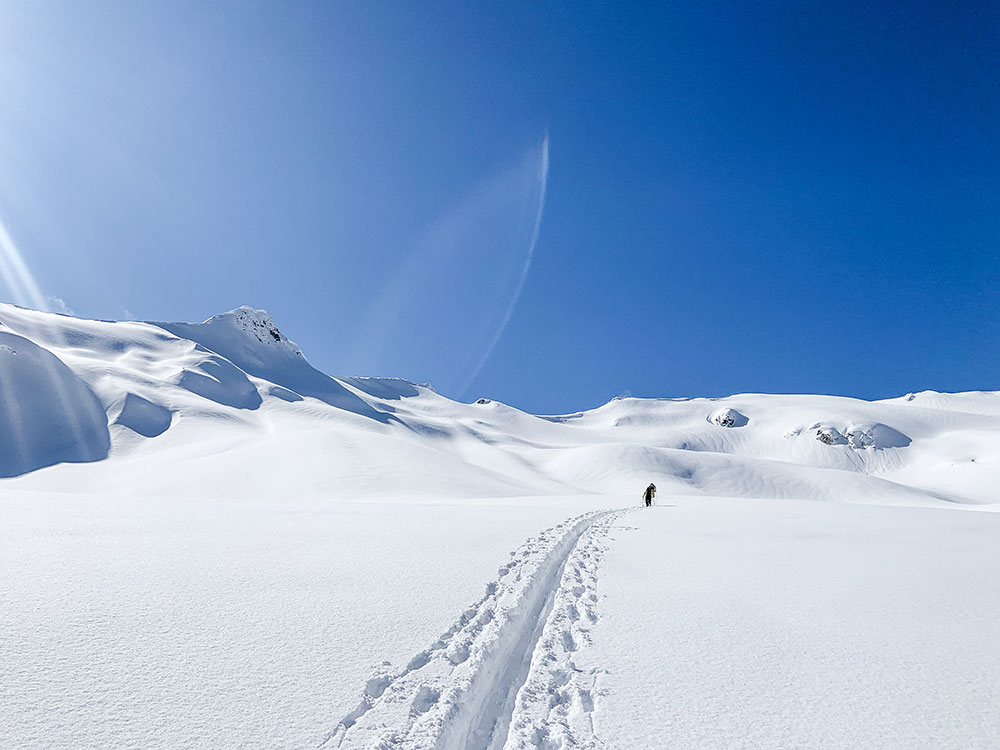
Use Established Trails
“3. Thou Shalt Use the Existing Track Unless it is Dangerous or Dumb.”
It’s common and desirable for skiers and riders to utilize the same skin track multiple times in a day. If a skin track is destroyed by post-holing or folks riding over it, then the skiers and riders must create a new skin track. In crowded multi-use zones like the Baker Backcountry going up to Artist Point, it’s common to see a dozen different tracks going across a slope. In a perfect world, there should be three tracks in areas like this: A skin track, an up-track for booting/snowshoes, and a down-track for booting/snowshoes. Use the existing track unless it conflicts with the two previous rules.
Right of Way
“4. Thou Shalt Yield to Uphill Travelers.”
Uphill has the right of way. Stand aside for those coming up the track so they don’t lose their momentum. Of course, some folks will decide to take a break and love to use folks coming down as an excuse to take a breather. Great, but make the assumption that folks want to keep walking up, step to the side, and communicate.
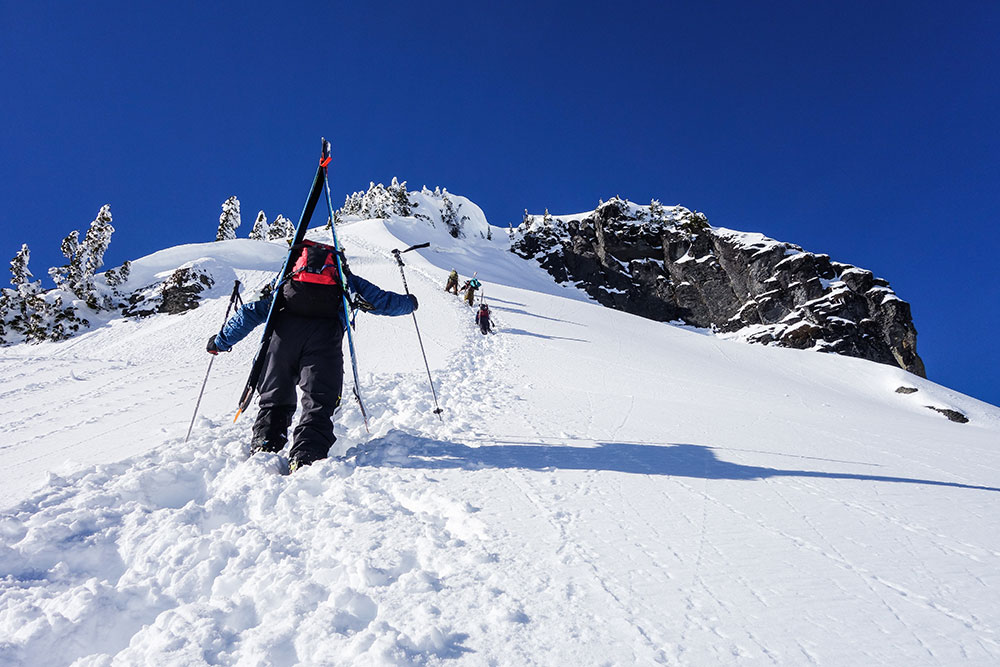
Be Nice
“5. Thou Shalt Play Well With Others.”
An often overlooked part of Leave No Trace is: Respect Other Users. The backcountry is increasingly a crowded place in the winter. Snowmobiles, climbers, hikers, and backcountry skiers/riders might all be using the same terrain for different purposes. No one has more of a right to the land than anybody else. So be nice. If folks are breaking the above rules, don’t freak out on them, they likely just don’t know. Instead, take the time to ask them how their day is going, build a little rapport, then, if it feels right, educate them politely.
Dogs In The Backcountry
“6. Thou Shalt Use a Leash”
Unless you are in a designated leash off zone, keep your canine companion leashed at all times. You may love your dog, but don’t assume everyone does. In addition, any wildlife you’d encounter definitely won’t like your dog and the added stress it provides.
Waste In The Backcountry
“7. Thou Shalt Pick Up Poop and Trash”
No one likes coming across poop when they’re outside trying to get away from the poop in their everyday life. Pick it up, bag it, and pack it out if it’s yours or your canine companion. The same goes for garbage like candy wrappers.
Trail Closures
“8. Thou Shalt Respect Trail Closures”
If a trail or area is closed, respect the closure. In the winter, the Department of Transportation, ski patrol at ski areas, and mechanized backcountry skiing/riding operations routinely close areas for avalanche mitigation or put up barriers to keep you out of hazardous terrain. Don’t get caught in a slide because you ducked a rope.
Wildlife
“9. Thou Shalt Not Feed The Wildlife”
As cute as they are, and as cool as the picture would be, don’t feed the animals. Animals have their own survival methods in the winter evolved over thousands of years. They don’t need you to feed them your raisins, in fact, you might just be killing them by doing so. If animals learn that humans are a food source, they will abandon their normal foraging behaviors for the easier handouts humans provide. Once an animal is dependent on humans for food, they get increasingly aggressive towards humans. Respect wildlife by keeping your distance.
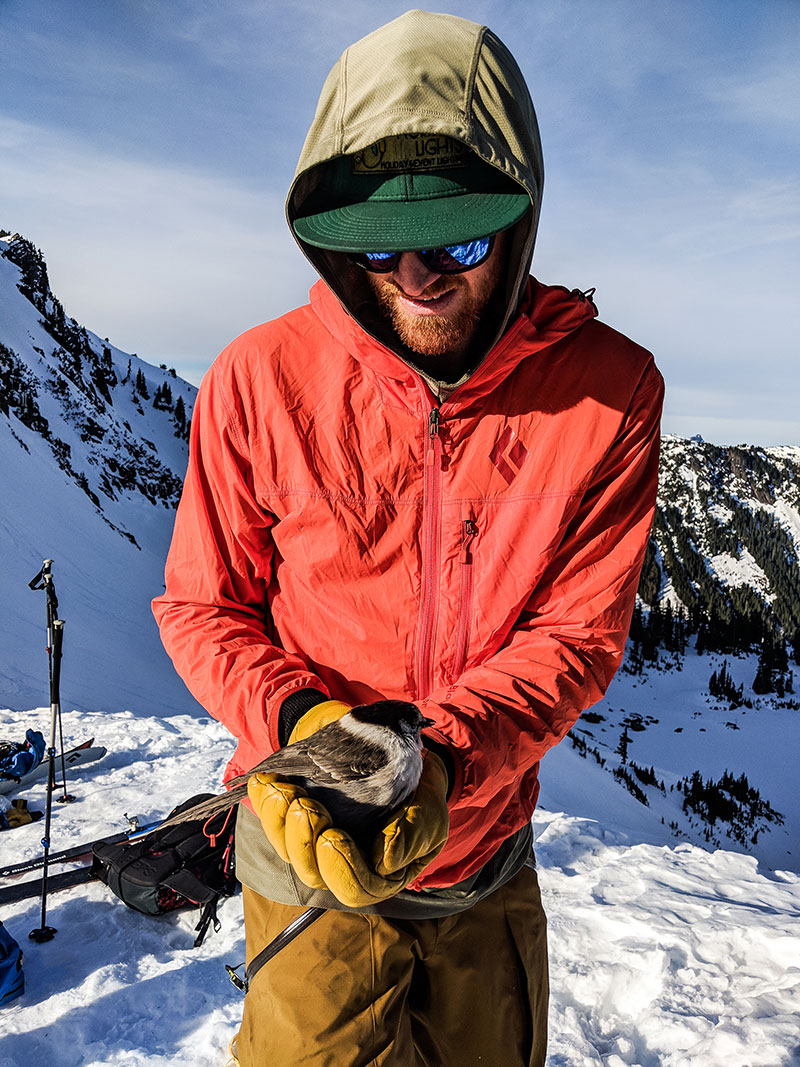
Emergencies
“10. Thou Shalt Help In An Emergency”
If you witness an avalanche or medical emergency in the backcountry, provide aid as long as it is safe for you to do so. If responding to an avalanche burial, this means paying attention to hang fire or parts of the slope that could still slide. Don’t become a victim yourself. Even if you don’t have a bunch of knowledge, offer to help and ask what you can do.
Want to learn more? Check out our Ultimate Guide to Backcountry Skiing.